THE DISCOVERY OF AMERICA

THE PARSONS COLLECTION
THE PARSONS COLLECTION THE DISCOVERY OF AMERICA Peter Harrington london IN ASSOCIATION WITH 409 temple street new haven connecticut 06511 (203) 789-8081 amorder@reeseco.com William Reese Company

R. David Parsons (1939-2014)
A dedicated and virtuoso collector, who studied and loved his books
It is an honour and a great pleasure for this group of four specialist dealers from different parts of the world to offer for sale the remaining books of a renowned collector, David Parsons, who passed away unexpectedly in 2014.
Born in Liverpool, England, and an Oxford MA, David moved to Atlanta, Georgia, where he practiced as a highly regarded actuary for many years. Approaching retirement age, he found himself entranced with rare books, soon developing into an enthusiastic and knowledgeable collector, and becoming a well-known figure in the rare book world. A board member of the John Carter Brown Library (which awards an endowed fellowship in his name) and the Folger Library, and an active member of the Grolier Club, he was a benefactor and supporter of several libraries, including those of Emory University.
I first met David in the 1990s at the beginning of his book collecting. He often visited the American book fairs, and particularly the big annual California fair, where William Reese Company and Hordern House took adjoining stands and removed the wall between us. Bill Reese and I soon became firm friends with David.
David’s collection quickly became a serious activity. Later, he could say that “Eventually the scope of my collection became defined as the texts of seaborne
THE PARSONS COLLECTION 2
discovery, exploration and settlement from the era of Columbus until that point in the first half of the nineteenth century when little remained to be discovered.”
When David commissioned Anne McCormick and myself at Hordern House to sell his Pacific Voyage collection (the two catalogues of “Rare Pacific Voyage Books from the Collection of David Parsons” appeared in 2005 and 2006) he noted: “This sale will enable me to focus on the other aspect of my collection … the expansion, beginning at the end of the fifteenth century, of the Spanish to the West and the Portuguese to the East and the pre-1492 texts that formed their only knowledge of the areas they into which they ventured.”
That “other aspect” preoccupied David as a collector from then on. Before his premature death in 2014, he added a quite remarkable suite of books to those he already had, to illustrate those two world-defining movements: the earliest Spanish push to the West and the earliest Portuguese push to the East, along with the preColumbian texts that prompted their exploratory and expansionist thinking. For the present catalogue, we have concentrated on David’s collection of voyages and explorations to the West. Arranging the books by order of publication date allows us to see how rich it is in very early material, that is, within 40 years of Columbus’s voyages. It has such a relatively high percentage of titles for those earliest years as noted in European Americana and is especially strong in the conquest of Mexico. Our next selection will focus on voyages and explorations to the East.
Alas, this offering of David’s books is not occurring during his lifetime: he would have enjoyed the process. We are pleased to have received the blessing of his widow, Mary Parsons, as the appropriate buyers of David’s books. Bill, too, is no longer with us, but his name and spirit live on in the William Reese Company, the dealership he founded in New Haven, Connecticut, now under the ownership of Peter Harrington and James Cummins, and managed by Nick Aretakis.
We hope our catalogues prove suitable memorials for the fine man and brilliant collector that was David Parsons. I know I can speak for my partners in saying that we thank Mary and her family for entrusting us with this responsibility.
Derek McDonnell Hordern House, Sydney
THE DISCOVERY OF AMERICA 3
4 author index Albertini, Francesco 9 Albertus Magnus 12 Anghiera, Pietro Martire d' 16, 25, 26, 29, 34 Angliara, Juan de 23 Apianus, Petrus 24, 32 Barros, Joao de 41 Carvajal, Bernardinus 2 Cataneo, Giovanni Maria 14 Columbus, Christopher 40, 53 Columbus, Fernando 49 Cortes, Hernan 21, 25, 26 Diaz, Fr. Juan 22 Enciso, Martin Fernandez de 19 Eusebius Caesarensis 17 Fracanzano da Montalboddo 7 Geraldini, Alexri 52 Glareanus, Henricus 28 Glogoviensis, Joannes 6 Gomara, Francisco Lopez de 47 Grunpeck de Burckhausenn, Joseph 4 Grynaeus, Simon 38 Hutten, Ulrich von 20 Huttich, Johann 33, 38 Las Casas, Bartolomeo de 42–46 Leonardus, Camillus 3 Lopez de Gomara, Francisco 47 Marineo Siculo, Lucio 31 Martyr, Peter: see Angheira Maximilianus Transylvanus 27, 37 Mela, Pomponius 1 Monardes, Nicolo 48 Montalboddo, Fracanzano da 7 Multivallis, Johannes 17 Nodal, Bartolome Garcia de 51 Olave, Antonio de 30 Oviedo y Valdes, Gonzalo Hernez de 34, 35 Pigafetta, Francisco Antonio 37 Ptolemaeus, Claudius 11, 13, 50 Ramusio, Giovanni Battista 34, 39 Regiomontanus, Johannes 15 SchÖner, Johann 15 Solinus, Caius Julius 24 Stobnicy, Jan de 10 Stobnicza, Johannes de 10 Vespucci, Amerigo 5 Waldseemuller, Martin 8 Werner, Johannes 13 Xerez, Francisco de 36 Zumarraga, Juan de Martin de Valencia 30

THE DISCOVERY OF AMERICA
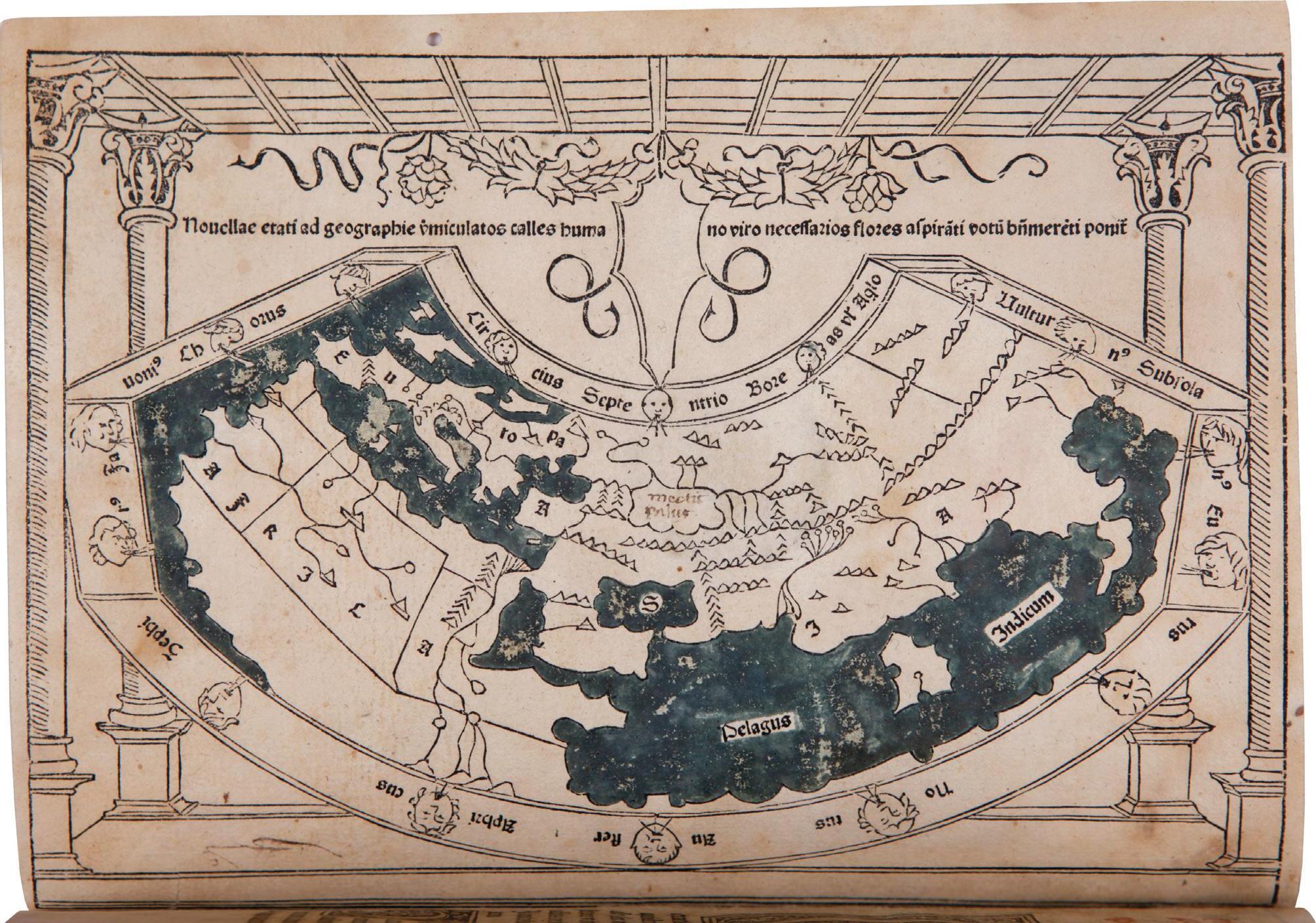
THE KNOWN WORLD ON THE EVE OF THE DISCOVERY OF AMERICA
1. MELA, Pomponius. Cosmographia, sive De situ orbis. Add: Dionysius Periegetes: De situ orbis. Tr: Priscianus. Venice: Erhard Ratdolt, 18 July 1482.
Chancery quarto (191 × 145 mm): A–F 8; [48] leaves. Full-page woodcut map with type inserts on A1 verso, with the oceans hand-colored at an early date. Woodcut white-on-black initials. A few early marginal annotations in red. Late eighteenth-century Italian green morocco gilt, red morocco spine label, gilt turn-ins, all edges gilt. Boards a bit rubbed. Endpapers renewed, first leaf possibly supplied from another copy, fore-margin of A2 restored, a few small wormholes, stamp removed from verso of the map.
Two of the most important collectors of Americana, E. D. Church and Thomas W. Streeter, both began the catalogues of their collections with this title. The choice could not be more apt. No other printed work provides a resume of ancient geography and registers the kind of geographical advance that would result from the voyages of Columbus and Vespucci. “The revival during the Renaissance of geographical study resulted in the first printings of the ancient works of Mela (1471) and Ptolemy (1475) which greatly stimulated exploration. Mela’s concept of the world as published here—ten years before the discovery of the New World—was the most widely accepted cosmography in Europe; his ideas were being proved out by the Portuguese explorations around Africa” (Streeter).
THE PARSONS COLLECTION 6
A scarce incunable edition of the most widely accepted cosmography in Europe ten years before the discovery of the New World, Mela’s Cosmographia contains the first and only map published in the incunable era to reflect voyages that took place during the age of exploration. The map is just the second woodcut map to be published in Italy (preceded by the T-O map in Ratdolt’s 1480 edition of Rolewinck), and one of the earliest maps to appear in any geographical book, as opposed to an atlas. The 1482 edition of Mela was the first edition of that work to include a world map.
In 1415, Portugal conquered Ceuta, establishing the first European foothold in Africa and marking the beginning of European overseas expansion. Under Prince Henry the Navigator, Portugal continued pushing southward along the African coast. The 1479 Treaty of Alcáçovas gave the Guinea coast, the Azores, the Madeiras, and Cape Verde Islands to Portugal, and the Canaries to Castille. The present map modifies the Ptolemaic rendering of western Africa to cut into the east, revealing a true Western Africa based on reports of Portugal’s success further south, and making it current with known geographical knowledge.
“The map of the known world . . . is drawn on the conical projection and is based for the most part on w. An important improvement, however, lies in its clear recognition of the south-eastward trend of the west African coast below the 12 degree parallel. These accord with Portuguese discoveries up to the year 1447 and the gradual unfolding of the Gulf of Guinea in light of the information brought back by subsequent expeditions in the period 1460–71. No earlier printed map recognized this important step towards the rounding of the Cape of Good Hope in 1488, and no map in the incunable editions of Ptolemy reflected this knowledge” (Campbell). The maker of the map is unknown but is often credited to the printer Ratdolt. The editio princeps of the work appeared in 1471 without a map, as did the four subsequent editions which followed. The map was copied for a Salamanca edition of 1498 and for Schedel’s Nuremberg Chronicle (1493).

The only Latin geographical treatise to survive from antiquity, this work would certainly have been among those studied by Columbus. Although many of the theories of the first-century Roman geographer would have been irrelevant to the planning and execution of his First Voyage, one can imagine his thoughts reading Mela’s theory on the probability that the unexplored southern hemisphere was inhabited while he prepared to sail west, headed for what would become known as the New World.
BMC V 286; Bod-inc M-179; BSB-Ink P-687; Campbell, Earliest Maps 91; Church 1; Goff M452; GW M34876; HC 11019*; ISTC im00452000; Klebs 675.6; Oates 1751; Proctor 4385; Rhodes (Oxford Colleges) 1191; Shirley, Mapping of the World 8; Streeter Sale 1; Walsh 1809, S-1809.

THE DISCOVERY OF AMERICA 7
SOLD

ONE OF THE EARLIEST MENTIONS OF THE DISCOVERY
2. CARVAJAL, Bernardinus. Oratio super praestanda solenni obedientia Sanctissimo D.N. Alexandro Papae VI ex parte Christianissimorum dominor Fernandi & Helisabe Regis & Regina Hispaniae. [Rome: Stephan Plannck, ca. 19 June 1493.]
Quarto (195 × 135 mm): a 8; [8] leaves. A few manuscript chapter headings in an early hand, and some underlining. Early twentieth-century dark gross-grained morocco by Sangorski & Sutcliffe, gilt-ruled, spine gilt with raised bands. Minor staining in outer margin, but generally a fresh, unwashed copy. Very good. Provenance: Helmut N. Friedlaender (booklabel; his sale, Christie’s NY, April 23, 2001, lot 37).
Exceedingly scarce first and only edition of one of the earliest printed documents to mention the discovery of the New World—a mere four months after Columbus’s return from his first voyage. The work is a lynchpin in the geopolitical contest between Spain and Portugal over the division of the newly discovered lands, and
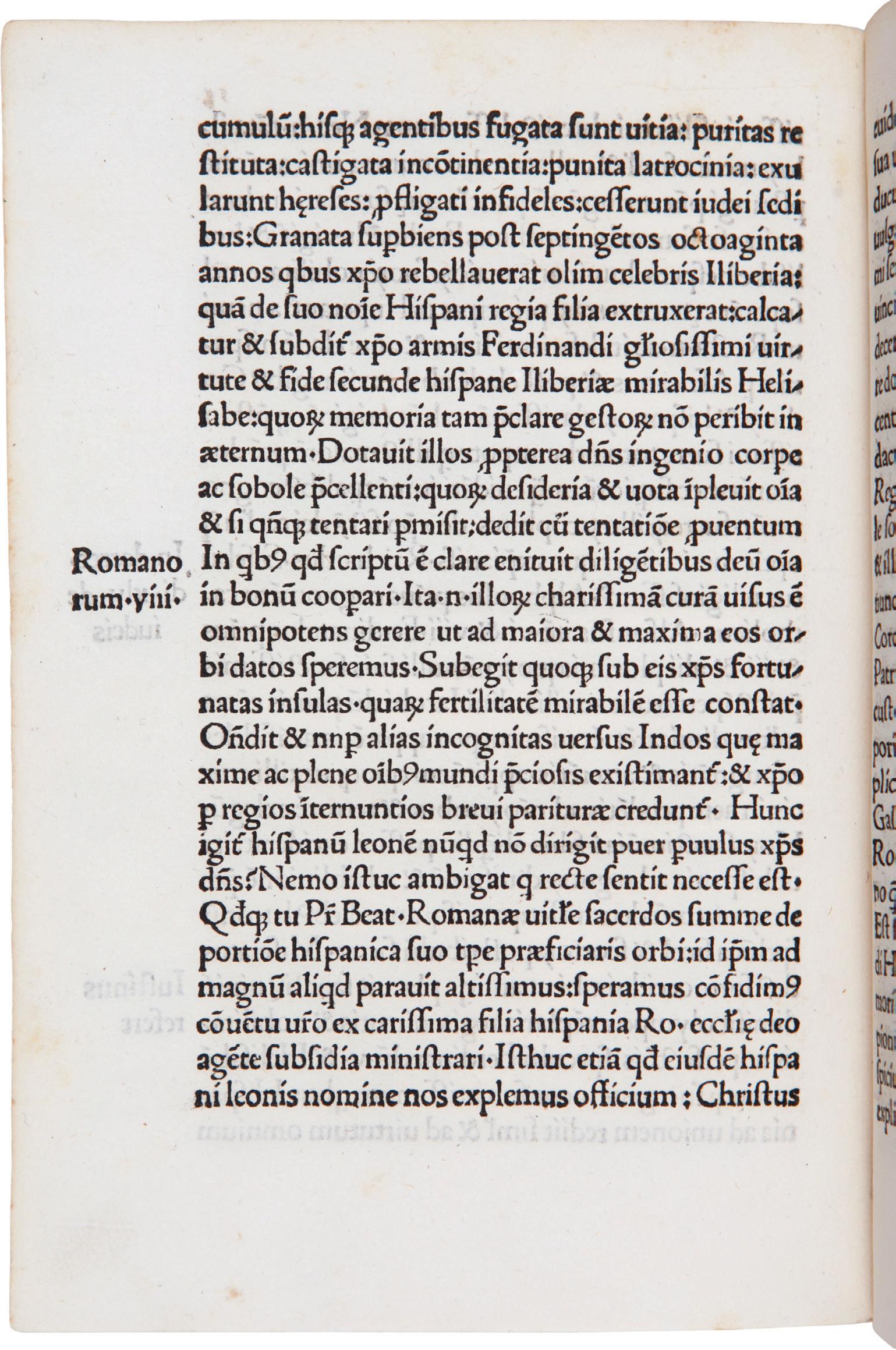
Carvajal is recognized for influencing Pope Alexander VI’s strategy of legitimizing European colonization of the Americas through the conversion of its indigenous population to Christianity. Delivered on June 19, 1493, his oration was a critical affirmation of the papal bulls issued the previous month in which Alexander granted Spain possession of not only the islands discovered by Columbus, but also of any further territories that would yet be discovered.
THE PARSONS COLLECTION 8
When Columbus returned from his first voyage in March 1493, the Portuguese King John II immediately claimed the newly discovered islands for himself, citing the Treaty of Alcáçovas of 1479 and the bulls of Pope Sixtus IV. From Barcelona, the Spanish monarchs sent an urgent dispatch to Rome—via Carvajal, their permanent ambassador to the Holy See—to secure their own claims on the new territories. After private meetings with Carvajal, the pope issued a sequence of three bulls on May 4 and 5, 1493, in which he not only conferred the rights to Columbus’s discoveries on the Spanish crown, but for the first time drew a meridian line demarcating a part of the world in which any non-Christian lands were given over to Spain. For Portugal, the papal ruling was a severe blow, and their protests eventually led to a compromise in the Treaty of Tordesillas (June 7, 1494), in which the north–south line was moved further west and their own claims on any undiscovered lands east of it upheld. At the time Carvajal presented the present oration, however, Spain was at a clear advantage. In his oration of obedience, Carvajal underlines the Borgia pope’s Spanish origins (Borja) and extols the piety and virtue of Spain under the Catholic kings. Arguing that God has created this alliance of a Spanish pope and Spanish monarchs for the purpose of furthering the faith, he then introduces Columbus’s discoveries.
Carvajal’s oration galvanized theological debate in Rome and inspired Pope Alexander, who had ascended to the papacy the very year of the Discovery, to throw his weight behind the missionary conquest of the New World. Carvajal’s theological argument influenced Alexander’s policy on territorial concessions directly: where the Portuguese might have hoped for him to arbitrate merely in their dispute with the Spanish, Alexander, following Carvajal’s reasoning, considered all earthly dominion as property of the pope, and therefore his to give in free donation to whom he saw fit.
The sequence of “first mentions” of the Discovery is a complicated and perhaps fruitless task. Many of the earliest candidates lack printed dates or “true” printed dates. For example, while the first issue of the Plannck translation of the Columbus Letter contains a date, generally interpreted to be April 25, 1493, subsequent editions merely repeat this date. Of the earliest items mentioning the Discovery listed by Harrisse following the 1493 editions of the Columbus Letter, #8 is a brief poem by Giuliano Dati dated October 25 and thought to be published in Florence; #9 is a supplement to Dati’s poem, expressly signed from Florence and dated the following day; #10 a Spanish-language miscellany published in Seville by Ortiz, giving the year but no month; and the present work, the date of whose public delivery (June 19) is known from the title, but not the date of printing. For items of this kind, the chronology between public oration and printed text cannot always be precisely known. The oration may have been printed prior to delivery, so that a select audience could follow the text, or printed shortly afterwards, though given the stakes at issue in the present instance, probably not much later. It would seem very likely, however, especially given the Rome imprint by the same printer as the Columbus letter, that the present work in fact preceded several of the others listed by Harrisse.

THE DISCOVERY OF AMERICA 9
continues overleaf
Goff lists ten copies in the United States: Chapin Library, Cornell, Huntington, Hispanic Society of America, Lilly, JCB, LC, NYPL, Free Library of Philadelphia, and Princeton (Kane). ISTC adds no new American copies, locates nineteen copies at sixteen locations worldwide: BL, BNF (2), Chantilly, Koblenz, Mainz, Munich, Wolffenbüttel, Cremona, Milan, Trivulziana (2), Naples, Perugia, Rome BN, BAV (2), Madrid BN, St. Petersburg, Wroclaw. The work is much scarcer on the market, with only the present copy having come up twice at auction in the past half century.
BSB-Ink C-163; Church 3; European Americana 493/2; Goff C221; GW 6145; IGI 2532; Harrisse (BAV) 11; Medina (BHA) 11; Sabin 11175. On Carvajal see Vicente Calvo Fernández “El cardenal Bernardino de Carvajal y la traducción latina del ‘Itinerario’ de Ludovico Vartema,” Cuadernos de filología clásica: Estudios latinos, 18 (2000), 303–22; José Goñi Gaztambide, “Bernardino López de Carvajal y las bulas alejandrinas,” Anuario de historia de la Iglesia, 1 (1992), 93–112.
SOLD
THE FIRST OBTAINABLE BOOK ON THE EQUATORY: A LITTLE KNOWN AMERICANUM
A little known and very early Americanum, the work’s American interest was first described by the bookseller E. P. Goldschmidt in his famous article “Not in Harrisse”, in which he quotes a passage from sig. e2 of the present work, supplying the following translation and interpretation: “‘There exists also a region discovered in our lifetime, called in Spanish “la Guinea”, whose longitude is about 60 degrees west (viz. from Alexandria) and the latitude about 12 degrees south of the equator; nor far from there are several islands of which nothing is known with certainty.’ It is not unlikely that this passage refers to the discoveries of Columbus as yet still unconfirmed by Vespucci’s voyages. It is clear that it does not refer to the Canary Islands, whose exact position (Gratiosa, Orto Ventura, Canaria insula) is given

THE PARSONS COLLECTION 10

a few lines above it. The indication ‘somewhere near the Gold Coast’ may seem strange to us now, but in 1496 this corresponds to the generally current notions based on the fact that it was from the west coast of Africa that Columbus started westwards along the equator until he struck Hispaniola” (“Not in Harrisse,” in Essays Honoring Lawrence Wroth [1951], p. 132).
ISTC locates thirteen copies worldwide, with but three in America (Smithsonian, Harvard, and NYPL). We find no other examples on the market in nearly a century.
European Americana 496/9; Goff L139 (locating Dibner & Harvard); Hain 4283. Emmanuel Poulle, Les instruments de la theorie des planetes selon Ptolemy (Droz, 1980). SOLD

THE DISCOVERY OF AMERICA 11
THE FIRST DATED BOOK ON SYPHILIS: WRONGLY THE FRENCH DISEASE, ITS AMERICAN ORIGINS SINCE CONFIRMED
4. GRÜNPECK DE BURCKHAUSENN, Joseph. Tractatus de pestilentiali Scorra sive mala de Franzos Originem Remediaque eiusdem continens co[m] pilatus a vene rabili. [Leipzig: Gregorius Böttiger, after 18 October 1496.]
Quarto (205 × 155 mm): a–b 6; [12] leaves. Later vellum. Vellum lightly soiled and wrinkled. Very clean internally.
A medical incunable of note, Grünpeck’s work is among the earliest dated works to discuss syphilis, perhaps the earliest global epidemic. Cases arrived in Europe with the return of Columbus from his first voyage in 1493 and quickly spread among the army of Charles VIII after the French king invaded Naples. Although over the years some have doubted the Columbian exchange theory as to the origin of the epidemic, modern genetic analysis has all but confirmed the American origins.
The work is a commentary by Grünpeck, the secretary of Emperor Maximilian, on a broadside poem of Sebastian Brandt; the text of this poem is included here, along with an extensive discussion of the astrological causes of the disease. According to Garrison and Morton, Grünpeck was “the first to record mixed primary lesions, multiple primary lesions, and to note the second incubation period of syphilis.”


The work appeared in six editions all in late 1496 and early 1497, in either Latin or German, the former with an additional introduction regarding treatment. All editions are scarce; we note the last example on the market being sold by H. P. Kraus in his famed catalogue Americana Vetustissima (cat. 185, item 3).
BMC III 648; Bod-Inc G-259; BSB-Ink G–385; European Americana 496/8; Goff G515; GW 11571; H 8093*; ISTC ig00515000.0; Klebs 476.3; Walsh 828.
$45,000
THE PARSONS COLLECTION 12

THE DISCOVERY OF THE NEW WORLD AND THE FIRST ACCOUNT OF BRAZIL
5. VESPUCCI, Amerigo. Mundus Novus. Rome: Eucharius Silber, 1504.
Small quarto (190 × 136 mm): [4] leaves. Two woodcut initials, two schematic representations of constellations, and a woodcut diagram. Extensive near-contemporary marginalia, significantly faded (see below). Bound in modern black crushed morocco, ruled in blind, spine with raised bands. In a half morocco and cloth clamshell case, spine gilt. Washed. First letter mis-inked in “[c]ognitione” on recto of leaf A2.
A primary account of the discovery of the New World, indeed the first to describe it as such, Mundus Novus is the first printed account of Brazil, and Vespucci’s first published work about his American voyages.
THE DISCOVERY OF AMERICA 13
A rare and important Americanum by the man after whom the Americas would be named, this epistolary work comprises the “first existing printed document about Brazil” (Borba). The letter to Vespucci’s patron Lorenzo di Pierfrancesco de Medici describes his voyage along the coast of Brazil carried out in the service of King Emmanuel of Portugal between May 1501 and September 1502. This voyage under the Portuguese flag is of fundamental importance in the history of geographic discovery, convincing first Vespucci and then those who read his letter that the newly discovered lands were not part of Asia but a New World. In this sense, Vespucci was the first to proclaim the true significance of the discovery.
During this voyage Vespucci became the first European to see the Río de la Plata, and sailed along the coast of Patagonia, possibly reaching as far as 50 degrees south. Spending almost a month ashore, Vespucci met indigenous peoples, whom he described as naked cannibals wearing colorful ornaments in their perforated ears, noses, and lips. He also described houses, hammocks, customs, and eating habits, and detailed animals and plants, some of which he compared to those in the Old World and others that were wholly new. Likewise, he observed that the very sky of the Southern Hemisphere was different. Indeed, Vespucci was the first astronomer to measure the positions of the most important southern stars and his brief descriptions of them, together with his star diagrams, appear for the first time in this work.
Vespucci (1454–1512), a Florentine merchant, first went to Barcelona in the employ of the Medicis in 1489, and to Seville in 1493. Probably involved in equipping the ships for Columbus’s second voyage, Vespucci went on voyages in 1497 and 1499 under the Spanish flag, commissioned for his knowledge of astronomy and his navigational skills. Following the success of his third voyage, under the Portuguese flag, in 1508 he was appointed Spain’s piloto mayor (chief navigator). “The brilliant pamphlets that circulated about his adventures in the West made him the reputation that his voyaging could not” (Grafton, p. 83).
While none of the early editions bear imprints, Sabin, European Americana, and Borba consider this to be the fourth Latin edition, reprinted from the second issue of the second edition (Venice). The type was identified by Dr. Joseph Martini as being “the same as [that] used by Silber in the letter of Columbus (1493).” The Mundus novus was republished throughout Europe with the rapidity of a news sheet, appearing at least twelve times during Vespucci’s lifetime in Latin, several times in German and French, as well as once in both Dutch and Czech. “The alterations of text made in this edition, combined with the alterations of the Venice edition, served as the basis of all the later Latin editions printed at Nuremberg, Strassburg, Rostock, Cologne, Antwerp, and Paris. It was the first to appear without a separate title page, the words Mundus nouus being placed at the head of the first page. The spelling of Vesputius with a ‘t’ was adopted for the first time . . . and the triangle was moved from its right position under the eighth paragraph [to the verso of the final leaf] under Lavs Deo. Typographically it is a fine piece of printing, and with few word contractions” (Wilberforce Eames in Sabin).
“A pamphlet that enjoyed such great success in the sixteenth century, that was reprinted so frequently, commented upon and analyzed, that was and still is the object
THE PARSONS COLLECTION 14

of a centuries old polemic, could not but be of enormous bibliographical interest. To this must be added the fact that any of the editions or translations are very rare, dated or undated. It has been avidly sought after by bibliophiles for more than a century and a greater part of the copies are already in public libraries” (Borba).
This is an unusual copy for being extensively annotated in Latin in a sixteenth-century hand. Discovery Americana of this rank rarely contains any evidence of contemporary or near-contemporary reception or context. The annotations have faded from washing, but they can be read under close inspection. On the first page, the reader notes that Vespucci came from Florence (“Florentinus” appears above Vespucci’s name in the salutation) and in the cropped note above the text he sets Vespucci’s work into a chain of discussions that begins with Pierre d’Ailly, whom
THE DISCOVERY OF AMERICA 15
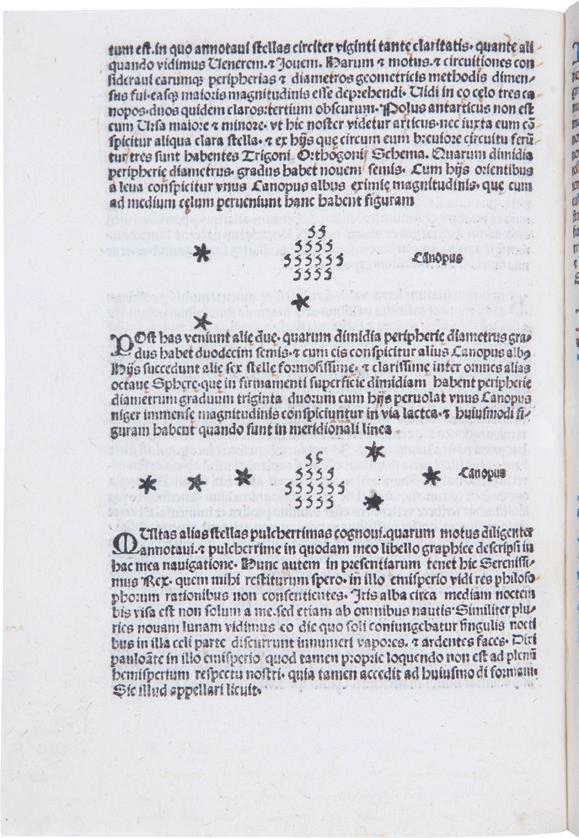
Columbus famously read. References to other authors in the annotations include several mentions of Peter Martyr as well as astronomer Johannes Schöner.
Several of the manuscript annotations would seem to suggest that the early reader had access to maps of the world depicting America. For example, he names Vespucci’s reference to the “angle of land” as “promontorium sanctae Crucis,” perhaps referring to the name given to South America in the map of the world on Benedetto Bordon’s oval projection contained in the Isolario of Bartolomeo da li Sonetti. Recording in the margin next to Vespucci’s description of the nakedness of the indigenous inhabitants, he writes: “Nudi. quia sub torrida zona” (“Naked, because [they are] under the torrid zone”). A lengthy annotation at the rear espouses the Ptolemaic relationship between geographic location and skin color: “Quaecumque igitur gentes subiacent Zodiaco, praeterquam in Sphaera armillari, iis sol sit supra verticem a Borea descendens ad austrum, ascendensque similiter, et aliis quidem semel in anno, aliis vero bis. Sunt autem omnes pariter qui sub Zodiaco habitant ab occasu ad ortum solis usque nigri, coloribus Aethiopes, et praecipue hi qui sub circulo aequinoctiali habitant, ii admodum nigrescunt. Qui autem extra lineam perpendicularem Zodiaci degunt remissiores sunt colore, et in albedinem tendunt, secundum distantiae rationem, usque ad Sarmatas Hyperboreos. Eadem est ratio Zodiaci ab utraque parte equinoctialis, et Boream versus et Austrum, usque ad utrosque polos.” (“Whichever nations, then, are subject to the Zodiac, except those who are girdled in the Sphere, for them the sun is above the summit descending from Borea to the south, and rising in the same way, and for some once a year, but for others twice. Now all those who live under the Zodiac from sunset to sunrise are black in color, Ethiopians, and especially those who live under the equatorial circle are very black. But those who live outside the perpendicular line of the Zodiac are lighter in color, and tend towards whiteness, according to the distance, as far as the Sarmatians and the Hyperboreans. The system of the Zodiac is the same on both sides of the equator, and towards Borea and the South, as far as both poles.”) Many other annotations are worthy of further research.
A foundational Americanum, announcing the discovery of the New World, and an outstanding rarity.

Borba de Moraes pp. 904–9; Brunet V.1154, Suppl. II.873; Church 17; European Americana 504/8; Harrisse (BAV) 23; JCB (3) I, p. 40; Medina (BHA) 22; Portugal-Brazil, pp. 237–40; Sabin 99331; Warner, Sky Explored, p. 225. See also Robert Wallisch, Der “Mundus Novus” des Amerigo Vespucci (Vienna, 2002).
$425,000
THE PARSONS COLLECTION 16
FIRST WORK PUBLISHED IN POLAND WITH A REFERENCE TO AMERICA
6. GLOGOVIENSIS, Joannes [Jan Glogowczyk]. Introductorium compendiosum in tractatum spere materialis magistri Joannis de Sacrobusto. Krakow: Jan Haller, 28 April 1506.
Quarto (210 × 155 mm): a–m 6; [72] leaves. Full-page woodcut armillary sphere, a nearly full-page cut of Jesus and his devotees presiding over the seven planetary zodiacs, a full-page table of solar declinations, and twelve woodcuts in text. Some contemporary manuscript annotations. Modern vellum over boards. Vellum bowed. Light staining in margin of some leaves, minor dampstaining extending from top gutter margin to a few signatures, final leaves toned, repairs to lower outer corners of the final few leaves. About very good.
Glogoviensis (1445–1507) published many works on astronomy, logic, and grammar for the use of students. He taught at the University of Krakow, and on that basis is postulated as a possible teacher of Copernicus. Jan Haller was the most prolific printer in Krakow at this time and published Copernicus’s first published work, a translation of Theophylact in 1509, and printed another edition of Glogoviensis’s treatise in 1513.
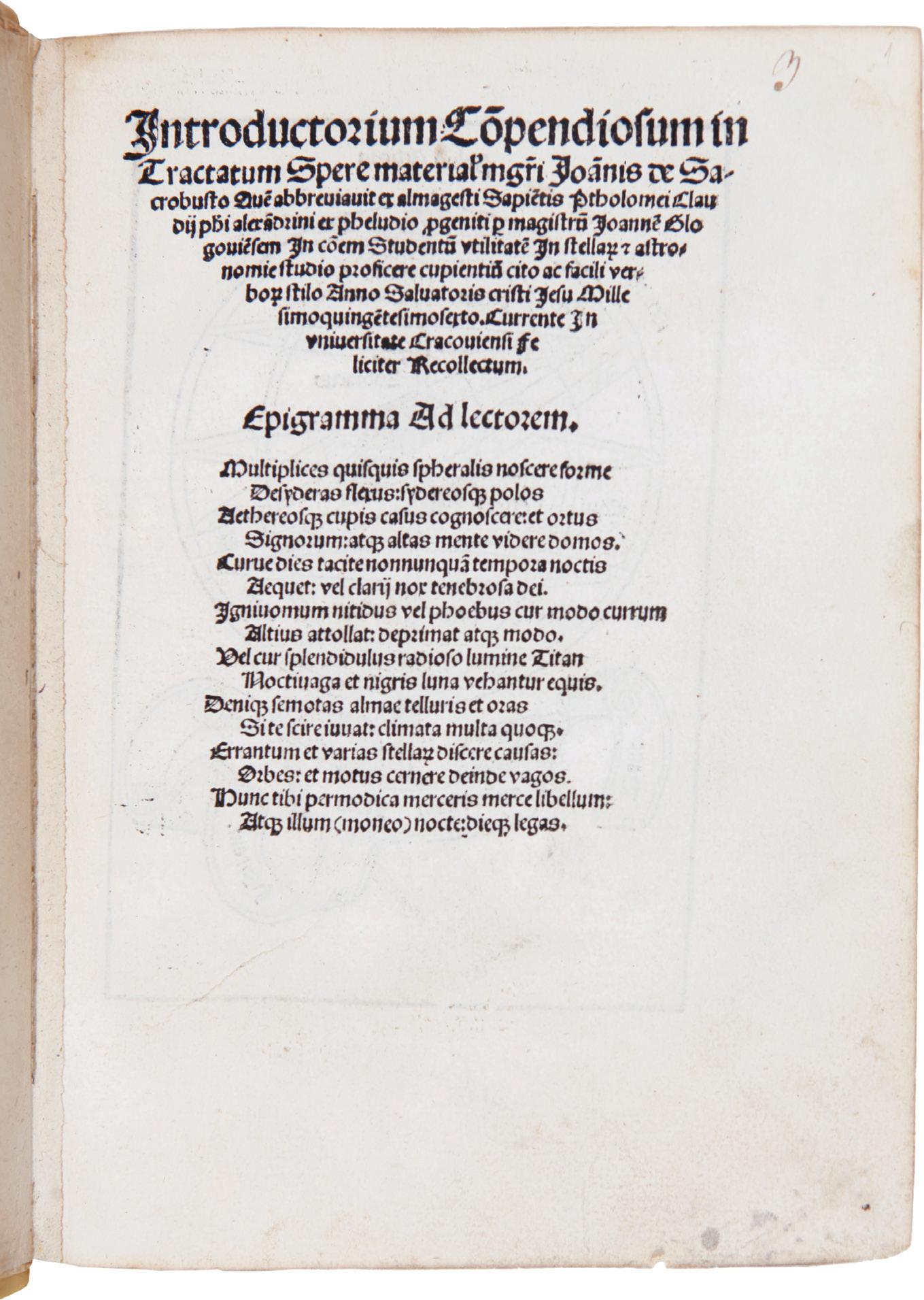
This scarce work, however, is the first title printed in Poland that mentions the discovery of America. On G2 verso is a long passage of American interest, referring to the expeditions of Vespucci who the King of Portugal sent out to the New World in 1501 and in 1504 to discover the location and number of its islands. Refuting Sacro Bosco’s claims relating to the habitability of the torrid zones, he writes: “And the same thing is confirmed by those who in the year 1501 and similarly in the year 1504 were sent by the King of Portugal to discover the origin of pepper and other aromatic spices. They sailed beyond the equator and saw both celestial hemispheres and their stars and they found the origin of pepper in a place which they called the New World which was hitherto unknown.” On I4 recto is another long passage referring to the inhabitants and climate of the newly discovered lands.
Scarce: European Americana locates seven copies, though only a single example appears in the auction records for the last half century.
European Americana 506/6 (catalogued under Sacro Bosco); Yarmolinsky 10; Zinner 867.


THE DISCOVERY OF AMERICA 17
SOLD

THE PARSONS COLLECTION 18
“AFTER COLUMBUS’S LETTERS, THIS IS THE MOST IMPORTANT CONTRIBUTION TO THE EARLY HISTORY OF AMERICAN DISCOVERY”—SABIN
7. FRACANZANO DA MONTALBODDO. Itinerarium Portugallensium e Lusitania in Indiam et in de in Occidentem et demum ad aquilonem. Milan: J. A. Scinzenzeler(?), 1508.
Small folio (250 × 178 mm): A–C 8 D 6 E–F 8 G 6 H 8 I 6 K–M 8 N 6 2a 2 (index); [10], LXXVIII [i.e., 88] leaves, with errors in foliation as issued. 10- and 3-line woodcut initials. Three woodcuts and three-quarter page woodcut map of Africa and Arabia on title, the map hand-colored at an early date. Bound in old vellum manuscript over pasteboard, a few tears to spine exposing block, but sound. Housed in quarter morocco and linen box. Right margin of title trimmed close, just grazing final letter of first line to woodcut border, occasional light spotting and soiling, small dampstain in gutter of scattered leaves. Overall, an extremely fresh, unsophisticated copy. A. M. von Birckholz (bookplate on front pastedown); Mittel Rheinisch Reichs Ritter Schafflichen Bibliothek (bookplate on verso of title).
First Latin edition of the first printed collection of voyages, considered “after Columbus’s letter the most important contribution to the early history of American discovery” (Sabin); this copy with the second state woodcut map on the title page naming the Arabian Gulf.
Fracanzano (or Fracanzio) da Montalboddo (fl. 1507–1522) was an Italian humanist and university professor. For this seminal compilation, he collected reports of the voyages of Columbus, Vespucci, Cabral (Brazil), Cadamos (Africa), and the earliest printed account of the voyage of Vasco da Gama to India. The latter was first published in Italian in 1507 under the title Paesi novamente retrovati; this Latin translation, printed the following year, was made by the Milanese monk Arcangelo Madrignani, who also translated Varthema’s Itinerario (1510). It quickly became “the most important vehicle for the dissemination throughout Renaissance Europe of the news of the great discoveries both in the east and the west” (PMM).
The woodcut map, which appears for the first time in this Latin edition, is the first large map of Africa, the first known map in which that continent is depicted as surrounded by the ocean, as well as the earliest “modern” printed map to show Mecca. This is the corrected second state, distinguished by naming the Gulf as “Sinus Arabicus,” as opposed to “Persicus.” Also present is the rare two-leaf index, which is of crucial importance, as it gives an outline of the contents, identifying individual voyages and discoveries, whereas the text of the book runs continuously from section to section without distinguishing where a new one begins. These leaves were apparently printed after the publication of the work, inserted into the few available copies after the fact, and are therefore almost invariably missing.
The work, which contains six nominal sections, commences with the voyages of Alvise de Cadamosto in Ethiopia and along the West African coast. Cadamosto traveled to Senegal, Gambia, and the Cape Verde Islands in 1455 and 1456. This is followed by accounts of Pedro de Sintra’s expedition along the west coast of Africa as far as Sierra Leone in 1462; Vasco da Gama’s epochal voyage to Africa
THE DISCOVERY OF AMERICA 19
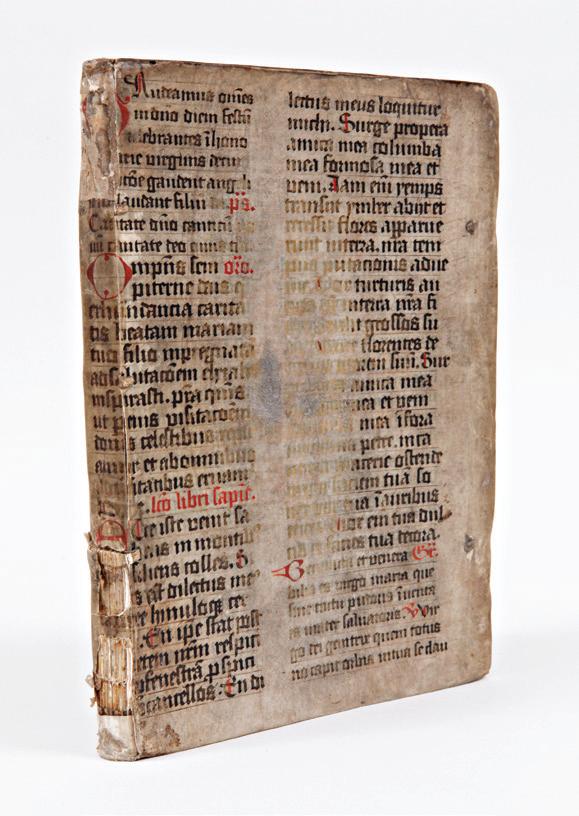

and India (1497–99), which “opened the way for the maritime invasion of the east by Europe” (PMM), supplied by letters from Venetian spies in Portugal; and Pedro Alvares Cabral’s discovery of the Brazilian, Guianaian, and Venezuelan coasts in 1500. The third section is a continuation of the Cabral narrative of the voyage on to India. The fourth is an account of Columbus’s first three voyages (1492–1500), undoubtedly based on Peter Martyr’s Libretto de tutta la navigatione de Re de Spagna de le isole et terreni novamente trovati, as well as narratives of the expeditions of Alonso Niño and Vicente Yañez Pinzon along the northern coast of South America. The fifth is Vespucci’s letter to Lorenzo de’ Medici describing his third voyage in 1501–02. The sixth is a compilation of information derived from several sources concerning the Portuguese discoveries in Brazil and the East.
Montalboddo’s collected voyages is called by Henry Harrisse “the most important collection of voyages”; Boies Penrose asserted that “for news value as regards both the Orient and America, no other book printed in the sixteenth century could hold a candle to it.” The work was the forerunner of the later compilations of Grynaeus and Huttich, Ramusio, Eden, Hakluyt, the De Brys, and Hulsius, “an auspicious beginning to the fascinating literature of the great age of discovery” (Lilly Library online). “This book is not a jewel, it is a cluster of jewels” (Rodrigues).
Bell F169; Borba de Moraes p. 580; Church 27; European Americana 508/4; Harrisse (BAV) 58; JCB (3) I:46; LeClerc 2808; Penrose Sale 172; Printing and the Mind of Man 42; Rodrigues 1295; Sabin 50058.
$550,000
THE PARSONS COLLECTION 20

6th climactic region, towards the Antarctic, are situated the extreme part of Africa, recently discovered, the islands of Zanzibar, Java minor and Seula, and the fourth part of the world which, since it was discovered by Amerigo, it is permissible to call ‘Amerigen’, that is, the land of Amerigo or America” (Chapter ix, C3v). The designation was adapted almost immediately by cosmographers (see Borba 931 for its descent).
Throughout the work, Waldseemüller refers to a map and a globe of his design, which are known independently to have been issued in the spring of 1507, thus suggesting that

THE DISCOVERY OF AMERICA 21


the work doubled as a guide to their use. The map survives in a single copy (Shirley #26) discovered in 1901 in the library of Prince Johannes zu Waldburg-Wolfegg in Schloss Wolfegg in Württemberg, Germany, and purchased in 2001 by the Library of Congress. No globe survives, but two sets of uncut gores do (Shirley #27): one at the University of Minnesota (Bell Library), and one other in a private collection.
The work also contains a later printing of Vespucci’s epistolary account of his Four Voyages, first published in Florence between 1505 and 1506. Alberto Magnaghi in his Amerigo Vespucci, studio critico (Rome, 1926) doubted the authenticity of much of the work due to textual inconsistencies, arguing that Vespucci actually made only two voyages: the first with Hojeda in 1499 during which they sailed down the South American coast from the Guianas to latitude 6 degrees south; and the second in 1501 at the expense of the King of Portugal when he followed the Brazilian coast down to 50 Mundus Novus. With his more recent annoDer “Mundus Novus” des Amerigo Vespucci (Vienna, 2002), Robert Wallisch disputes much of Magnaghi’s arguments.
The present work was first published on April 25, 1507, in two discernible editions and a third on August 29 of the same year. An alleged fourth edition also published on August 29 was thought to exist in a single copy, but this was proved to be a composite of the previous three editions and not a true edition (e.g., Church I, p. 57). The present is thus the fourth edition. The first edition is exceedingly rare, known in only two examples. Although subsequent editions are less rare, all are extremely scarce on the market.
The present example is significant for its extra-illustrations, notably an example of the woodcut world map by Jacques Severt (Shirley #179), a north polar projection extending to the equator with the four continents designated in capitals, a reduction of the 1581 map of Guillaume Postel.
A work of fundamental importance for the history of the Americas.
Borba de Moraes p. 932; Church 32; European Americana 509/13; Harrisse (BAV) 60; Sabin 101022; Shirley, Mapping of the World, cf. 26–27; cf. Streeter Sale 4; cf. Streeter, Americana-Beginnings 2.
SOLD
22

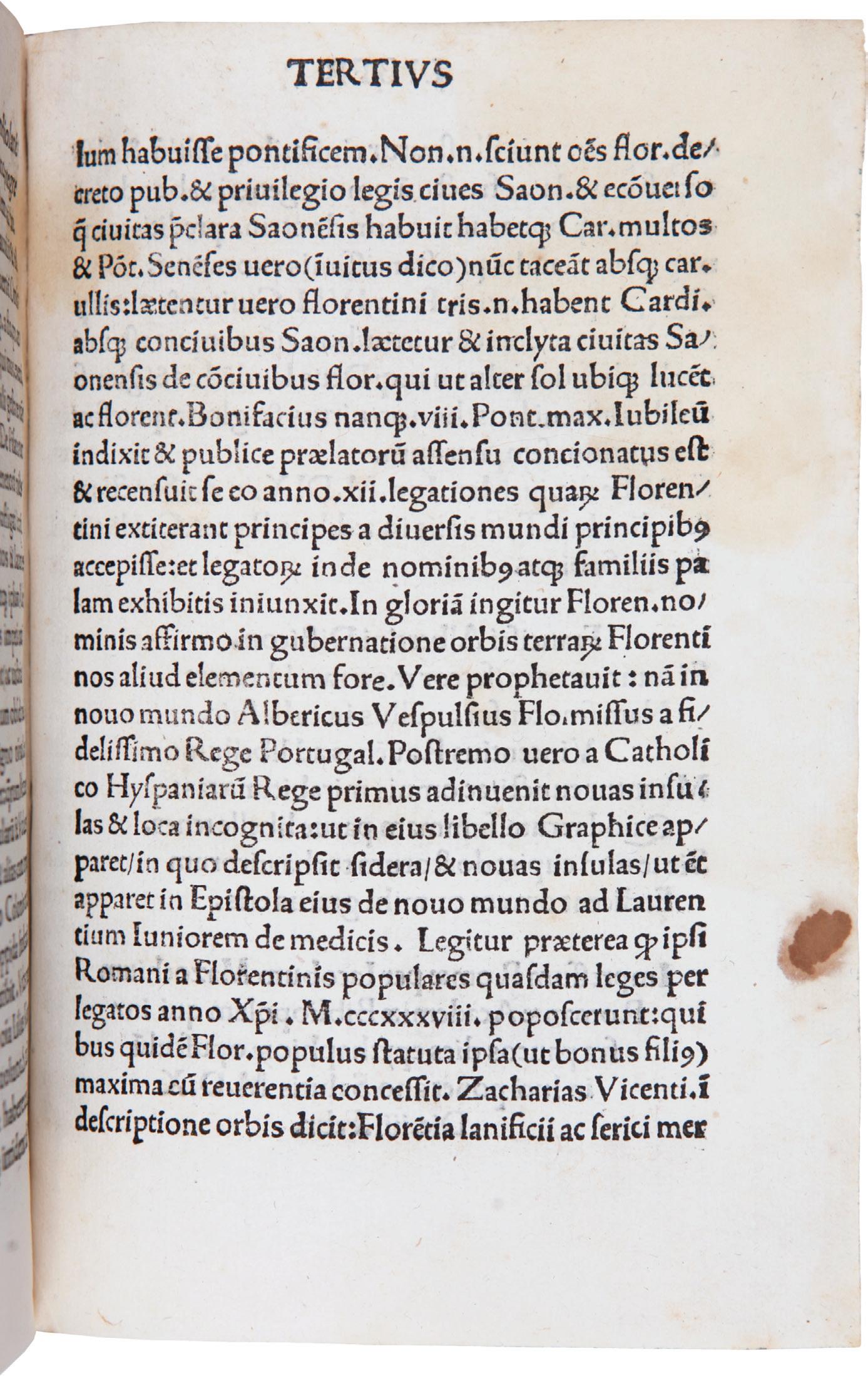
THE DISCOVERY OF AMERICA 23

as the first to discover “novas insulas & loca incognita” on behalf of the Spanish and Portuguese monarchs.
The work was compiled for Cardinal Galleotto delle Rovere, nephew of Pope Julius II, who requested that the Florentine humanist, Albertini, write an accurate and up-to-date guide to the city of Rome. This was intended to replace the Mirabilia Romae Urbis, a guidebook first produced in the twelfth century in response to the demand from pilgrims for an historical and artistic itinerary to the city. In responding to the Cardinal’s request, Albertini’s handbook contains descriptions of ancient ruins and later buildings including religious, secular, and pagan sites. The Renaissance guide includes the first printed reference to Michelangelo’s ceiling in the Sistine Chapel.
The small black inkstamp on the title page of this copy belongs the prominent Albani family from Urbino, whose ranks included the collector and cardinal Alessandro Albani, as well as Giovanni Francesco Albani, later Pope Clement XI. Clement was a supporter of the Vatican Library, and his abiding interest in antiquity and the preservation of Roman artifacts would have made the present volume a particularly relevant part of his collection. The Bibliotheca Albana was amassed primarily in the eighteenth century, and though much of it was confiscated during the French Revolution, a large portion remained intact until it was sold in the early twentieth century.
European Americana 510/1; Harrisse (BAV) 64; JCB (3) I:50; Sabin 663.
A RARE POLISH AMERICANUM
$9,500

10. STOBNICZA, Johannes de [Jan de Stobnicy]. Introductio in Ptholomei Cosmographia[m] cu[m] longitudinibus et latitudinibus regionum et civitatum celebriorum. Krakow: Florian Ungler, [1512].
Quarto (200 × 140 mm): π A 4 (-A4, cancel) B-C 4 D 6 E-L 4; 46 leaves. Errors in pagination as issued. Full-page woodcut of armillary sphere, half-page woodcut of the quadrant, numerous 5- to 12-line woodcut initials, tables and printed marginalia. Without the two maps, as usual, but with a facsimile inserted. Modern half pigskin over wooden boards, raised bands, brass clasps. Evenly tanned, trimmed close at outer edge with minor loss to shoulder notes.
First edition of a highly important early Americanum, containing references to Vespucci, as well as a description of the isthmus of Panama before Balboa’s “discovery” of the same. The first printed use of the name “America” in Poland, Stobnicza’s work is largely based on Waldseemüller’s Cosmographia of 1507. Indeed, Stobnicza is one of the few cartographers we are certain to have seen the 1507 Waldseemüller world map: “The great Waldseemüller map was not easily circulated, and it is likely that its facts and theories were more quickly disseminated by such earnest gleaners of knowledge as Stobnicza, in his Introductio in Cosmographia” (Yarmolinksy, p. 30).
Stobnicza (ca. 1470–1530?), a specialist in metaphysics, held the chair of cosmography at Kracow and later entered the Franciscan order there. His treatise occupies the first thirteen folios of his Introductio, and it is here that we find his observations
THE PARSONS COLLECTION 24
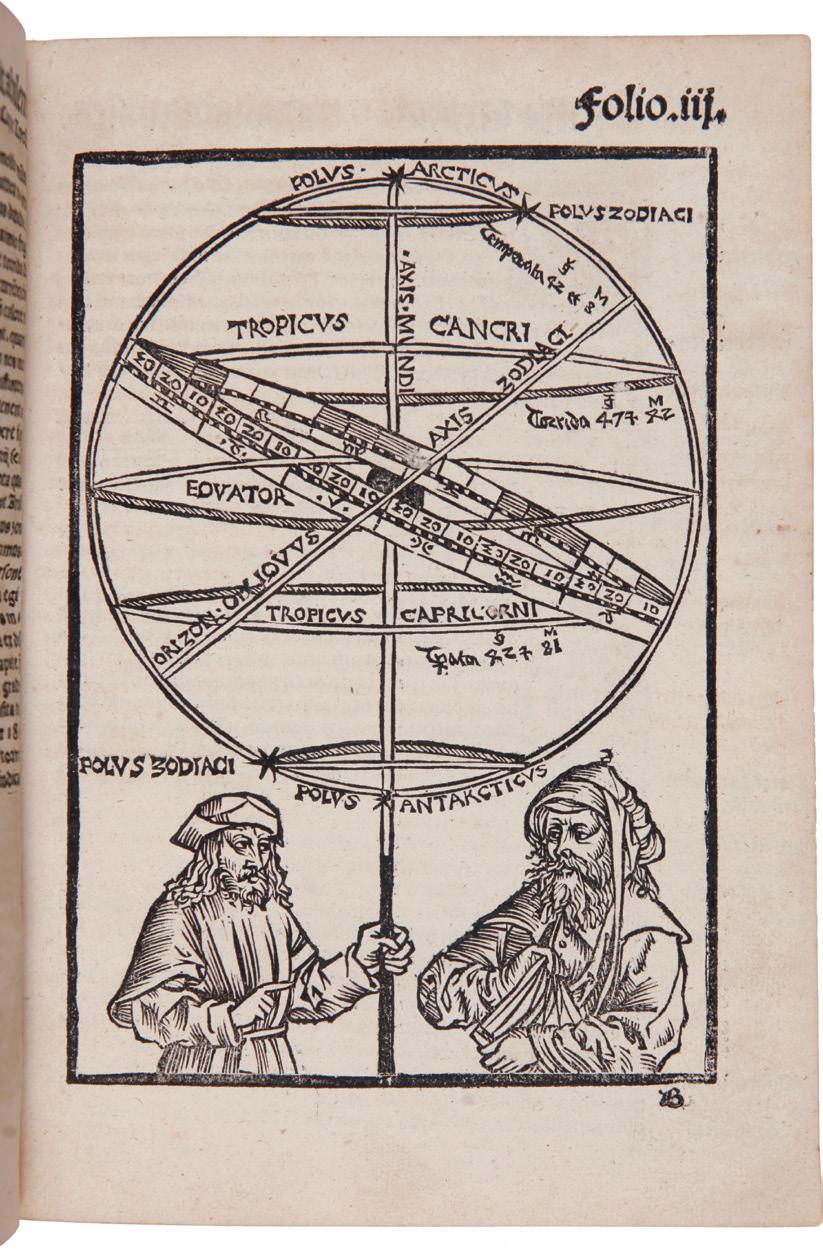
on the newly discovered lands to the west. “And lest for Ptolemy alone I had labored, I have taken care also to make notes about certain parts of the land unknown to Ptolemy and other older writers, which have come to our knowledge through the travels of Americus, and others,” he writes in his introduction, making good on his promise in chapters III, VII, and IX. On the verso of folio vii we find: “Not only the before-mentioned three parts [of the earth] are now known, but another, a fourth part, has been discovered by Amerigo Vespucci, a man of penetrating genius, which part they propose to call Amerigen, or America, the land of Amerigo, after the same Amerigo, its discoverer.” Columbus’s name is notably absent from Stobnicza’s pages, lending currency to the contemporary misconception that Vespucci was the true discoverer of America.
As listed on the title page, Stobnicza’s own commentary is followed by selections from Silvius, Isidore of Seville, Paulus Orosius, and a lengthy description of the Holy Land by Stobnicza’s countryman Friar Anslem, a friend of Copernicus who had made a pilgrimage there in 1507.
The presence of two maps covering the Eastern and Western Hemispheres has been confirmed in just four of the twenty-one known copies of the work, and they are not present here. There remains no consensus on whether the book was issued with the maps, as they were produced by a different printer and their size makes one question whether they belong in the present work. Nevertheless, we know Stobnicza saw the original 1507 world map and so was able to make copies of the two small inset maps. It has been theorized that Stobnicza is likely the person who showed a copy of the 1507 map to Copernicus in Kracow, which provided the source of his commentary in De Revolutionibus.
Two issues of the first edition are noted: with and without a date to the colophon (the present being the latter) and with variations to the setting of the final four leaves. A second edition was published in 1519.
European Americana 512/7; Harrisse (BAV) 69; JCB (3) I:54; Sabin 91866; Yarmolinsky 15–30.

THE DISCOVERY OF AMERICA 25
SOLD

THE FAMED 1513 PTOLEMY: AN EXTRAORDINARY COPY IN A CONTEMPORARY BINDING OF THE FIRST ATLAS TO CONTAIN A MAP OF AMERICA
11. PTOLEMAEUS, Claudius; and Martin Waldseemüller, cartographer Geographie opus novissima traductione e Greco cum archetypis castigatissime pressum: ceteris ante lucubratorum multo prestantius. Strassburg: Johannes Schott, 1513.
Folio (455 × 300 mm): A 2 B-L6 M4 N6; 26 double-page maps, 1 single page map; 19 double-page maps, 1 single page (Lorraine) printed in three colors; π1 (index to modern maps) a6 b4c6 (including terminal blank); 181 leaves in total, complete. Contemporary blindstamped pigskin over bevelled wooden boards, raised bands on spine, with original catches and clasps intact. Old shelf-label on spine. Binding rubbed in places and wormed. Scattered minor worming, mostly marginal, some of it plugged, but sometimes affecting partial letter of text, not affecting maps; even toning and minor staining (marginal) to scattered leaves. Some discoloration from humidity in upper margin of a few leaves. Generally an unusually broad-margined and fresh copy, most likely in its original binding (maps secured by vellum tabs), with the woodcut maps in excellent strikes.
A fine copy in a contemporary pigskin binding of “the most important of all the Ptolemy editions; its supplement of ‘new’ maps marked the beginning of modern map-making. The new maps, based on contemporary observations, were published alongside the long-authoritative Ptolemaic models whose deficiencies were clearly recognized” (Streeter). The work contains the first map of America to appear in an atlas and, among printed books, is preceded only by the map that should accompany the 1511 Peter Martyr (of which Burden was only able to locate ten copies worldwide).
This masterful atlas is one of the most important cartographical works ever published. The first part of this atlas consists of twenty-seven Ptolemaic maps, taken from the 1482 Ulm Ptolemy, or perhaps the manuscript atlas of Nicolaus Germanus upon which the Ulm Ptolemy was based. Work on the twenty maps in the Supplement began around the year 1505 by geographers Martin Waldseemüller and Mathias Ringmann, and was partially funded by Duke Rene of Lorraine. The accompanying text was completed a bit later, and in 1508 all the materials for the atlas passed into the hands of two Strassburg citizens, Jacobus Eszler and Georgius Ubelin, at whose cost the work was completed in 1513.
The atlas is a notable Americanum as it contains the map of the world known as “the Admiral’s map,” variously attributed to either Columbus or, rather less probably, Vespucci. This map, “Orbis Typus Universalis,” first appears in this edition, and depicts the outline of northeastern South America, with five names along that coast, and the islands Isabella and Spagnolla, and another fragmentary coast, as well as an outline of Greenland. Two other maps are also of American interest. “Tabula Terre Nova” is one of the earliest printed maps devoted entirely to the New World and depicts the coast of America in a continuous line from the northern latitude of 55 degrees; to Rio de Cananor at the southern latitude of 35 degrees, with about sixty places named. It was not until 1534 that another large-scale map of the Americas was published, by Giovanni Battista Ramusio. A third map, “Tabula Moderna Norbegie et Gottie,” shows “Engronelandt” and “Engronelad.”
THE DISCOVERY OF AMERICA 27



Among other notable features, the map of Lorraine is the earliest attempt at color printing on a map, and the map of Switzerland is the first printed map of that nation. For comprehensiveness and the geographical accuracy of its contents, especially for the dissemination of the most recent and epochal transatlantic discoveries, this was the most important atlas of the sixteenth century until the publication of Ortelius in 1570.
“The merit of this edition of Ptolemy’s Geographia is great, for it not only corrects Angelo’s translation by means of a Greek manuscript until then unknown, but it contains 20 new maps, among which the reader will notice the first, bearing the title of: Orbis Typis Universalis iuxta Hydrographorem Traditionem and presenting on the left of the reader a promontory, with 5 inscriptions, and 2 islands (viz. Isabella and Spagnolla); and the second map which is headed Tabula Terre Nove. The latter is very full, considering the times, as it shows a prolongation of the coast from a certain Rio de cananor to a cape del mar usiano. There are not less than 60 names along the coast, besides the inscription afterwards so frequently reprinted: hec terra adiacentib(us) insulis invent a est per Columbum ianuensem ex mandata Regis Castelle. This inscription is on the section which corresponds to what we now call Yucatan, and is followed by the words terra incognita
THE PARSONS COLLECTION 30
“These two maps acquire a certain importance from the following lines, which we extract from the preface on the verso of the second title-page: ‘Charta autem Marina quam Hydrographiam vocant. per admiralem quondam serenissimi Portugalie regis Ferdinandi ceteros denique lustratores verissimis pagrationibus lustrata.’ (‘But the Charta Marina, which they call the Hydrographia, prepared from the most authentic voyages [made] by an Admiral formerly of the . . . King of Portugal Manuel, but afterwards of the . . . King of Castille Ferdinand, and by other later explorers, was very liberally given to be engraved.’) This passage has doubtless prompted the opinion that the first of the two maps above described had been depicted by Columbus himself” (Harrisse). Commentators continue to debate the precise meaning of this awkward Latin sentence, though the map utilized as a source has been positively identified as the large chart by Nicolo di Caveri (BnF, reproduced in Nebenzahl 1990, 41–430); this links it to Columbus rather than Vespucci (see Karrow, p. 580).
The participation and principal responsibility for the drawing of the maps are attributed to Martin Waldseemüller, although his name appears nowhere in the atlas. Waldseemüller was the center of a group of geographers who, notwithstanding their comparative isolation in the middle of the Vosges, kept abreast of the most recent geographical explorations of the Spanish and the Portuguese and other geographical evidence housed in the libraries of Basel and Strassburg. His Cosmographiae introductio (1507) is regarded as the book which named America. In recognition of the present atlas and the two separately issued maps he produced, Waldseemüller is called by Karrow “probably the most important cartographer of the early sixteenth century.” A condensed sketch of the present work’s somewhat complicated publishing history can be found in Karrow, Mapmakers of the Sixteenth Century and their Maps, pp. 577–78, itself a summary of Skelton’s introduction to the 1966 facsimile edition.
It is highly unusual to find the present work in a contemporary binding and in generally fine internal condition: atlases typically saw a lot of use when employed as works of reference and their condition usually reflects this; early atlases were identified as collectibles as early as the eighteenth century and were frequently rebound. A copy as it was issued in the sixteenth century, in a simple binding of pigskin over boards—most likely the original binding judging from the size of the copy and the vellum tabs which secure the maps—is now distinctly uncommon.
A handsome copy in contemporary binding of a monumental and important work, containing critical New World information, derived from the latest voyages of exploration.
Bell P562; European Americana 513/6; Harrisse (BAV) 74; JCB (3) I:57–58; Nordenskiöld p. 19, plates 35 & 36; Phillips Atlases 359; Sabin 66478; Shirley, British Isles 10; Shirley, Mapping of the World 34; Streeter Sale 6; World Encompassed 56. Stevens, Ptolemy’s Geography (1908), p. 44. See R. A. Skelton, “Introduction to Claudius Ptolemaeus Geographia Strasburg 1513” in Theatrum Orbis Terrarum, second series, volume IV (1966) on the publishing history and the participation of Waldseemüller.
$1,250,000
THE DISCOVERY OF AMERICA 31


ANTICIPATING THE DISCOVERY OF AMERICA
12. ALBERTUS MAGNUS. Habes in hac pagina, amice lector . . . De natura locarum. Vienna: by Hieronymus Vietor and Johann Singriener, for Leonhard and Lucas Alantsee, 1514.
Quarto (200 × 140 mm): a6 b–l 4 m 6; [52] leaves. One woodcut initial, spaces for other initials, with guide letters; title within a woodcut architectural border, dated 1512, woodcut coat-of-arms on last leaf. Late nineteenth-century blindstamped calf, raised bands. A bit soiled and rubbed. Very small paper flaw in title leaf grazing border without touching text, a few instances of early marginalia and underlining.
First edition of Albertus Magnus’s treatise De Natura Loci (”On the Nature of Place”), originally written between 1248 and 1252, important not only as the first Western work to consider geography as a separate discipline but as the first attempt at a comparative geography. Albertus Magnus (ca. 1200–1280), a German Dominican friar, philosopher and scientist, was among the most accomplished scholars of the Middle Ages, particularly noted for his contributions to the natural sciences. The present work was edited in 1514 by Georg Tannstetter (1482–1535), also called Georgius Collimitius, a humanist teaching at the University of Vienna. He was a medical doctor, mathematician, astronomer, cartographer, and the personal physician of the emperors Maximilian I and Ferdinand I.
In the work, Albertus Magnus describes how geographic factors, such as the height above sea level, proximity to the sea, mountains and vegetation, influence climate. He also considers life at the equator and the poles, assuming that the poles would be uninhabitable with half the year being day and half night. In chapter VII, entitled: “As to whether the fourth part of the world is inhabitable, which stretches from beneath the Equinoctial pole to the Austral pole,” Albertus wrote that the southern hemisphere would be habitable. This passage is marked by Tannstetter on leaf D4 recto with a marginal note, apparently inserted with movable type after the book had been printed, stating that the author “concludes that beyond the ecliptic, in the 50th degree, that region which Vespucci in his voyages in former years discovered and describes, was habitable,” i.e., that Albertus Magnus had anticipated the discovery of America in the mid-thirteenth century.
European Americana 514/1; Harrisse (BAV) 76; JCB (3) I:58; Sabin 671.
$15,000
THE PARSONS COLLECTION 32
THE FIRST SEPARATELY PUBLISHED BOOK DEVOTED TO MAPMAKING
13. PTOLEMAEUS, Claudius; and Johannes Werner. In hoc opere co[n] tinentur. Nova translatio primi libri geographiae Cl. Ptolomaei . . . in eiundem primum librum . . . annotationes. Nuremberg: Johann Stuchs, 1514.
Folio (302 × 200 mm): a–c6 d8 e–h 6 i8 k 6 l 4; [68] leaves. With 75 woodcut diagrams, 3 of them full-page. Later elaborately blindstamped pigskin with metal hinges, raised bands and gilt spine la bel, marbled endpapers, red stained edges. Clasps lacking, minor worming to spine. Light scattered foxing and staining but otherwise remarkably clean internally. Occasional early manuscript annotations throughout. Provenance: 19th-century (German?) armorial bookplate on front pastedown.
One of the most famous and influential works in the fields of modern cartography and mathematical geography, Werner’s work includes the first publication of several no table map projections and the first discus sion and illustrations of using a cross staff for determining longitude. “For the history of geographical projections, the Renaissance is a time of extraordinary wealth of new in ventions. A great number of new methods of projecting developed rapidly . . . The cause of this phenomenon must be sought in the universal interest in the great discover ies. For the first time in history, attention was directed to the whole earth and at the same time to the necessity of finding a solution for projecting the surface of the globe upon a plane . . . As the Portuguese penetrated farther into the south ern hemisphere and the New World was discovered, the need for representation of the spherical shape of the earth on a plane made itself felt increasingly” (Jo hannes Keuning, “The History of Geographical Map Projections until 1600”, in Imago Mundi, vol. 12, [1955]).

Johannes Werner was an astronomer and mathematician of note in Nuremberg, as well as a parish priest. This work, his most famous, includes the first published direct translation of any part of Ptolemy’s Geographiae from the original Greek. However, its greater importance lies in Werner’s additions. Working with access to the notes of the monumental astronomer Regiomontanus, he supplements his translation with copious mathematical annotations and corrections, as well as with essays entirely of his own. Among these is a discussion of four different map projections, including stereographic projections and his eponymous Werner projection, which would influence cartographers for the next two and a half centuries.
THE DISCOVERY OF AMERICA 33
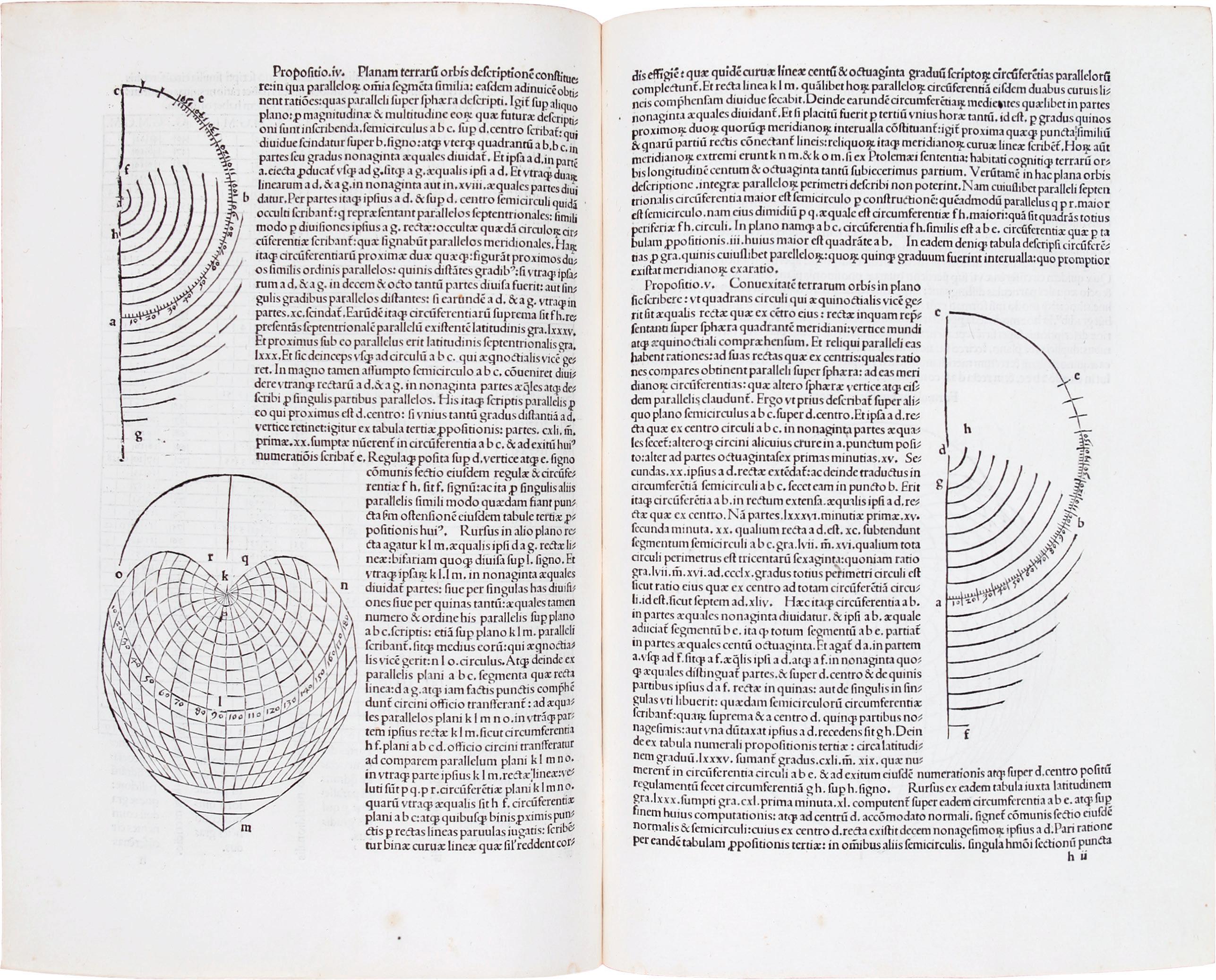

His additions are also notable for describing the concept of the lunar distance method for determining longitude, a method first suggested by Vespucci, with the earliest printed illustrations and instructions for creating and using an instrument for that purpose known as the cross (or Jacob’s) staff, which became the primary method for Portuguese and other explorers well into the nineteenth century. The book also features the first printed description and illustration of the meteoroscope, by way of posthumously publishing one of Regiomontanus’s letters on the subject. The amplification and republication of Werner’s theories by Peter Apian in the succeeding decades, including his projections and use of the cross staff, ensured the enduring influence of this work on navigation and world exploration.
The work is a major landmark in the history of mathematical geography and cartography and an Americanum of note.
European Americana 514/11; JCB (3) I:60–61; Sabin 66479; VD16, P5208. DSB XVI, pp. 272–9. Henry Stevens, Ptolemy’s Geography (London: 1908), p. 49.
THE PARSONS COLLECTION 34
SOLD

EARLY PRAISE OF COLUMBUS
14. CATANEO, Giovanni Maria. Genua. Rome: J. Mazochius, 1514.
Quarto (210 × 145 mm): a –c 4; [12] leaves, including terminal blank. Title within an ornamental woodcut border, woodcut initials. Nineteenth-century half vellum and paper-covered boards. Some soiling to boards. Toning throughout, some dampstaining extending from the lower margin, minor abrasion to lower gutter of title and one other area above, wormtrack in lower blank margin without loss. Contemporary manuscript annotation to title (see below).
The elegiac poem in praise of the city of Genoa, consisting of 446 lines of hexameter, touches on a wide range of the city’s features, including its topography, commercial and industrial life, monuments, customs, and people—notably Christopher Columbus, one of Genoa’s most eminent natives, who gets a special mention for his character, virtue, and world-changing discoveries, on both sides of leaf C2
At this early date, such popular mentions of Columbus were rare and would remain so for most of the rest of the century. Until the end of the sixteenth century, the great explorer’s discoveries passed relatively unnoticed in popular literature, largely eclipsed by Vespucci.
A contemporary manuscript note on the title page appears to be in the hand of someone close to the author, perhaps a friend, who saw the poem before publication. The inscription, added after Cataneo’s name, reads: “quam priusquam imprimeret mihi Romae ostendit et perlegit et iudicio nostro cuicumque.” (“[Giovanni Maria Cataneo] showed this to me before it was printed and read/examined it carefully (taking into consideration) my own opinion.”)
European Americana 514/3; Harrisse (BAV) 75; Sabin 11494.
$8,500
THE DISCOVERY OF AMERICA 35

IMPORTANT SAMMELBAND OF WORKS ON NAVIGATION, ASTRONOMY AND AMERICA
15. SCHÖNER , Johann; and Johannes Regiomontanus. [Sammelband of three geographical works by globemaker Schöner, with an incunable edition of Regiomontanus’s astronomical tables]. Nuremberg: Johannes Stuchssen, 1515–1518; Venice: Petrus Liechtenstein for Lucilius Santiritter, 1498.
Together, 4 works in one, quarto (210 × 150 mm). Detailed collations below. Contemporary blindstamped pigskin over bevelled wooden boards, paper label with manuscript title, original clasps and catches. Endpapers renewed. Title page soiled, three words of extended title abraded with loss. Minor toning and foxing in margins of scattered leaves, heaviest in first title and then decreasing; some minor worming in final title, affecting partial letters/ numbers. Some spotting on final three leaves, heaviest on verso of final leaf, which also shows minor loss to a single letter in colophon. Paper repair at lower margin of final leaf affecting outer rule on recto.
An interesting sammelband of titles: taken together these works show the impact of the great transatlantic discoveries, how they were disseminated in Europe during the second decade of the sixteenth century, and how they affected contemporary geographical and celestial knowledge. The volume contains one of the earliest books to name America; the first book to picture a celestial globe; the first book about a celestial globe (known in only two American copies); and an incunable edition of Regiomontanus’s tables, a work which is positively known to have been employed by Columbus on his fourth voyage in 1504. As they form such an integral group, the three Schöner titles were very likely intended to be issued
THE PARSONS COLLECTION 36
together (although they are rarely found thus in American institutions), and along with the Regiomontanus tables, form an up-to-date introduction to geography and practical astronomy of the sort which would have been of great utility to a sixteenth-century navigator.
Schöner (1477–1547), German astronomer, geographer, globe-maker, mathematician, and printer, is best known for his terrestrial globes: that of 1515, after Waldseemüller (1507), the second to show America, and that of 1524, the first to delineate Magellan’s circumnavigation. The connection between Schöner and Waldseemüller could not be stronger: it is highly suggestive of the intellectual culture of these earliest modern geographers that the volume containing the sole extant copy of the Waldseemüller map (purchased by the Library of Congress) as well as the sole extant copy of Waldseemüller’s Carta Marinha (purchased by the Kislak Collection and housed at the Library of Congress) were originally bound in a book owned by Schöner.
1) Schöner, Johann. Luculentissima quaedam terrae totius descriptio. Nuremberg, Johannes Stuchssen, 1515. Collates: a8 b6 A–B8 C–G4 H8 I–K8 L6; [15], 65 leaves. Woodcut engraved arms of dedicatee on verso of title and full-page woodcut of a globe, full-page woodcut of an armillary sphere, full-page woodcut of a globe of the world (viewed as a map, and not a repeat of Schöner’s globe), errata slip, and numerous white-on-black initials. Adams S-682; Church 37; European Americana 515/16; Harrisse (BAV) 80 (requiring 2 fewer preliminary leaves); Kraus, Americana Vetustissima, cat. 185, 20; Sabin 77804; Stevenson I.82–3.
Scarce first edition of Schöner’s geographical description of the world, and an important Americanum. The author devotes an entire chapter to the recently discovered continent, titling it “De America” (ff. 60–62), thereby adopting and popularizing Waldseemüller’s description of 1507. This is the second work of Schöner, the greatest globemaker of the sixteenth century, and was intended to accompany his globe, extant in a single example in Frankfurt, and generally regarded as the second (after Waldseemüller’s famous world map) to show America. It is curious that while Schöner’s actual globe illustrates America, its reproduction on A1 recto does not. However, Church refers to the present work as “probably the second, after the various editions of the Cosmographiae Introductio, to contain the word America; the first being the Globus Mundi of 1509.” In other words, it is the third work to use the term “America” to designate the New World. “One of the most important works on globes, and an essential source for any attempt to investigate the early production of Johann Schoener, the greatest globe-maker of the sixteenth century” (Kraus).

THE DISCOVERY OF AMERICA 37
continues overleaf
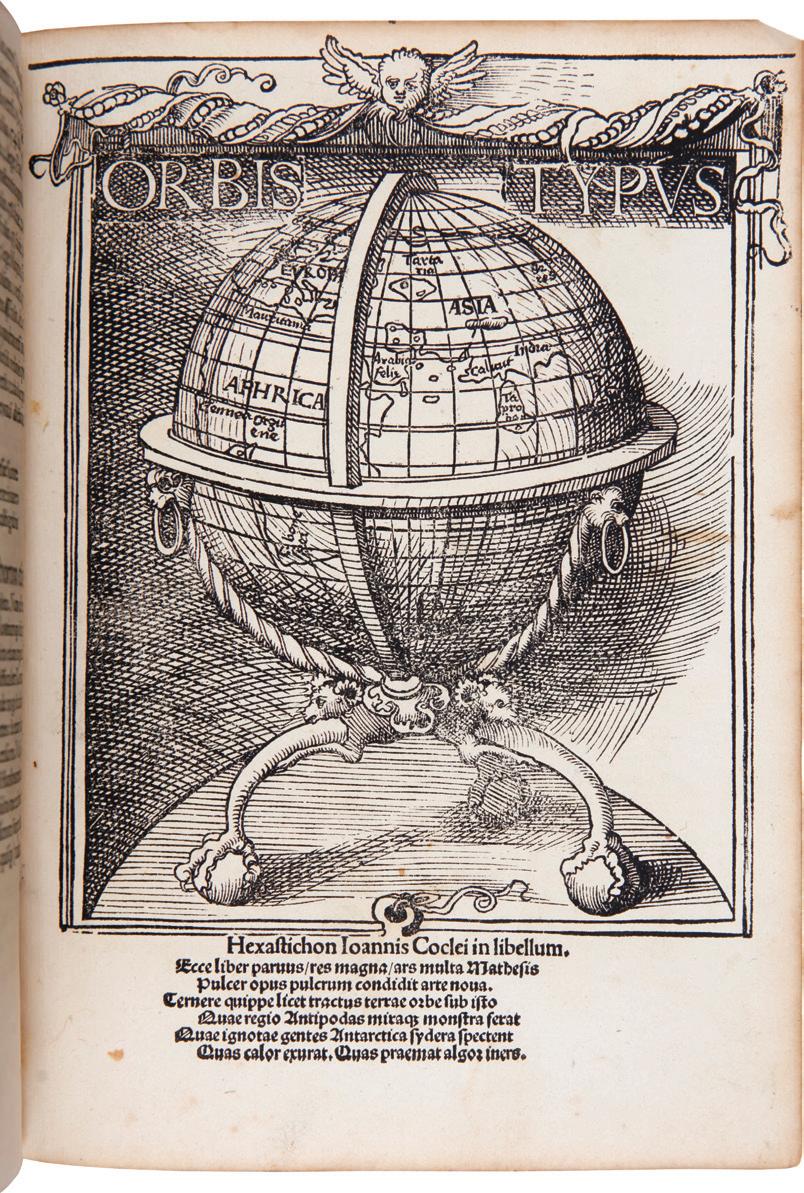
[Bound with:]
2) Schöner, Johann. Appendices Joannes Schoner Charolipolitani in opusculum Globi Astriferi nuper eodem editum. [Nuremberg: Johann Stuchssen, 1518.] A6; [6] leaves. Full-page woodcut of a globe, repeated on verso of last leaf. European Americana 518/13; Sabin 77798. Not in Church. NUC locates Folger, Harvard, NYPL, Wisconsin; and BL.
[Bound with:]
3) Schöner, Johann. Solidi Sphaerici corporis. Nuremberg: Johann Stuchssen, Calends of August, 1517. A8 B6 C8; [22] leaves. Repeat of woodcut arms on verso of title. Not in Church or European Americana, but mentioned in their entry for Appendices above; Panzer VII, p. 458, no. 128; Sabin 77808 (erroneously calling for 23 ff.; he does not cite an actual copy, but states that he takes the title from Coote’s Bibliography; the copy subsequently acquired by the NYPL has 22 ff.) NUC/ OCLC locates only Harvard and NYPL.
Rare first edition of the first book to illustrate a celestial globe, with the extremely rare and almost always wanting theoretical work of 1517 to which it forms an appendix (bound here with the latter preceding the former). The work was conceived as a descriptive manual to accompany Schöner’s celestial globe of the same year, of which the only known copy is in the Landesbibliothek Weimar. It is unclear whether the two titles published a year apart were issued separately or together. Another edition appeared in 1518, by which time one would think they must circulate together. It is conceivable that the theoretical title was first issued in 1517 to circulate independently, and then together with the instruction manual when the latter was ready; however the modest size of each makes one wonder if they were
THE PARSONS COLLECTION 38
not always meant to accompany the 1515 title, as in the present copy. The Solidi Sphaerici corporis is extremely rare; from his erroneous collation, Sabin did not actually see it and says as much; NUC lists New York Public Library and Harvard, and OCLC adds only a single copy of the 1518 (Bell, University of Minnesota). The New York Public Library copy of the 1517 circulates independently, but the Bell copy is bound with the first work of the present sammelband (although it is lacking the third). The Harvard copies of the three Schöner titles are all held separately. The last copy of the second title we have traced was in one of the Horblit catalogues issued by Kraus (cat. 168, item 169). The Kraus entry claims that the only earlier copy they were able to trace was in Leclerc’s Americana sale of 1878. The Horblit/Kraus copy did not contain the Solidi Sphaerici corporis. [Bound with:]
4) Regiomontanus, Johannes. Ephemerides sive Almanach perpetuum. Venice: Petrus Liechtenstein for Lucilius Santiritter, 1498. 2A8 2B2 A–O8; [122] leaves. Goff R110; BMC V.578; Graesse IV.587; Zinner, Regiomontanus, p. 365, n. 304; Stillwell, Science Awakening I.102.
First and sole Santritter edition of the Regiomontanus tables, which give the true positions of the heavenly bodies day by day. These astronomical and chronological tables formed a critical function for Renaissance scientists and navigators: without them no calculations were possible. “Of all the books written and published by Regiomontanus, this is perhaps the most interesting from the standpoint of general history: Columbus took a copy on his fourth voyage and used its prediction of the lunar eclipse of 29 February 1504 to frighten the hostile natives in Jamaica into submission” (DSB XI.351; referring to Morison, Columbus [1942], pp. 653–4). According to the British Museum Catalogue, this is the only title securely attributed to Petrus Liechtenstein before 1501.

THE DISCOVERY OF AMERICA 39
$200,000

VERY RARE EDITION OF THE FIRST THREE DECADES AND THE FIRST PRINTED ACCOUNT OF BALBOA’S FIRST SIGHTING OF THE PACIFIC
16. ANGHIERA, Pietro Martire d’ [Peter Martyr]. De orbe novo Decades. Alcalà: Arnaldus Guillelmus, 1516.
Small folio (270 × 185 mm): a 6 b–g 8 h6 i 8; 67 (of 68) leaves, lacking blank i5. Title printed within ornamental woodcut border, historiated woodcut initials. Nineteenth-century red morocco by Lortic, medallion with arabesque in central panel, double-gilt ruled, with floral motifs at corners, a second double-gilt border at edges, spine in seven compartments with a variant floral tool, and title gilt, all edges gilt, gilt inner dentelles, decorative endpapers renewed. In a marbled paper slipcase. Expert repair to A6, with a few letters or partial letters over two lines in facsimile or refreshed owing to minor loss. Some discoloration in gutter and minor toning. Generally very good.
Rare first edition, first issue, of the first three Decades of Peter Martyr, containing the accounts of Columbus’s voyages, the first printed account of the expedition of Sebastien Cabot to North America, and the first account of the 1513 sighting of the Pacific Ocean by Vasco Nunez de Balboa. A cornerstone Americanum of
THE PARSONS COLLECTION 40
supreme importance and rarity and among the earliest obtainable editions of any of Martyr’s famed Decades.
Peter Martyr of Anghiera (ca. 1457–1525), a Catholic who served as the tutor of the children of Ferdinand and Isabella of Spain, was appointed a member of the Council for the Indies. An intimate of Columbus and contemporary of Vasco da Gama, Cortes, Magellan, Cabot, and Vespucci, Martyr had access to numerous firsthand voyage accounts and became the foremost chronicler of the discovery of the New World.
“Peter Martyr was perhaps the first man in Spain to realize the importance of the discovery made by Columbus. Where others beheld but a novel and exciting incident in the history of navigation, he, with all but prophetic forecast, divined an event of unique and far-reaching importance. He promptly assumed the functions of historian of the new epoch whose dawn he presaged, and in the month of October, 1494, he began the series of letters to be known as the Ocean Decades, continuing his labors, with interruptions, until 1526, the year of his death. The value of his manuscripts obtained immediate recognition; they were the only source of authentic information concerning the New World, accessible to men of letters and politicians outside Spain. His material was new and original; every arriving caravel brought him fresh news; ship-captains, cosmographers, conquerors of fabulous realms in the mysterious west, all reported to him; even the common sailors and camp-followers poured their tales into his discriminating ears. Las Casas averred that Peter Martyr was more worthy of credence than any other Latin writer . . . It is their substance, not their form, that gives Martyr’s writings their value, though his facile style is not devoid of elegance, if measured by other than severely classical standards. Not as a man of letters, but as an historian does he enjoy the perennial honor to which in life he aspired. Observation is the foundation of history, and Martyr was preeminently a keen and discriminating observer, a diligent and conscientious chronicler of the events he observed, hence are the laurels of the historian equitably his” (MacNutt, Introduction to De Orbe Novo: The Eight Decades of Peter Martyr D’Anghera [1912]).
Martyr’s Decades are of primary importance to the early history of America. Written in epistolary form, the First Decade (i.e. ten letters) relates entirely to Columbus and his voyages, as well as those of Nino and Pinzón. Completed around 1501, a manuscript transcript was given to an Italian who printed an abridged and unauthorized piracy in 1504, titled Libretto de tutta la navigatione de Re de Spagna. This work was reprinted in 1507 in the Paesi nuouamente retrouati together with some account of early Portuguese navigation. In the preface to the present work, Martyr complained of it having been printed without his consent. He himself printed the First Decade in 1511 in Seville, which included an account of his expedition to Egypt and an additional account of events from 1501 to 1511.
In 1516, Martyr arranged the publication of the present work, assisted by Latinist Antonio de Nebrija, comprising the second authorized publication of the First Decade and the first publication of the Second and Third Decades; that is, covering the period of over twenty years from Columbus’s first voyage. The Second and Third Decades are of considerable importance, the first of these being

THE DISCOVERY OF AMERICA 41
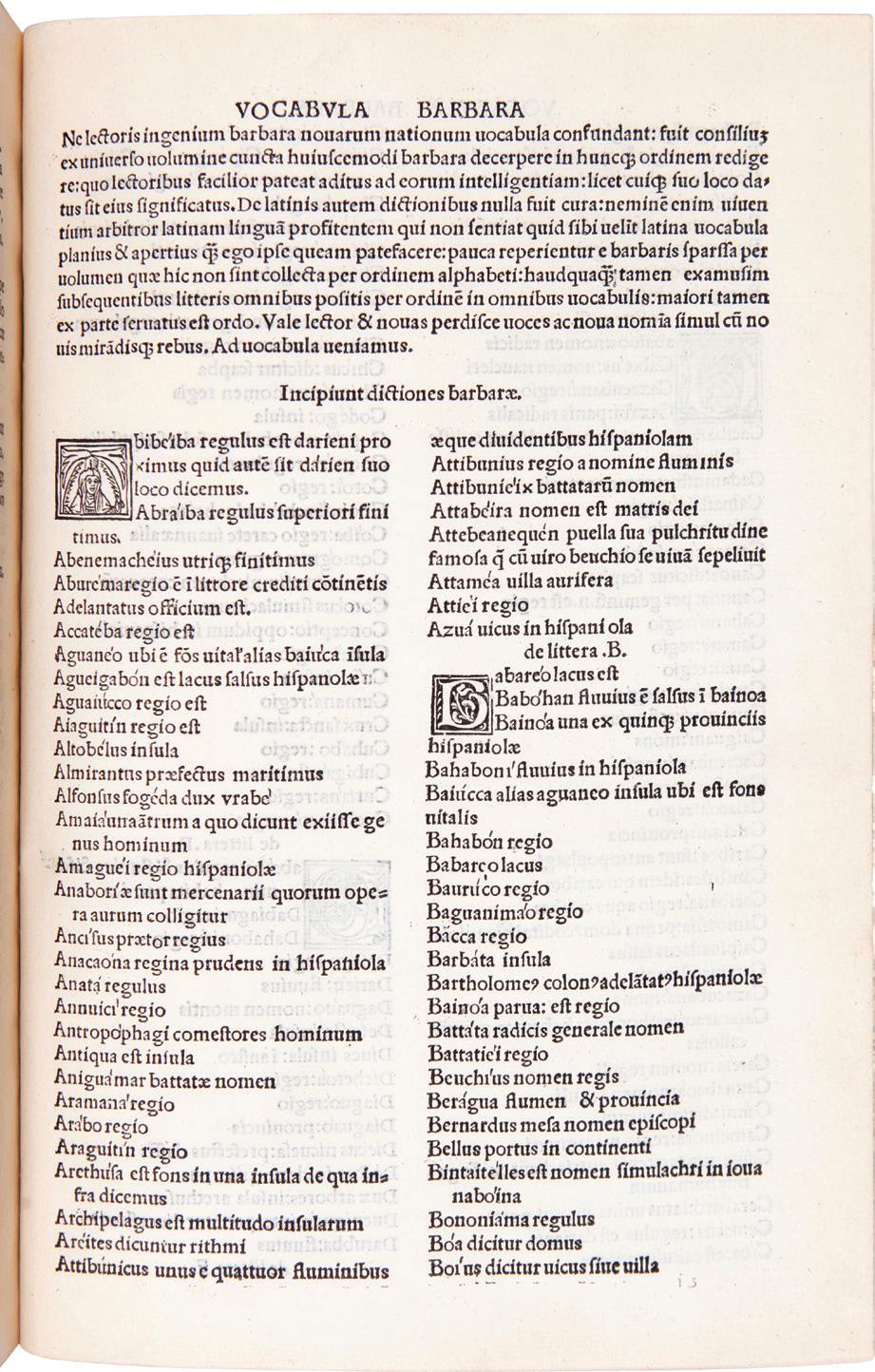
devoted to the exploits of Ojeda, Nicuesa, and Balboa; the other giving an account of the discovery of the Pacific Ocean by Balboa (communicated to Martyr by Balboa himself), of the fourth voyage of Columbus, and furthermore of the expeditions of Pedrarias, Cabot and others. Notably it includes the first attempt at a vocabulary of native American words, headed “Vocabula Barbara.”
Two issues of the 1516 Decades are noted: with or without a 16-leaf appendix concerning his travels to Egypt known as the Legatio Babylonica. The text of the title page of the two issues differs, with one referencing the presence of the Legatio. As that section supplements the preceding, it is generally assumed that examples without the section, or reference to it on the title page, are the first issue. We find no other example of the 1516 Peter Martyr on the market since H. P. Kraus offered one in his famed catalogue Americana Vetustissima (Cat. 185, item 21) also without the Legatio: “It is the present publication of the first three Decades which really made Martyr’s reputation and gained him an official position as member of the Council of Indies.”
Arents 2; Church 39b; European Americana 516/1; Harrisse (BAV) 88; JCB (3) I:66; Medina (BHA) 53; Palau 12590; Sabin 1550; Streeter Sale 7; Streeter, Americana-Beginnings 4.
SOLD WITH ONE OF THE EARLIEST PRINTED DESCRIPTIONS OF INDIGENOUS CANADIANS
17. EUSEBIUS CAESARENSIS; [Johannes Multivallis;] and others. Episcopi Chronico[n]. Paris: Henricus Stephanus [i.e. Henri Estienne], 1518.
Quarto (229 × 170 mm): a–b 8 c 4 A–X 8 Y 6; [20], 175 leaves [i.e. 173, with errors in foliation as issued]. Title within ornamental woodcut border. Text printed in red and black with woodcut initials throughout. Later vellum with slightly yapp edges, manuscript spine title. Vellum bowed and somewhat stained. Scattered foxing and soiling, occasional dampstaining to margins, lower corner of final leaf repaired, not touching text.
This second edition of this universal history of secular and ecclesiastical events from the time of Abraham up to 1511, includes entries on the discovery and early exploration of the New World. Events through the year 325 are taken from the Chronicron of Eusebius, and continued thence to the mid-1400s by Saint Jerome, Mattia Palmieri of Pisa, and others. The chronicle has been edited and extended from Palmieri’s time in the mid-1400s to 1512 by Johannes Multivallis, and was first published in this form by Henri Estienne the elder in that year.
While the exploits of early explorers such as Alvise Cadamosto are listed among ecclesiastical and secular successions, natural phenomena, and wars, the first mention of the New World does not come until 1509. The entry, one of the longest in
THE PARSONS COLLECTION 42

the entire chronicle and filling twenty lines of text, is of the greatest importance and describes the arrival in Rouen of seven indigenous Americans, most likely those brought from Canada by the French explorer Thomas Aubert, who visited Newfoundland in 1508. The description in this work claims (in translation) that the seven were brought to Rouen “from that island called the New World, with their small boat [i.e. a canoe], costumes, and weapons.” They are said to have markings “drawn like pale veins from the ear to the middle of the chin,” hair which is “black and long, like a horse’s mane,” and to have no religion. The text also describes their dress (“nude or garbed in the skin of animals such as bears, deer, or sea cows”), diet (“Their food: Roasted meat. Drink: Water. They do not use bread, wine, or money”), and arms (“bows strung with cords of animal intestines or sinew”).
This second printing is largely identical to the first Estienne edition of 1512, excepting a few minor typographical changes and the incorporation of the first edition’s errata. A beautifully printed post-incunable, including a remarkably early description of Canadian First Nations.
Adams E1073; European Americana 518/3; Harrisse (BAV) 71; Harvard French Sixteenth Century Books 217; Renouard, Estienne 9; Sabin 23114.
$6,500

THE DISCOVERY OF AMERICA 43
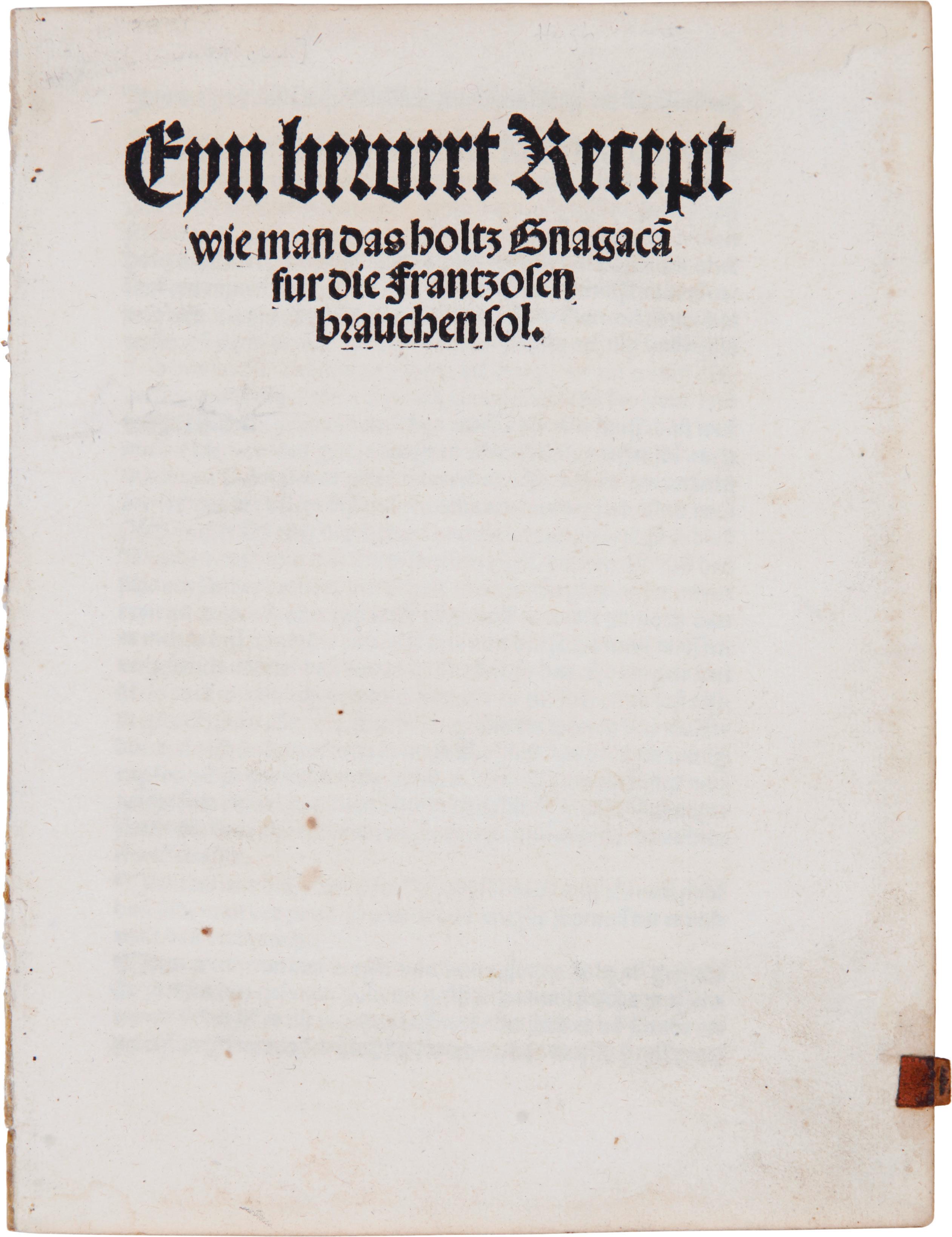
THE PARSONS COLLECTION 44
ONE OF THE EARLIEST MEDICAL WORKS RELATING TO AMERICA
18. (MEDICINE.) Eyn bewert Recept wie man das Holtz Gnagacam fur die Frantzosen brauchen soll. [Nuremberg: J. Gutknecht, 1518.]
Quarto (198 × 150 mm): [4] leaves. Disbound. In a cloth chemise and half morocco and cloth slipcase, spine gilt. Early leather tab on fore-edge of first leaf. Very slight soiling and dampstaining in margins. A very good copy.
An extremely rare copy of one of the earliest pamphlets promoting the use of the guaiacum wood as a cure for syphilis and providing specific instructions for the plant’s use. Printed circa December 1518, the work was probably published the same month and year as an equally rare Augsburg pamphlet with a similar title, Ain Recept ecept von ainem holtz zu brauchen fur die Kranckhait der Frantzosen. Both pamphlets are only recorded at the same single location in the United States. The sole earlier work specifically about guaiacum noted in European Americana is Niccolò Campani’s Lamento . . . sopra il mal fancioso, a description of the “French Disease” in verse printed in Siena, circa 1515.
Although works about syphilis were published even prior to 1500, this pamphlet’s directions for curing the disease with the American plant guaiacum are among the first to be published, predating Ulrich von Hutten’s popular instructions for the cure which first appeared in 1519. John Alden notes in the preface to the first volume of European Americana that the “appearance in Europe of syphilis at the end of the 15th century seems, all too inexorably [from America], due to its transmission from Hispaniola, beginning with Columbus and his men . . . The consequences for the bibliographer will be readily evident, for as the armies of European powers traipsed across the Continent they spread this new scourge, reflected in the writings of the period . . . And even if it were at best dubiously American, treatment for it usually employed medicines derived from American sources, chiefly Guaiacum . . . introduced from the Caribbean.” Today, the American origin of the disease is not disputed.
The present pamphlet includes itemized instructions for soaking and boiling the wood, drinking the resulting liquid, and inhaling smoke from the wood-fire. A regimen of medication, purging, fasting, and rest is suggested for a period of twenty-five days. The patient is not to be agitated, but should be surrounded by cheerful company. Once recovered, the patient can go outside, but sex is not allowed for the following two months. Other recommendations regarding diet are also provided.
European Americana cites but a single example at the New York Public Library. OCLC adds three examples in Germany. We find no examples on the market in over half a century. An extremely rare medical imprint regarding syphilis and its cure by means of guaiacum.
European Americana 518/2; First Images of America II, pp. 835–36.
$37,500
THE DISCOVERY OF AMERICA 45

THE FIRST NAVIGATIONAL GUIDE TO THE AMERICAS, AND THE FIRST BOOK IN SPANISH RELATING TO AMERICA
19. ENCISO, Martín Fernández de. Suma de geographia q[ue] trata de todas las partidas & provincias dek mundo: en especial de las indias, & trata largame[nt] e del arte del mare. Seville: Jacobo Cromberger, 1519.
Small folio (275 × 205 mm): A–B 14 C–H 8; [76] leaves. Terminal blank possibly supplied. Full-page woodcut on title showing an armillary sphere within a woodcut border, two fullpage woodcut diagrams, several woodcut initials in text. Early Spanish calf, central panel showing unidentified, unusually small medallion coat of arms, anchor-shaped crosses above and below, and intertwined floral motifs at corners; bordered by rows of contrasting antique figures and floral motifs or ruled blank rows. Skillfully rebacked in the nineteenth century, with title and author gilt on spine, nineteenth-century marbled endpapers. Some wear to joints and corners. Some minor soiling in lower right corner of title, initial and a few other leaves. Provenance: Augustus Henry, Duke of Grafton (exlibris 1769); and nineteenth-century exlibris of the Dukes of Gloucester; ink stamp of the Madrid bookseller Gabriel Sanchez on verso of second front flyleaf.
THE PARSONS COLLECTION 46
A work of surpassing importance, the first edition of the first practical guide to sailing in American waters, the first navigational manual printed in Spain, and the first book printed in Spanish relating to America. This historical account by a participant is the foundation for any collection on navigation to the New World.
Martín Fernández de Enciso (ca. 1470–ca. 1528), geographer and conquistador, was a native of Seville, and would have been aware of the details of the earliest voyages to the Indies as a young man. Although he probably went earlier, he can be definitely placed, well established as a lawyer and trader, in Hispaniola by 1508. In 1509 and 1510 Enciso joined expeditions of Alonso de Hojeda along the north coast of South America and then to Panama (it was on this expedition that Balboa first saw the Pacific). He continued to be involved in the Spanish conquest of the area and served as an aid to the first governor there, a position he occupied in 1514. Sometime after this he returned to Spain and published the Suma in 1519.
Enciso was the first writer to narrate the history and navigation of the New World based on broad personal experience of himself and others. Columbus and Vespucci had briefly told the story of their coastal voyages, and Peter Martyr had published, in 1516, the first of his collection of accounts which had come back to him in Spain, where he was an official of the Spanish court. But Enciso’s book was based on his extensive personal experience of perhaps a decade of living and voyaging in the Indies, and the gathering of much oral information from others, possibly including Columbus’s pilot, Juan de la Cosa. “Using a great variety of both oral and written sources plus his own experience, Enciso compiled a practical book with useful information, especially for pilots” (Delgado Gomez).
Enciso’s work was immediately recognized as invaluable, and it was used to instruct the young Charles I, who ascended the Spanish throne the year after its publication. Two other editions followed, in 1530 and 1546. Numerous writers on New World history have praised it both as a navigational guide and an historical work. “A great hydrographer and explorer, his work is invaluable for the early geographical history of this continent”(Harrisse).
Enciso’s work has been extraordinarily rare in the market in the last fifty years. In that time, to our knowledge only three copies have changed hands. The Harper–H. V. Jones–Rosenbach–Henry Taylor copy was given to Yale by Taylor’s estate in the late 1960s. The Harmsworth–Horblit–Frank Streeter copy was bought by Horblit at the Harmsworth sale in 1950, then by Streeter at the Horblit sale in 1974. It reappeared at the Frank Streeter sale at Christie’s in 2007, where it realized $288,000 and is now in a private collection. A third copy, the Sir Thomas Phillips–Lord Hesketh copy, was sold by the William Reese Company in 2011.
A foundational work in the history of navigation and the history of the Americas. Church 42; European Americana 519/4; Harrisse (BAV) 97; JCB (3) I:73; Palau 88433; Sabin 22551. Delgado-Gomez, Angel: Spanish Historical Writing about the New World, John Carter Brown Library, 1992, item 5.
$300,000
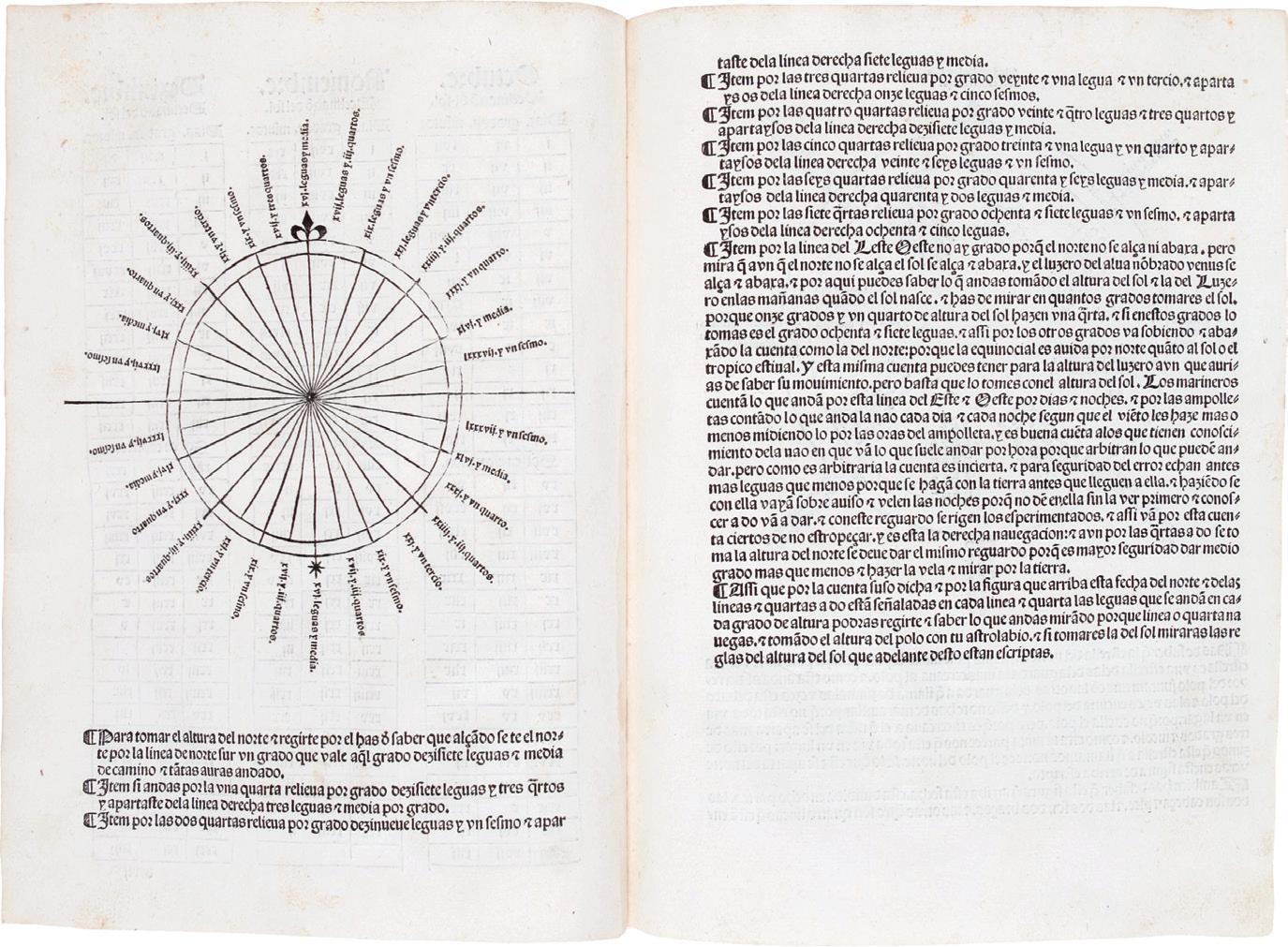

THE DISCOVERY OF AMERICA 47

THE PARSONS COLLECTION 48
THE FIRST MAJOR TREATISE ON GUAIACUM AND THE TREATMENT OF SYPHILIS
20. HUTTEN, Ulrich von. Von der wunderbarliche[n] artzney des holtz Guaiacu[m] genant. Strassburg: Johann Grüninger, 1519.
Quarto (197 × 145 mm): A–J4 K6; [42] leaves. Half-page woodcut on the title page of a salesman of guaiacum and three potential customers, woodcut initials. Early calf, tooled in blind, remnants of ties. In a cloth chemise and half morocco box and cloth slipcase, spine gilt. Title page slightly soiled at margin, occasional moderate soiling in margins, occasional paper repairs in lower corners of text (not affecting text), a few contemporary manuscript notations in lower margins. A very good copy. Provenance: Z.–K. (small inked stamp on title).
The rare first German edition of Hutten’s work on the discovery of the virtues of guaiacum officinale—a species of tree in the caltrop family, Zygophyllaceae, native to the Caribbean and the northern coast of South America—and its use of as a cure for syphilis, translated from the first Latin edition of the same year. Although works about the syphilis were published even prior to 1500, instructions for curing the disease with the resin were not published until December 1518. Hutten’s directions remained in print throughout the 1500s, with seventeen editions, translations, and reprints in other publications published in Latin, German, French, and English.
Alden remarks on the likelihood of the spread of syphilis having American origins (see note to item 18) and that guaiacum was used to treat it. He adds: “Not in fact without valid therapeutic uses, its [guaiacum’s] popularity as a specific remedy owes far more to the press-agentry of Ulrich von Hutten and Lorenz Fries than to its actual merits, and offers a curious footnote to history. To compensate the great Augsburg family of international merchant bankers, the Fuggers, who had provided funds to help purchase his election as Holy Roman Emperor, Charles V granted them a monopoly for the importation of Guaiacum from the Spanish Indies. In turn, the family set up ‘hospitals’ utilizing it to treat syphilis, at the same time commissioning Hutten (better known as a poet and theologian) to write his De Guaiaci Medicina (Mainz, 1519), advocating its use, a work widely reprinted and translated.”
A scarce medical imprint regarding syphilis and its cure by means of guaiacum. European Americana records three locations in the United States, at the National Library of Medicine, James Ford Bell Library, and New York Public Library, and adds two European locations, at the Bayerische Staatsbibliothek in Munich and the Bibliothèque Nationale et Universitaire in Strasbourg.
Benzing (Hutten) 111; European Americana 519/8; Ritter (Strasbourg) 1226; Sabin 34095 (Latin edition).
$27,500
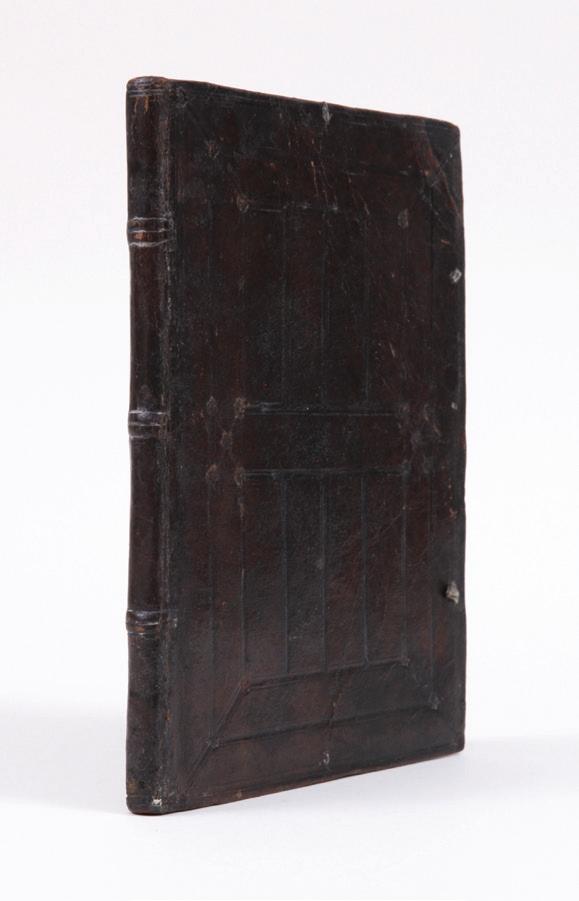
THE DISCOVERY OF AMERICA 49

EXTRAORDINARY RARITY: THE FIRST PRINTED ACCOUNT OF THE DISCOVERY OF MEXICO
21. CORTÉS, Hernan. Ein Auszug ettlicher sendbrieff dem aller durchleüchtigisten grossmechtigiste[n] Fürsten und Herren Herren Carl römischen und hyspanische[n] König [et]c. Nuremberg: Friedrich Peypus, 1520. Quarto (200 × 146 mm): a–b4; [8] leaves, including terminal blank. Three-quarter woodcut on title page representing armed men landing on an island. Small ink annotations to title. Disbound. In a cloth chemise and black calf clamshell case, spine gilt. Title leaf trimmed in upper blank margin. Several light waterstains in margins, otherwise a broad-margined, good copy.
This very rare German news sheet is the sole edition of the first printed account of the discovery of Mexico, and of the Cordova expedition of 1517. Since it includes a German translation of the Vera Cruz Council’s letter to Charles V, widely attributed to Cortés, it is cited by Wagner as “the earliest known printed account” of Cortés’s expedition. Among discovery accounts of mainland America, the work
THE PARSONS COLLECTION 50
can only have been preceded by Juan Diaz’s account of the Grijalva expedition published the same year. This is the earliest obtainable document relating to Cortés, preceding the 1521 account by Peter Martyr and the more widely available 1524 edition of the second letter.
The present letter was written in July 1519, and gives details of the first three Mexican expeditions by Cordova (1517), Grijalva (1518) and Cortés (1519). It describes the first contacts and battles with and conversions among the indigenous population, the founding of Villa Rica de Vera Cruz, and a description of the land and its inhabitants. With vivid accounts of the wealth of the Aztecs and the cruelty of their customs—human sacrifice in particular—the document shows Cortés seeking to build support and legitimacy for his impending military conquest. The letter was translated in 1929 in its entirely by Wagner, who was the first modern scholar to understand its importance.
The first explorer to reach Mexico was Francisco de Cordova, who set out from Fernandina (now Cuba) in 1517 on an enslaving expedition. He met a hostile reception and returned to Fernandina wounded and having lost twenty-six of his men, but with tales of natives bedecked in gold. A second expedition under Juan de Grijalva in 1518 was more successful, exploring much of the Mexican coastline and sending back to Fernandina gold trinkets and other ornaments. Upon receiving these, Fernandina’s governor, Diego Velázquez, ventured a third expedition under the command of Hernando Cortés. As Cortés prepared for departure, Velázquez had second thoughts about putting such a personally ambitious man in command, but before he could rescind the order, Cortés set sail on February 10, 1519.
In the next five months, Cortés gathered information on the wealth and political structure of what he still believed was an island, aided by the translation services of a native woman and a shipwrecked Spaniard conversant in the local language. His party fought skirmishes with the indigenous peoples, but also made the first successful diplomatic and missionary overtures. A delegation from Montezuma brought rich gifts of gold and silver. “The Spaniards realized that this region was rich in all the necessities of life so they decreed that they would live in the small town . . . which they called ‘Vera Cruz, ’ They chose several among their number who administered daily with peace and justice. They decided to send several messengers with letters to the Christian king . . . and they sent along all the gold and treasures that they had obtained up to that time” (Wagner, p. 196).
The present work is an edited translation of the manuscript letter which the cabildo, or city council, sent to Charles V along with that gold and treasure. An authenticated manuscript copy of the letter exists in Vienna, where it was rediscovered by William Robertson compiling his History of America (1777). Variously known as the “Letter of the Regimiento” or the “Cabildo Letter,” it is thought to have been dictated—if not actually written—by Cortés: not only was he chief administrative officer of the cabildo, but the entire council was essentially his political instrument. The manuscript of the Cabildo Letter was not published until the nineteenth century.
continues overleaf
THE DISCOVERY OF AMERICA 51

Elliot writes: “The most important document carried to Spain [by Cortes’s emissaries in 1519] was the letter from the new municipality of Vera Cruz, addressed to Charles and Juana. This letter, which customarily replaces Cortes’s missing First Letter, bears all the stamp of his personality, and was no doubt written largely to his dictation. It should therefore be read, as it was written, not as an accurate historical narrative but as a brilliant piece of special pleading, designed to justify an act of rebellion and to press the claim of Cortés against those of the governor of Cuba.”
“For all of Cortés’ eager insistence that he was providing a ‘true’ relation, he displayed a masterly capacity for suppression of evidence and ingenious distortion. Great care was taken to play down the expeditions of Hernandez de Cordoba and Grijalva, and the awkward fact that the latter had taken formal possession of the land was quietly ignored.” Cortés, by contrast, appears as “a man passionately determined to serve God and the king by extirpating idolatry, converting the heathen and conquering rich new lands for the Crown of Castile” (Elliott, introduction to Cortés, Letters from Mexico, pp. xx–xxi).
The fate of the Cabildo Letter is documented in some detail. The ship bearing it and the gifts for the king arrived in November 1519, but it was only in early April 1520 that it was presented with Cortés’s offering in Valladolid. Immediately thereafter Charles headed for Germany, where he was crowned King of the Romans. The relocation of Charles’s court suggests one explanation for why the letter bearing such sensational news was printed first and solely in Germany.
Another explanation is proposed by Wagner, who suggests that the first letters by Cortés were suppressed in Spain through the efforts of courtiers loyal to Velázquez, Cortés’s rival in the Indies. It is known that these efforts succeeded in seizing large sums of money that Cortés’s emissaries carried with them, and in placing an embargo on any ships leaving for Mexico. Furthermore, the second Cortés letter to Charles—there would be five in total, the first one, sent simultaneously with the Cabildo Letter being lost—was only published in Seville in 1522 after a one-year delay, and coincided with the long-fought-over appointment of Cortés as captain-general of New Spain. All subsequent Cortés letters were published in Spain the year of their arrival. Until 1522, however, no account of Cortés’s expedition was
THE PARSONS COLLECTION 52
published in Spain, although several appeared in German, Italian and Latin. Of these, the present report is the first, dated March 17, 1520.
The text was evidently redacted from the original Cabildo document, because its date—July 6, 1519—is curiously not that of the Cabildo document (July 10), but rather that of the itemized list of gifts sent to the king which follows the letter. The translator (identified in the end only as P. C.D. and still anonymous) divides the report into two sections, the first an account of the three first expeditions to Mexico, with the largest part devoted to the exploits of Cortés, the second part “concerning the customs and habits of the people and the fertility and the buildings of this land.”
This section emphasizes the potential riches that are to be found in this newly discovered land, as well as the barbarity of local religious customs: “When they have a great desire which they wish the idols to grant, they bring a young child and place it before the idol, and then take out its beating heart and offer it as a sacrifice. They do this so often that no year passes in which there are not 5,000 people killed in this way. Inasmuch as these islanders are so assiduous in their service of the gods whom they believe to be divine, one may expect them to be very devout when they are taught the divine creed” (Wagner, p. 197).
The woodcut on the title page shows a ship of armed Europeans landing on the shores of a mountainous land. On the beach facing them stands a group of bare-chested men and women dressed in feathers, adorned with large earrings, their bows and spears resting on the ground. In the foreground, hidden from the Europeans by a cliff, another group of natives—wearing a hybrid form of armor featuring both codpieces and feathered sleeves—appear ready to attack, pointing their lances at the invaders. Notwithstanding its ethnographic content, the illustration is decidedly understudied: it does not appear in Sturtevant’s article on the earliest visual depictions of America.
In 1524, the same Friedrich Peypus in Nuremberg published a Latin account of the discovery of Mexico, supplementing material from the present edition with information from Cortés’s Second Letter. Wagner has identified two further undated German-language reports on the discovery, both incorporating information on Mexico City and datable therefore to after 1520.
We note the following copies only: John Carter Brown Library; Lilly Library; New York Public Library; British Library; Royal Danish Library; Österreichische Nationalbibliothek; Staats-und Stadtbibliothek Augsburg; Universitatsbibliothek Johann Christian Senckenberg; and Universitatsbibliothek LMU Munchen.
European Americana 520/5; Harrisse (BAV) 105; Palmer 286; Sabin 2442 & 22086. Henry R. Wagner, “Three Accounts of the Expedition of Fernando Cortés, Printed in Germany between 1520 and 1522,” The Hispanic American Historical Review, Vol. 9, No. 2 (1929), pp. 176–212. Boies Penrose, Travel and Discovery, 96–98.
THE DISCOVERY OF AMERICA 53
SOLD
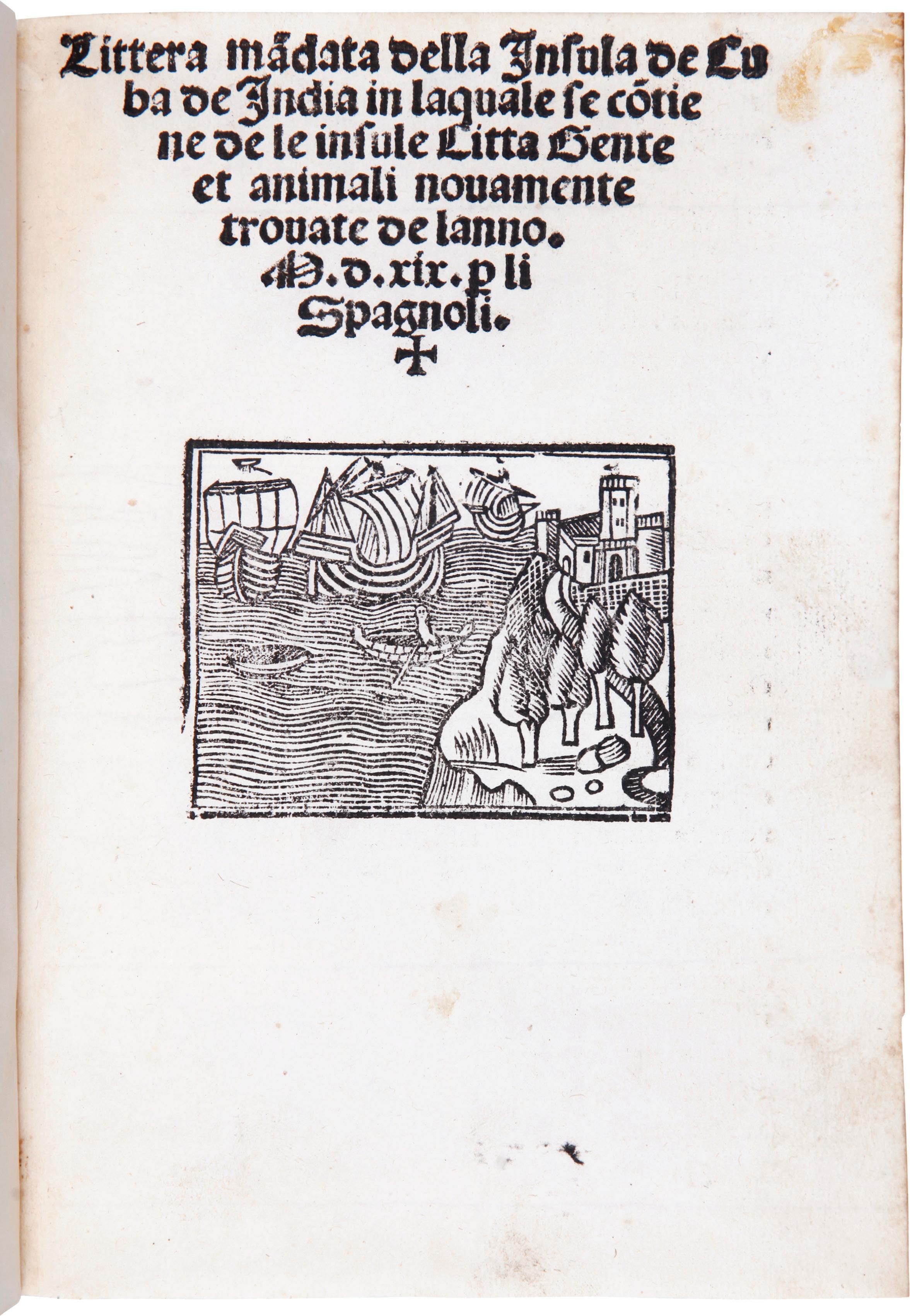
THE PARSONS COLLECTION 54
THE FIRST PUBLISHED EYEWITNESS DESCRIPTION OF THE NORTH AMERICAN MAINLAND: ONE OF ONLY FOUR KNOWN COPIES
22. DIAZ, Fr. Juan. Littera mandata della Insula de Cuba de India in la quale se contie ne de le insule Citta Dente et animali novamente trovate de l’anno
M.D.XIX. p. li Spagnoli. [Venice:] 1520.
Quarto (193 × 140 mm): A–B4; [8] leaves. Woodcut initial, woodcut on title showing a lone man in a rowboat approaching a shore, with three galleons in background. Later vellum. Vellum a bit rubbed, soiled, and wrinkled. Light tanning, trimmed a bit close at the top edge, otherwise a fresh and clean copy.
The fourth known copy worldwide, and believed to be the only one in private hands, of the earliest published account of any exploration of the North American mainland, an eyewitness account of the expedition of Juan de Grijalva to the Mexican coast in 1518: an Americanum of the greatest possible interest and importance. By 1517 persistent rumors were reaching the Spanish in the Caribbean of a large and wealthy Indian civilization on land to the west of the island of Cuba. By that time, the Spanish had explored and colonized most of the islands of the Caribbean and also investigated the northern coast of South America. Of the North American mainland only Florida had been investigated, although nothing regarding it had been published. Grijalva obtained permission to explore to the west of Cuba in the hope of making contact with the rich lands the Spanish hoped to find there. He gathered his expedition at Santiago in Cuba, and sailed with four ships on January 25, 1518. He preceded along the coast of Cuba in a leisurely fashion, and on May 1 sailed westward toward Yucatan.
The Grijalva expedition made landfall at the island of Cozumel on May 3, 1518. He spent all of the summer and into the fall exploring up and down the coast. The present account is entirely devoted to that period through October, when shortages of supplies and loss of anchors forced a return to Cuba. In the course of these five months, Grijalva and his men became well acquainted with the indigenous peoples of the region and some aspects of their civilization. They observed and described a number of native buildings and temples, including one decorated with “various statues of apes and bears”; they discovered offerings in blood and recently killed human corpses with hearts cut out. They were able to trade for food, and were pleased with the variety of vegetables and animals available. The land itself was praised for its richness. After friendly initial contact, the Spanish began to press for gold and traded for some ornaments, but the indigenous leaders began to demand that the Spanish leave. This led to a battle in which a number of natives were killed and some Spanish wounded. The Spanish then managed to ransom their prisoners for further gold.
The Spanish continued up the coast, discovering further evidence of human sacrifice but encountering better luck in trading and obtaining gold. The author thought that Grijalva could have obtained even more treasure if he had been bolder, and bitterly comments on the amount of gold left behind. In fact, Grijalva probably saved his expedition by keeping his men restricted to their ships, recognizing that the lust for gold could soon scatter them and make them easy targets. After receiving
THE DISCOVERY OF AMERICA 55

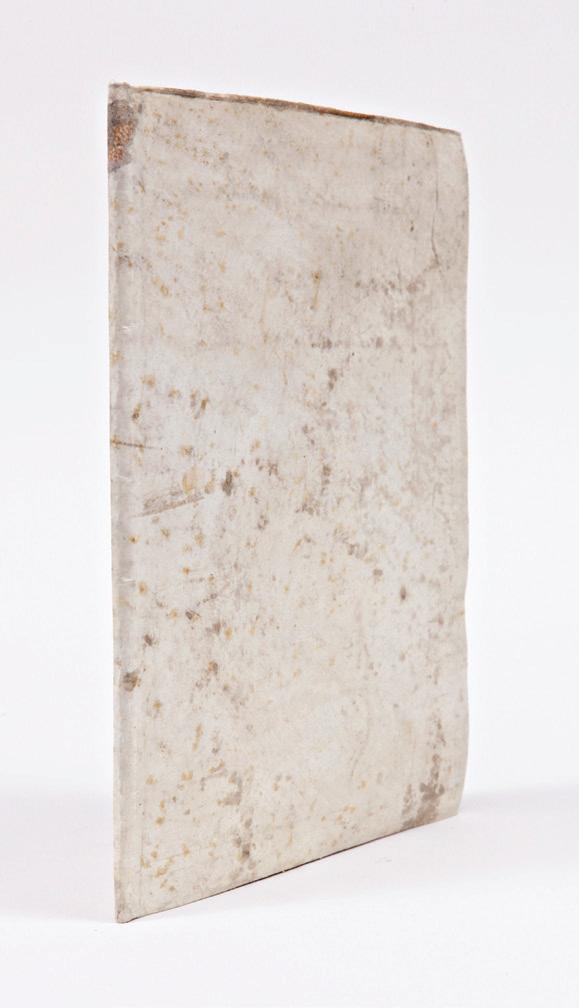
“thirty-three gold axes weighing about forty pounds” and concluding a peace treaty, which the native peoples signified by biting their tongues and spitting out blood, Grijalva took his expedition back to Cuba.
According to Wagner, Diaz’s manuscript was taken to Spain shortly after his return to Cuba by Benito Martin. From this original manuscript, whether directly or at some remove, three different versions, all abridged but in different ways, were published in 1520: twice translated into Italian (the present Littera and as an appendix to Lodovico Varthema’s Itinerario) and once into Latin (Provinciae sive Regionis, published in Valladolid). The priority between the present separately issued Italian edition and the Latin translation is unclear. According to Wagner, the Latin edition preceded the present based on the following argument: King Charles I of Spain became Emperor Charles V of the Holy Roman Empire on June 28, 1519 and the news reached Charles in Barcelona by July 24. In some passages, the Littera refers to Charles as king, but in others as emperor. According to Wagner, the Provinciae contains no reference to Charles as emperor and he therefore argues that the Provinciae was published before the election was known, and the Littera afterwards. In fact, although Wagner is correct in stating that the body of the text of the Provinciae does not refer to Charles as emperor, the prefatory letter by the translator does. Furthermore, it is conceivable that the news was known in Italy before it was in Spain. Indeed, the fact that the Littera refers to Charles inconsistently (variously as king or emperor) may suggest, as Wagner himself notes, that the document was written before the election and revised after the fact (but only selectively). To conclude: the relative chronology of these two works is less clear than Wagner makes out. The second Italian language version that appeared as an appendix in the Varthema was likely published after the other two.
Only three other copies of the Littera are known: Bibliotheca Marciana, Venice; Biblioteca Universitaria di Bologna (Aldrovandi’s copy); and William Scheide Collection, Princeton University (sold to Scheide by the William Reese Company in 1993). The present example is the only copy in private hands of the first substantial account of the exploration of the mainland of North America, an account of the greatest possible interest for its historical, ethnological and archaeological information, marking a turning point in the history of the world, the beginning of the end of the great Aztec empire.
European Americana 520/10; Harrisse (BAV), Additions 60; Henry R. Wagner, The Discovery of New Spain in 1518 by Juan de Grijalva (Pasadena, 1942); Sander 2259 (s.v. Cuba); Essling 2472; Rudolf Hirsch, “Printed Reports on the Early Discoveries and their Reception” in Chiappelli et. al., First images of America, vol. II, following 9.552, see # 87; Penrose, Travel and Discovery, pp. 96–8.
SOLD
THE PARSONS COLLECTION 56
ONE OF THE EARLIEST ACCOUNTS OF THE NORTH AMERICAN MAINLAND
23. ANGLIARA, Juan de. Die Schiffung mitt dem Lanndt der Gulden Insel gefunde[n] durch hern
Johan vo[n] Angliara Hawptman des Cristenlichen
Kunigs vo[n] Hispania. [Augsburg: J. Nadler, 1520.]
Quarto (175 × 130 mm): [3] leaves. Title page with floral woodcut border in four sections. Nineteenth-century three quarter vellum and marbled boards. In a cloth chemise and half morocco and cloth slipcase, spine gilt. Minor stains, repair to fore-edge of title. Very good. Beroltinenti Library (stamp on verso of title, with later withdrawal stamp).
The first and only German edition of a tract ostensibly describing discovery of new lands in the New World. Of the author, wholly unknown to most bibliographers, Harrisse suggests that Peter Martyr was intended given the similarity of his Anghiera to the stated author’s “Angliara.”
The author describes himself as an Italian captain of a Spanish vessel departing for Calcutta. Following a storm, they reach an island on April 23, 1519, communicate with the inhabitants, visit a capital city full of gold, and eventually return to Spain. European Americana states that the island is possibly a description of Peru; if this were the case, it would be the earliest description of Peru in any form by several years. In fact, the text seems more closely related to the pamphlet by Juan Díaz, Littera Mandata dell Insula de Cuba de India, the first published account of Juan de Grijalva’s expedition to the Yucatan, the first substantive contact between Europeans and native Americans of the mainland of North America. The Díaz account was first published in Italian and Latin in 1520 (see previous item). Angliara’s fabulous narrative is perhaps another form of the extraordinary news of initial contact by Spanish explorers with the great civilizations of the New World.

First published in Venice the same year, the Italian edition is known only in the copy at the British Library; copies of the present German edition are located at the Huntington, Lilly Library, New York Public Library, John Carter Brown Library, and British Library.
An early Americanum of great rarity, we are aware of only a single example on the market in the last half century.
Church 44; European Americana 520/3; Harrisse (BAV) 102; JCB (3) I:75; Medina (BHA) 100n; Palau 12666; Sabin 1560.
$75,000

THE DISCOVERY OF AMERICA 57

WITH THE EARLIEST OBTAINABLE MAP TO NAME AMERICA
24. SOLINUS, Caius Julius; and Petrus Apianus. Joannis Camertis, in C. Iulii Solini [Polyhistoria, Greek letters] Enarrationes. Vienna: Joannis Singrenius, 1520.
Folio (313 × 210 mm): π8 a4 b–z6 A–E6 F4 2a–b6 2c4; [16], 336, [36] pp., including the terminal blank. Double-page folding woodcut map. Recased in contemporary half pigskin and beveled wooden boards, rebacked with the original spine laid down, early brass clasps, endpapers renewed. Early manuscript note on front board. Boards a bit rubbed and soiled. Old ownership note in upper margin of title page very faded. Pale waterstain in gutter of a few signatures. Map trimmed at top and bottom outside the woodcut border but affecting the words “Septentrio” and “Meridies” in the upper and lower margin; creases from old fold with minor discoloration in right margin.
Caius Julius Solinus’s Polyhistor contains the famous double-page cordiform map by Peter Apianus: a cornerstone of American cartography and “the earliest obtainable map to name America” (Burden).
Apianus’s world map was issued bound into the 1520 Camertius edition of Solinus’s Polyhistor, a classical work of geographical history largely based on works by the Elder Pliny and Pomponius Mela. The map depicts two large landmasses west of Africa: the little-known North American coast, here simply called “Terra incognita,” and the larger, more detailed South American continent, with the region’s new name prominently displayed within a statement praising the voyager
THE PARSONS COLLECTION 58
who discovered it: “Anno d 1497 haec terra cum adiacentibus insulis inuenta est per Columbum Ianuensem ex mandato Regis Castellae america prouincia.”
The map was modeled by Apianus after Waldseemüller’s original cordiform wall-map of 1507. Waldseemüller’s map, known in a single copy acquired in 2002 to great acclaim by the Library of Congress, was the first cartographic work to identify the new continent with the place-name “America.” Though Waldseemüller first suggested the term in his pamphlet Cosmographiae Introductio, which accompanied his world map of 1507, controversy soon arose regarding Vespucci’s actual achievements, and Waldseemüller did not use it in his two 1513 atlas maps, nor in his Carta Marina wall map of 1516. The term’s re-adoption was doubtless facilitated by Apianus’s prestige as a scholar and cartographer. His protégé Laurent Fries, for instance, whose initials appear in the map’s lower-left corner and who is credited by Shirley as its co-draftsman or wood-engraver, published his own edition of the 1513 Waldseemüller atlas in 1522, restoring the name “America” to its first world map; the Apianus map also reappeared in a 1522 edition of Mela’s De Situ Orbis with the name intact.
Though Apianus’s map is modeled almost exactly after Waldseemüller’s—indeed the first obtainable derivative of the 12-sheet map of 1507—there is also a notable difference in their depictions of South America. Waldseemüller does not show the southern portion of the continent, as the current geographical convention held that South America eventually merged with an enormous, undiscovered Southern Continent. Apianus, however, clearly terminates the southern limit of South America well above the south polar regions. Though this conception of South America was only made possible by Magellan’s circumnavigation—still under sail in 1520—the explanation may lie in the fact that Apianus was working from a medieval geographic model that insisted on a balance of landmasses, and thus the correspondence of the southern extremes of South America and Africa.
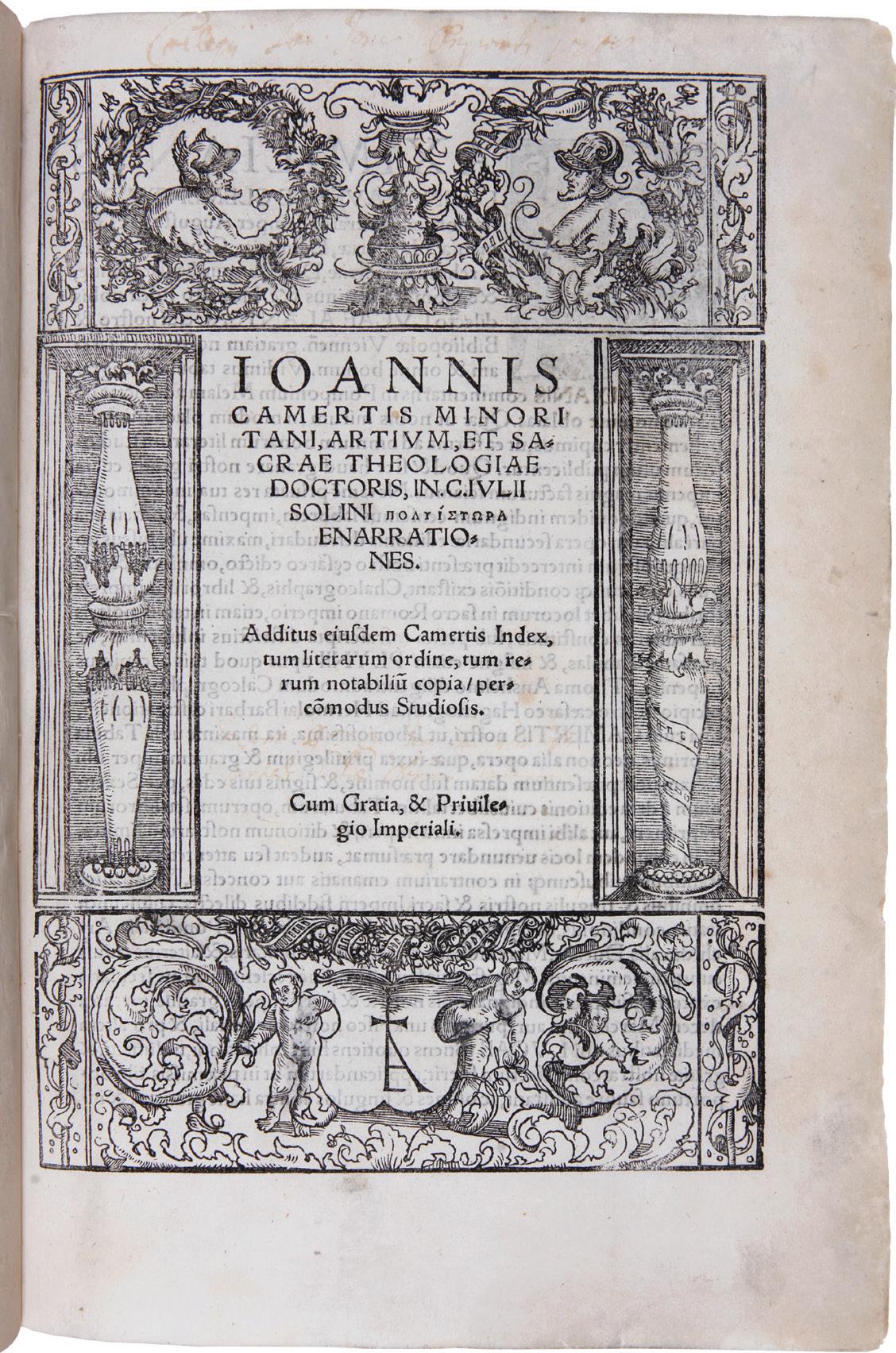
Adams S–1391; Borba II.818; Burden 11; Church 45; European Americana 520/25; Harrisse (BVA) 108; Harrisse, Notes on Columbus, p. 175; Hutch Catalogue 1372; JCB (3) I:77; LeClerc (Supplement) 2686; Rosenbach 20:716; Sabin 86390; Shirley, Mapping of the World 45. See Donald L. McGuirk, The Forgotten “First Map with the Name of america”, The Portolan (2010).
$125,000
THE DISCOVERY OF AMERICA 59
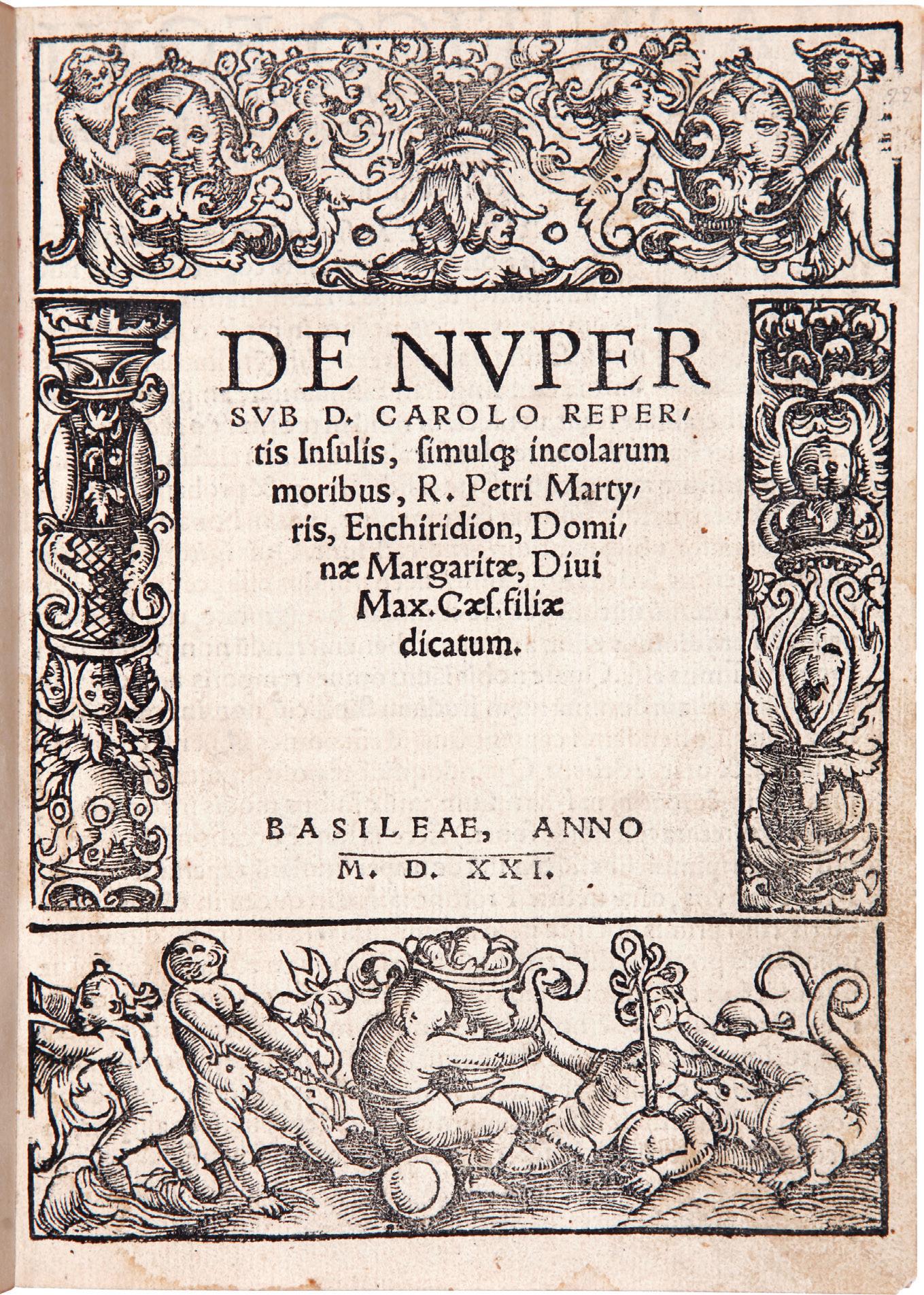
FIRST SUBSTANTIAL ACCOUNT OF THE CONQUEST OF MEXICO
25. CORTÉS, Hernan; and Pietro Martire d’Anghiera [Peter Martyr]. De nuper sub D. Carolo Repertis insulis, simulatque incolarum moribus . . . Enchiridion. Basel: Adam Petri, 1521.
Quarto (182 × 134 mm): A–D4 E6; 43, [1, bl.]pp. Pages 20–21 misnumbered 24–25, as issued. Elaborate woodcut title compartment designed by Hans Franck, two woodcut initials. Nineteenth-century green morocco by Hayday, spine richly gilt with raised bands, boards gilt-ruled, gilt inner dentelles, all edges gilt. Light wear to corners and spine ends. Expertly washed, with some residual light waterstain in gutter, top margin of A1 shaved, affecting topmost part of letters on verso only but not affecting legibility.
Peter Martyr’s De nuper repertis insulis (On the islands recently discovered) is the first substantial printed account of the first three expeditions to Mexico and the
THE PARSONS COLLECTION 60
discovery of the Mayan and Aztec civilizations. Including information from the lost first Cortés letter, it is a key work for the history of the New World from 1516 to 1520, including the conquest of Mexico and a description of Cuba. Indeed, with the loss of the first Cortés’s letter, this is the first authoritative account of that expedition as well as the preliminary explorations by Cordova and Grijalva which preceded it. In the bibliographical sequence of works related to the discovery of Mexico and conquest, Martyr’s De nuper repertis insulis is preceded only by the brief account in German printed in Nuremberg in 1520 and the account of Fr. Juan Diaz printed in Italian and Latin in 1520.
Cortés’s first letter remains unlocated, and is believed by some to have been suppressed by the Council for the Indies. Written in July of 1519, it would be the earliest account of the Spanish conquest of Mexico, including the founding of Vera Cruz; a letter written by the magistrates of that new settlement at the same time confirms what the contents would have been, and therefore the appropriateness of Martyr’s 1521 letter as a substitute. Historian and bibliographer Henry R. Wagner was long convinced that Lopez de Gomara was in possession of the letter, or at least a copy, when writing his seminal Historia, but that account of these events would not appear for another thirty-two years.
Martyr covers events from the discovery of the Yucatan to the Spanish conquest of Tenochtitlan, providing details of the earlier expedition of Grijalva, recounting the first and second embassies to Montezuma, and the founding of Vera Cruz, in addition to descriptions of the landscape, cities, and indigenous cultures, including news of Mayan hieroglyphics. Much attention is paid to Aztec culture, including descriptions of the Aztec calendar, their use of writing and a thorough description of the physical construction of their books. Perhaps moved by news of their artistic and linguistic productions, Martyr also presages Las Casas in his concern for the native people, remarking with sadness on their reduction at the hands of the conquistadors through disease, famine, and mistreatment.
“This is Martyr’s first narrative of the discovery made by Grijalva and the expedition of Cortés to Mexico, added to a fuller account of Cuba than was contained in his three decades already printed. Harrisse called this work an extract from the Fourth Decade, but it is evidently a much more important work, [with] Stevens and other authorities defining it as a substitute for the lost first Cortés letter. This work supplements, rather than overlaps other narratives by the author” (Streeter). Not in Church. A remarkably important piece of Americana, the first authoritative account of Cortés’s expedition to Mexico, recounting to Europe his exploits at the beginning of the Spanish conquest of the New World, as well as details of the Aztec Empire and its people.
Beinecke Lesser Antilles Collection 1; Borba de Moraes, p. 530; European Americana 521/1; Harrisse (BAV) 110; JCB (3) I:79; Medina (BHA) 62; Palau 12594; Sabin 1553; Stevens Nuggets 1802; Streeter Sale 8.
$65,000
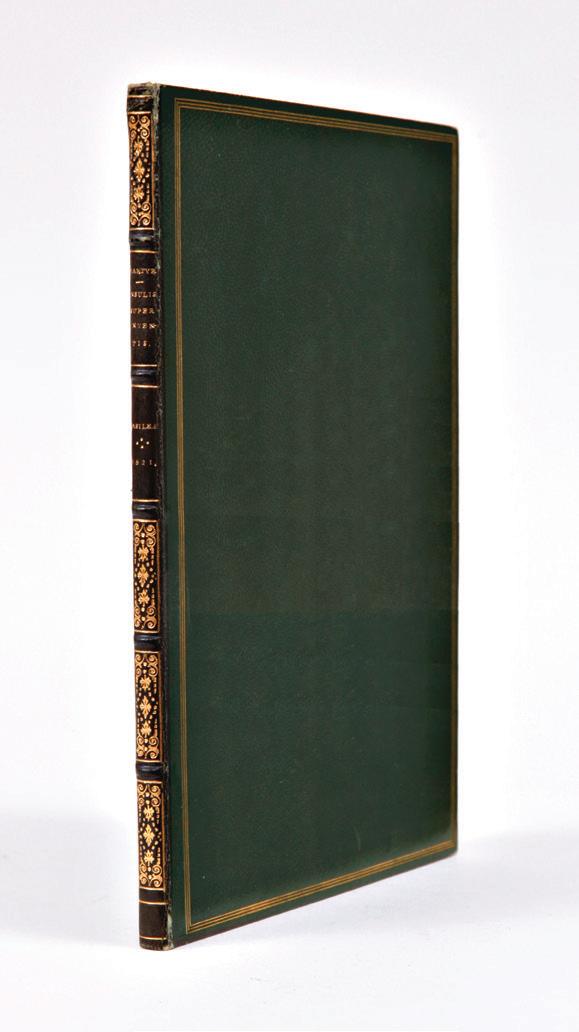
THE DISCOVERY OF AMERICA 61

CORTÉS’S SECOND AND THIRD LETTERS, COMPLETE WITH THE INORDINATELY RARE FIRST PLAN OF AN AMERICAN CITY
26. CORTÉS, Hernan; and Pietro Martire d’Anghiera [Peter Martyr]. Praeclara Ferdina[n]di. Cortesii de Nova maris Oceani Hyspania Narratio Sacratissimo ac Inuictissima Carolo Romanoru[m] Imperatori semper Augusto, Hyspaniaru[m] &c Regi Anno Dominii M.D.XX; [bound with:] Tertia Ferdina[n]di Cortesii Sac. Caesar. et Cath. Maiesta . . . ; [and] De rebus, et insulis noviter repertis a Sereniss. Nuremberg: F. Peypus, 1524.
Three works bound in one. Folio (302 × 195 mm): a 4 A–G 6 H 8 aa 4 2aa 6 bb 6 A–B 6 Cc–Gg 6 Hh10; [4] XLIX [1]; [4] XII; LI [1] leaves. Total of 122 leaves plus folding map. Martyr De Rebus bound in after title page and preliminaries of third letter. Title of second letter within historiated woodcut border, imperial Hapsburg coat of arms on verso of title, woodcut portrait of Pope Clement VII on the verso of the fourth preliminary leaf (not found with all copies), title page of third letter with woodcut border and portrait of Charles V, woodcut initials throughout all three works. Red crushed morocco by Lortic, covers ruled in gilt, spine elaborately gilt with raised bands, gilt inner dentelles, all edges gilt. Pages washed, terminal blank of first part supplied, very light scattered foxing.
The first Latin edition of Cortés’s second and third letters, complete with the exceedingly rare map, which constitutes the first plan of an American city and a landmark mapping of the Gulf of Mexico. The text is the first major announcement of the discovery of major civilizations in the New World, and as such is a
THE PARSONS COLLECTION 62

work of surpassing importance. This volume has been expanded into an extensive contemporary account of the Spanish conquest of New Spain by the addition of Peter Martyr’s De Rebus, et Insulis Noviter Repertis a Sireniss, often considered a stand-in for the lost first letter of Cortés, and the highly scarce first Latin edition of Cortés’s third letter.
Cortés’s second letter, dated October 30, 1520, provides a vivid account of the people he encountered en route to Tenochtitlan, painting a picture of an impressive empire centered around a great city. He relates his conflict with rival Velazquez and gives a wonderful description of the buildings, institutions, and court at Tenochtitlan. It is here that Cortés provides a definitive name for the country, calling it “New Spain of the Ocean Sea.” This letter is also important for making reference to Cortés’s lost first letter, supposedly composed at Vera Cruz on July 10, 1520. Whether that letter was actually lost or suppressed by the Council of the Indies is unknown, but there is little doubt it once existed.
The map of Tenochtitlan and the Gulf of Mexico which accompanies the letter is of supreme importance and nearly always lacking. Besides being the first plan of an American city, it is the first map to name Florida and the first map to depict any portion of the Mississippi, here named Rio del Spiritisancto. “The map has two parts, the larger is a plan of the Aztec capital portraying it before its destruction by Cortés, with all the buildings, canals and causeways. The second part is the first accurate delineation of the Gulf of Mexico and the first to use the
THE DISCOVERY OF AMERICA 63
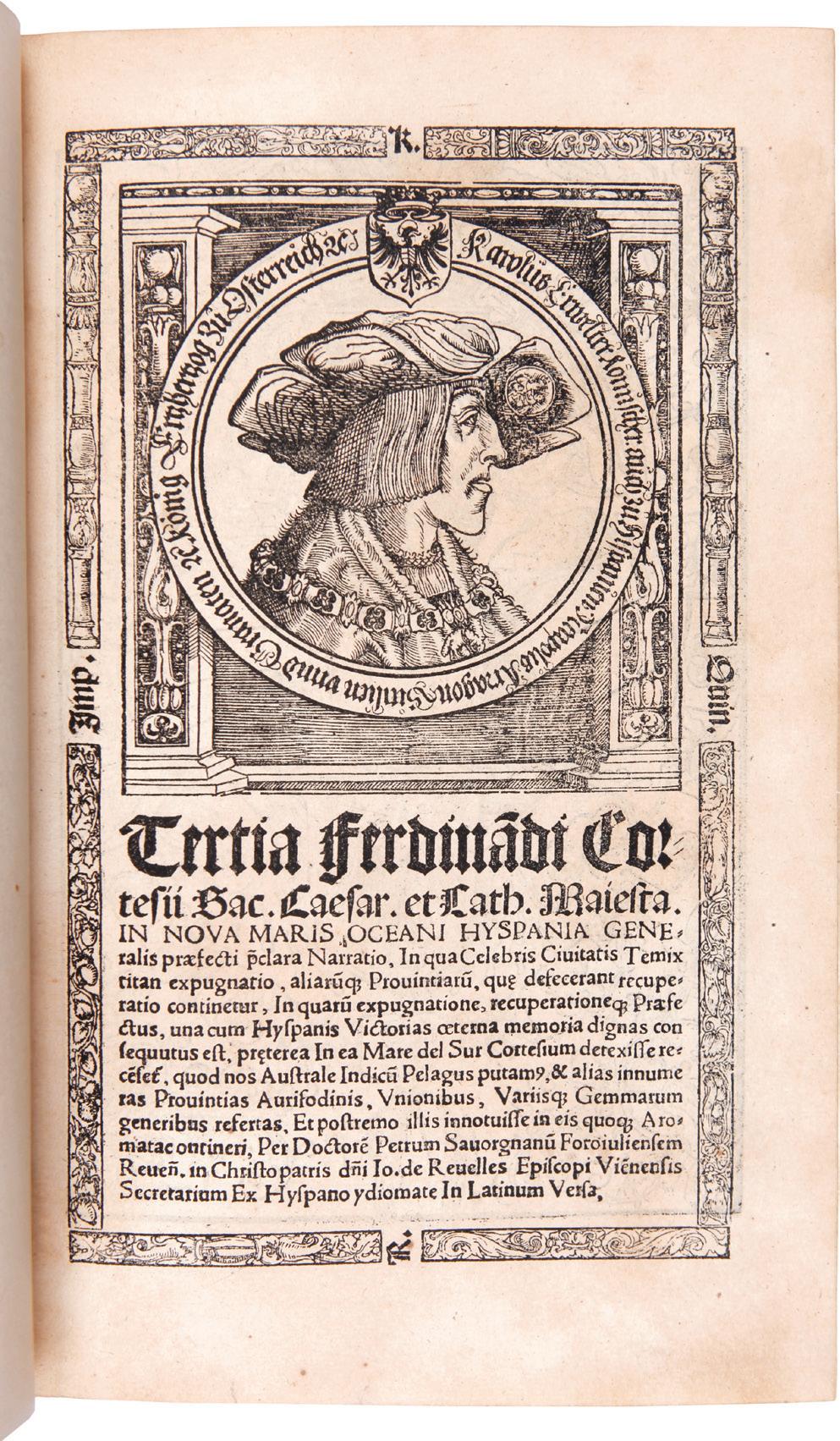
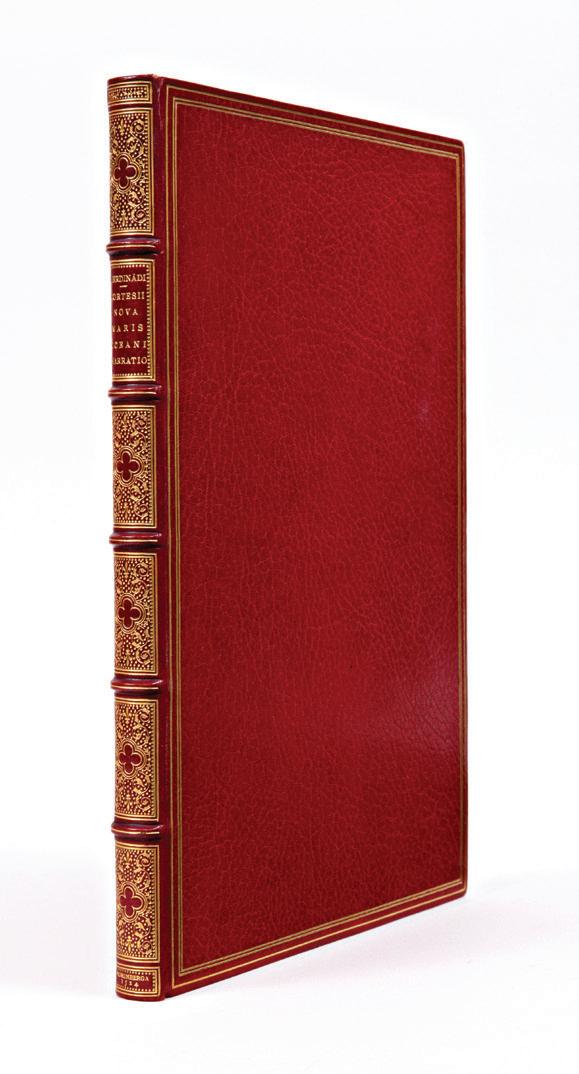
name ‘Florida’. In his letter, Cortés claims that the delineation of the Mexican coast came from Montezuma himself” (Burden).
As usual, the second letter is here bound with Peter Martyr’s De Rebus, et Insulis Noviter Repertis, which provides an account of the recently discovered islands of the West Indies and their inhabitants. This volume is further enhanced by the addition of the first Latin edition of Cortés’s third letter, also published by Peypus the same year as the second. The third letter recounts in vivid detail the events after the “Noche de Tristas” on June 30, 1520, during which the Spanish and their Mexican Indian allies were initially driven from Tenochtitlan after the death of Montezuma. The climax of the letter is Cortés’s harrowing description of the capture and destruction of Tlatelolco and Tenochtitlan, and the surrender of Cuauhtémoc, marking the end of the Aztec Empire and the beginning of firm Spanish control in Mexico and Central America, what Cortés had coined “New Spain.”
Cortés wrote this letter at Coyoacán and dated it May 15, 1522. It reached Europe by November 1522, though news of his victory had arrived in March, before he had even penned his account. By then, Emperor Charles V, whose woodcut portrait and arms appear on the title page, had decided to name Cortés Commander-in-Chief, Governor, and Captain-General of New Spain, and these ranks accompany Cortés’s name in the title. The translation of these letters into Latin from the now unobtainable first Spanish edition of 1523 was accomplished by Pietro Savorgnano, secretary to the Bishop of Vienna. Although the Latin editions were issued simultaneously by the same printer, and are often found bound together, they are separate works, and the third letter is generally more scarce.
We are aware of only three other examples of the second letter complete with the map to appear on the market in the last half century. The rarity of examples with the map is confirmed by its absence in the famed H. P. Kraus catalogue Americana Vetustissima, and there is no mention of the map by Harrisse in Bibliotheca Americana Vetustissima. The John Carter Brown Library holds three copies of this edition, only one of which contains the map (acquired by Brown prior to the Library’s founding nearly two centuries ago).
One of the most important early descriptions of Mexico and the first encounter of the West with the Aztec civilization. A work of bedrock importance to the New World, complete with the rare and highly-important map of Mexico City.
Burden 5; Church 53–4; European Americana 524/5, 524/8; Harrisse (BVA) 125–6; JCB (3) I:90–91; Medina (BHA) 70–71; Palau 63190–91; Sabin 16947–8; Sanz 933–934; Streeter Sale 190; Streeter, Americana-Beginnings 7.
$650,000
THE PARSONS COLLECTION 64

THE FIRST PUBLISHED AUTHENTIC ACCOUNT OF MAGELLAN’S EXPEDITION
27. MAXIMILIANUS TRANSYLVANUS. Epistola, de admirabili & novissima Hispanoru[m] in Orientem navigatione qua uariae, & nulli prius accessae Regiones inue[n]tae sunt, cum ipsis etia[m] Moluccis insulis beatissimis, optimo Aromatu[m] genere resertis. Rome: in aedibus F. Miniti Calvi, February 1524.
Quarto (265 × 144 mm): A–C 4 D 6; [18] leaves. Title within elaborate woodcut compartment. Modern full dark blue morocco, ruled in gilt, spine lettered in gilt. Minor staining on A3r, faint tideline in lower margin of signature C, otherwise clean. Very good.
The foundational work on the exploration of the Pacific: the first published authentic account of Magellan’s expedition, and the first voyage to cross the Pacific. It is through this account of Maximilianus that Europe was informed of the first circumnavigation of the globe, one of the greatest events in the exploration of the world by European adventurers. The modern map of the world is witness to this epoch-making event, the name “Pacific” having been bestowed on the great ocean by Magellan himself, while his point of entry is still commemorated by the straits which bear his name. “No other single voyage has ever added so much to the dimension of the world” (Spate).
THE DISCOVERY OF AMERICA 65
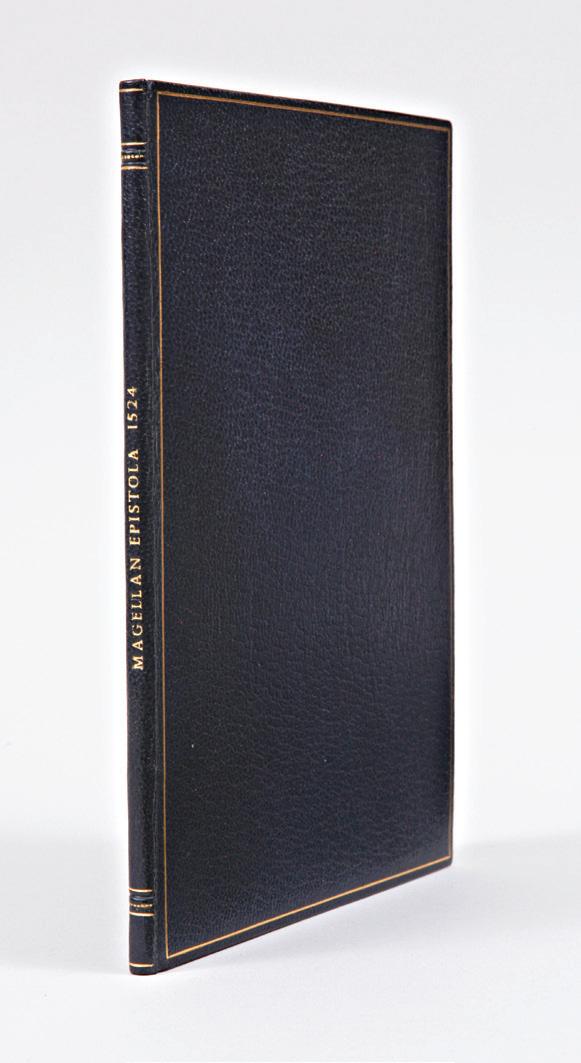

This is the fourth edition, following Cologne, Paris, and Rome editions of 1523. Maximilianus Transylvanus, a pupil of Peter Martyr, interviewed the surviving members of the expedition when they presented themselves to the Spanish court bishop of Salzburg, Matthaeus Lang. The archbishop had the text printed in either Cologne or Rome (the priority of the editions is uncertain) in 1523, and a Paris
ruary 1524, within eighteen months of the expedition’s return. All these editions are identical in text, and all are rare.
The expedition under Magellan set out from San Lucar on August 10, 1519, in five vessels manned by 265 men, with the intention of sailing westward to the Moluccas. After a suppressed mutiny and a hard winter in Patagonia, on October 18, 1520, the ships passed through the straits now named in Magellan’s honor and sailed westward to the Philippines. There Magellan was killed in a skirmish with natives, and further adventures in the East Indies depleted the venture through disease and desertion. Only one ship with eighteen men, under Juan Sebastián Elcano, landed at Seville on September 6, 1522. Shortly thereafter all of the crew who could travel went to Valladolid to report to Charles V, including the other chronicler of the voyage, Antonio Pigafetta. Pigafetta’s account did not appear until 1525, in Paris, and was not wholly published until the late eighteenth century. “There was none of the prophetic mysticism of Columbus in the makeup of the great Portuguese. Magellan was distinctly a man of action, instant, resolute, enduring . . . The first navigation of the Straits of Magellan was a far more difficult problem of seamanship than crossing the Atlantic . . . Columbus’s voyage was over in thirty-five days; but Magellan’s had been gone a year and weathered a subarctic winter before the real task began—the voyage over a trackless waste of waters exactly three times as long as the first crossing of the Atlantic . . . Magellan is to be ranked as the first navigator of ancient or modern times, and his voyage the greatest single human achievement on the sea” (Bourne).
Borba de Moraes, p. 547; Church 56; European Americana 524/13; Harrisse (BAV) 124; LeClerc 956; Medina (BHA) 69; Medina (Filipinas) 3; Sabin 47040. Bourne, Spain in America, chapter 9. O.H.K. Spate, The Pacific since Magellan, I, The Spanish Lake (Canberra, 1979), p. 57.
$95,000
THE PARSONS COLLECTION 66

AN EARLY ACCOUNT OF COLUMBUS’S AND VESPUCCI’S EXPLORATIONS
28. GLAREANUS, Henricus. De geographia liber unus. Basel: [J. Faber], 1527.
Small quarto (188 × 140 mm): A–I4; 35 (of 36) leaves, lacking terminal blank I4. Woodcut title, border and numerous in-text woodcuts. Modern olive calf, gilt-ruled, spine gilt with raised bands, marbled endpapers. Expert repairs to the blank lower corner of leaf G3 to end.
A noteworthy early geographical work, including early reports of the discoveries of Columbus and Vespucci appearing on the recto of the final leaf. The text on the Americas (as translated in Harrisse) begins: “Farther towards the west, lies a country called America, the length of which is about eighty degrees. There are two islands, Spagnolla and Isabella. Those countries have been visited along the coasts by the Spaniards, Colombo of Genoa and Amerigo Vesputio being the leaders of the navigation.”
There are also instructions for making paper globes, with a woodcut of the twelve gores, as well as a full-page earth-centered diagram of the universe and astronomical and navigational illustrations. Henry Loritz of Glaris (1488–1563), a friend of Erasmus, held the chair in mathematics at the University of Basel as a young man and wrote two works on scientific subjects (including the present title).
European Americana 527/7; Harrisse (BAV) 142; JCB (3) I:98; Sabin 27536.
$6,000

THE DISCOVERY OF AMERICA 67

FIRST COMPLETE EDITION OF THE EIGHT DECADES
29. ANGHIERA, Pietro Martire d’ [Peter Martyr]. De Orbe Novo Petri Martyris ab Angleria Mediolanen sis Protonotaij C[a]esaris senatoris decades. Compluti [Alcalá de Henares]: apud Michaele de Eguia, 1530.
Small folio (290 × 205 mm): A–P8; [2], iii–cxvii, [3] leaves. Title within elaborate woodcut border, woodcut initials. Nineteenth-century Spanish paneled calf, spine gilt with raised bands, marbled endpapers. Minor wear at extremities. Title page tanned, scattered marginal waterstaining, several leaves more so. Generally a broad-margined fresh copy. Provenance: Marqués de Pidal (bookplate).
Very rare first edition of all eight of Peter Martyr’s Decades, the indispensable source for the discovery period by the first historian of the New World. “This is the first complete edition of the Eight Decades and ranks next in interest, value, and rarity to the edition of 1511. According to Harrisse this edition is in some respects more correct than Hakluyt’s edition (Paris, 1587), which is usually considered the best” (Church).
An intimate of Columbus and contemporary of Vasco da Gama, Cortes, Magellan, Cabot, and Vespucci, Martyr had access to numerous firsthand voyage accounts and became the foremost chronicler of the discovery of the New World. “Peter Martyr was perhaps the first man in Spain to realize the importance of the discovery made
THE PARSONS COLLECTION 68
by Columbus. Where others beheld but a novel and exciting incident in the history of navigation, he, with all but prophetic forecast, divined an event of unique and far-reaching importance. He promptly assumed the functions of historian of the new epoch whose dawn he presaged, and in the month of October, 1494, he began the series of letters to be known as the Ocean Decades, continuing his labors, with interruptions, until 1526, the year of his death. The value of his manuscripts obtained immediate recognition; they were the only source of authentic information concerning the New World, accessible to men of letters and politicians outside Spain. His material was new and original; every arriving caravel brought him fresh news; ship-captains, cosmographers, conquerors of fabulous realms in the mysterious west, all reported to him; even the common sailors and camp-followers poured their tales into his discriminating ears. Las Casas averred that Peter Martyr was more worthy of credence than any other Latin writer . . . It is their substance, not their form, that gives Martyr’s writings their value, though his facile style is not devoid of elegance, if measured by other than severely classical standards. Not as a man of letters, but as an historian does he enjoy the perennial honor to which in life he aspired. Observation is the foundation of history, and Martyr was preeminently a keen and discriminating observer, a diligent and conscientious chronicler of the events he observed, hence are the laurels of the historian equitably his” (MacNutt, Introduction to De Orbe Novo: The Eight Decades of Peter Martyr D’Anghera [1912]).
Martyr’s Decades are of primary importance to the early history of America. Each Decade, each comprising ten letters, detail various discoveries and events in the New World. The first three Decades contain the earliest accounts of Columbus’s voyages, as well as the first printed reference to the Cabot exploration and to the discovery of the Pacific Ocean by Balboa. The fourth through the eighth Decades carry the history of the New World through the conquest of Mexico, with the fourth relating primarily to Cortés and the Hernandez de Cordova expedition. The fifth Decade contains one of the earliest accounts of Magellan’s circumnavigation, the only previous references in print being Pigafetta’s of 1525 and Maximilianus’s 15-page epistle of 1523. The sixth and shortest Decade is devoted to the doings of Gil Gonzalez de Avila and Licenciado Espinosa. The seventh Decade describes the expedition of Lucas Vasquez, details the capitulation of Vasquez de Ayllon, the terrible massacre of the Dominicans at Chiribiri, and relates the troubles of Francisco de Garay in the Panuco region and the expedition of Cristobal de Olid to Honduras. The eighth and final Decade, finished early in 1526, contains another account of Garay’s expedition to the Panuco region, although much fuller than the previous, plus more concerning the suspicion that Cortés had meditated rebellion.
This example from the library of the family of the Marqués de Pidal, likely that of the first Marqués, Pedro José Pidal (1799–1865), noted Spanish politician and writer and the Director of the Real Academia de la Historia, or perhaps from his son, Alejandro Pidal y Mon (1846–1913). Only the Botfield–McKinney copy has appeared at auction in the last quarter century.
Adams M–752; Borba II, p. 530; Church 62; European Americana 530/1; JCB (3) I:101; Harrisse (BAV) 154; Medina (BHA) 85; Palau 12592; Sabin 1551.

THE DISCOVERY OF AMERICA 69
SOLD
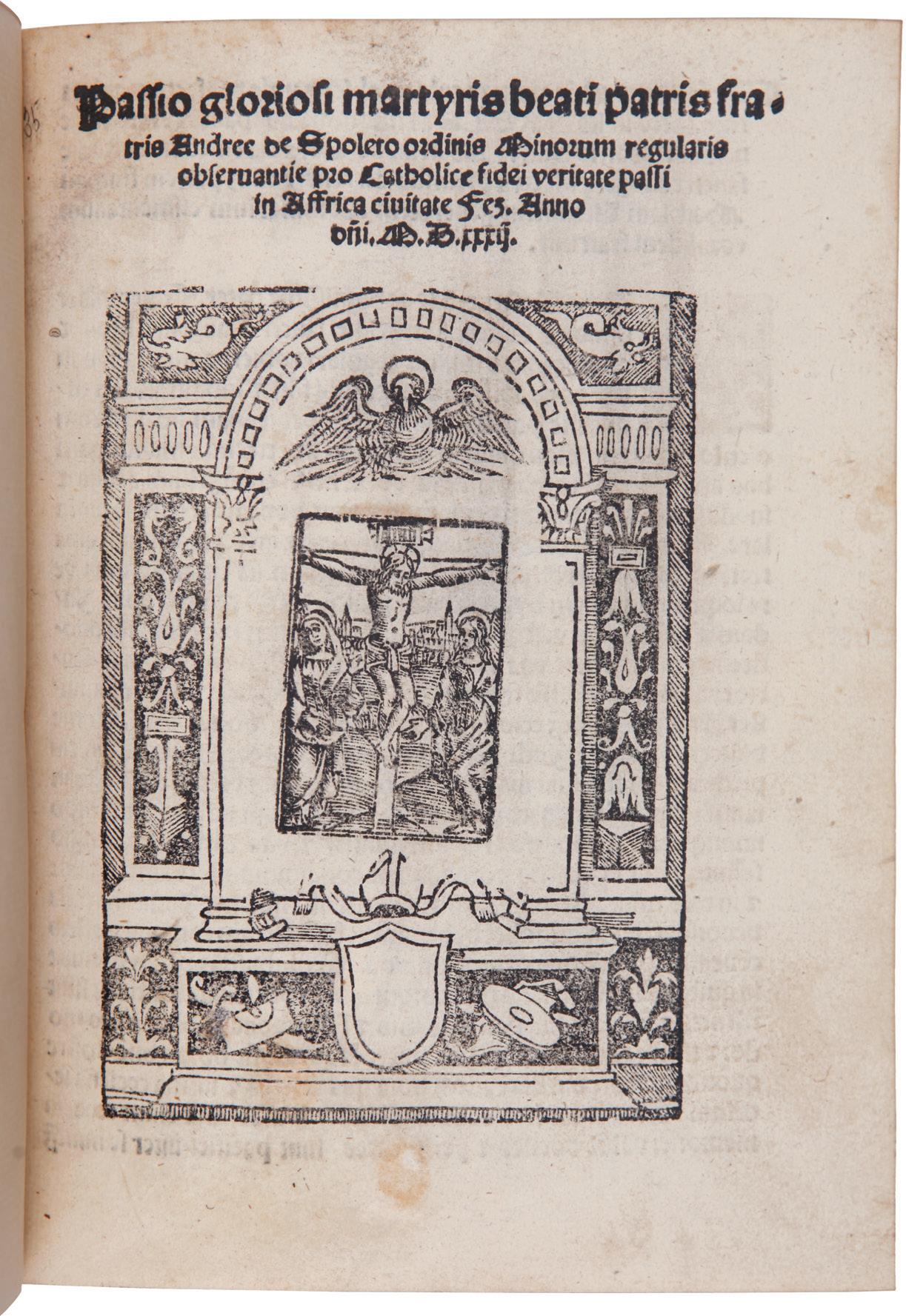
AMONG THE EARLIEST MISSIONARY LETTERS FROM MEXICO CITY AND YUCATAN
30. ZUMÁRRAGA, Juan de; Martin de Valencia; and Antonio de Olave. Passio gloriosi martyris beati patris fratris Andree de Spoleto ordinis Minorum regularis observantie pro Catholice fidei veritate passi in Affrica civitate Fez. Bologna: per Iustinianu[m] Ruberien[sem], 3 June 1532.
Quarto (200 × 145 mm): A4; [4] leaves. Full-page woodcut illustration on of the crucifixion on title, set within an architectural woodcut border with dolphins, a dove representing the Holy Spirit, and a bishop’s mitre. A second, smaller woodcut of the Virgin and Child appears on A2v with early manuscript annotation “Ritratto della Madona [sic] de Loreto” beneath. Late nineteenth- or early twentieth-century tan morocco by Leighton, ruled in blind, spine lettered in gilt. Very minor toning and spotting.
Containing two very early missionary letters from Mexico City and Yucatan, this edition is recorded by European Americana but not found in most bibliographies. This is the presumed second edition, published in Bologna the same year as the first in Toulouse.
THE PARSONS COLLECTION 70
The first letter, by Martín de Valencia and dated June 12, 1531, reports on the activities of the Franciscan mission at Tlalmanalco, near Tenochtitlan (Mexico City), with emphasis on the conversion of the Aztecs and the education of the Aztec youth. Addressed to Franciscan Father General Mathias Weynssen, Martín reports that the Franciscans have baptized over a million natives and that all of his companions (but not he himself) have learned their languages. The Franciscans have established twenty convents thanks to the native people of Mexico, who assist in their construction, and he praises the Aztec students.
The second letter, written by Juan de Zumárraga, the first Bishop of New Spain, includes an account of the destruction of Aztec temples and an end to human sacrifice in Tenochtitlan. Zumárraga opens his letter with the announcement that he and his fellow Franciscans have baptized 250,000 natives, destroyed more than fifty temples of their gods, broken and burned more than 20,000 figures of demons and have ended human sacrifices. Like Valencia, Zumárraga praises the progress of the Aztec youth in their education and their adherence to Christian teaching, particularly in reading, writing, and singing, and noting their special devotion to the Virgin Mary. He describes the Franciscan compounds at length, notes that he has been performing marriages, and informs his superiors that of the many missionaries who speak Nahuatl, there is one man, Petrus de Gante, who is particularly skilled. This is the famous Peter of Ghent (Peeter van der Moere, ca. 1486–1572), former confessor to the emperor Charles V, who founded the first schools in New Spain, first at Texcoco, and then at Tenochtitlan. The letter concludes with a report that the Empress has sent six women from Spain to educate Aztec girls and women.
The work concludes with a third letter, unrelated to the New World, being Antonio de Olave’s account of the martyrdom of Andrea of Spoleto (b. ca. 1482), beaten to death in Fez, Morocco on 9 January 1532 after emerging unscathed from being burnt alive for attempting to convert Muslims and cursing the Prophet Muhammad.
The present work is one of two editions in Latin of this title published in 1532, the other printed at Toulouse. Since the letters by Zumárraga and Antonio de Olave were directed to the general chapter of the Franciscans, which convened at Toulouse in 1532, the Toulouse imprint may be presumed to be the first edition, though does not contain the woodcut of the Virgin Mary with child. After the present June 1532 separate printing, the letters were subsequently printed within the 1532 edition of De insulis nuper inventis (see Harrisse BAV 168). European Americana also notes a French translation of the Latin printed at Toulouse the same year.
All editions are rare, though European Americana and OCLC locate only a single holding of this Bologna edition at the John Carter Brown Library.
European Americana 532/4. For the Toulouse edition, see Harrisse (BAV) Additions 97; Medina (BHA) 87; Palau 200055; Sabin 44931; Streit II, 279 & XV, 299.

THE DISCOVERY OF AMERICA 71
SOLD

A RARE TARGET OF THE SPANISH INQUISITION, WITH EARLY REFERENCES TO THE NEW WORLD
31. MARINEO SÍCULO, Lucio. Opus de rebus Hispaniae memorabilibus modo castigatum atq[ue] Caesareae maiestatis iussu in lucem aeditum. Alcalá de Henares: Miguel de Eguía, 1533.
Folio (285 × 210 mm): π8 A–Q8; [8], 128 leaves. Woodcut architectural title page incorporating arms of Charles V, elaborate woodcut initials, typographical ornaments, occasional minor marginalia. Contemporary vellum over new boards, spine lettered in contemporary manuscript, later endpapers. Vellum a little soiled with some natural creasing, a little loss of leather at corners and on spine, ties not preserved. Margins of title page and final leaf repaired (not affecting woodcut or text), circular stain on leaf F3, occasional spot of faint foxing, contents carefully washed. A very good copy.
Rare second Latin edition of Marineo’s history of Spain and Portugal. The text, originally published in 1530, includes an early reference to Columbus’s voyage. The book is a remarkable witness to the Spanish censorship activity, with an inscription by the inquisitor Gregorio Vieto dated 1707 on the second leaf and a portion of cancelled text.
Palau records that in 1533 Emperor Charles V ordered the suppression of the biographies of illustrious men appearing on leaves 128 to 175 of the first edition
THE PARSONS COLLECTION 72
(these included the Roman emperors born in Spain and some famous women). The existing copies were expurgated and reissued with new preliminary leaves and a new final leaf, dated 1533. No copies of the 1530 edition are recorded at auction, and only two copies of it are known in libraries worldwide. This second edition is also rare in commerce, with only two copies traced in auction records in the past 70 years.
This copy was examined by the inquisition in the early eighteenth century, evidenced by a few passages which have been deleted in ink on the verso of leaf CVIII and recto of leaf CIX. A similarly censored copy is held in the library of the University of North Carolina (Folio DP64 M33 1533). The passages contain a discussion on the conversos, Jewish Spaniards who converted to Catholicism but later turned to observe Jewish rites in secrecy.
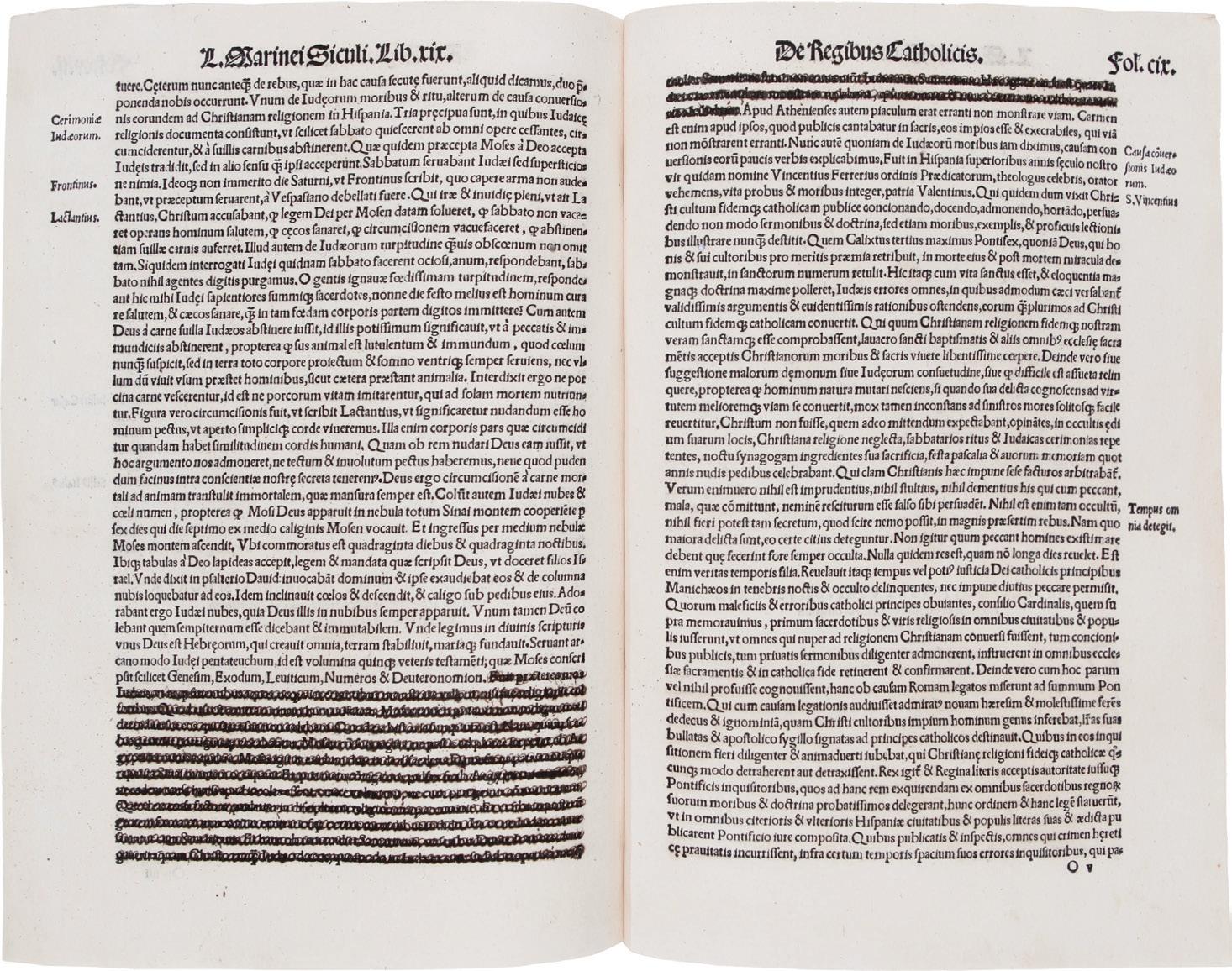
The work incorporates material from Marineo’s earlier work of Spanish history, De Hispaniae laudibus (ca. 1497), extended to cover the reign of the Catholic monarchs Fernand II of Aragon and Isabella I of Castile. It opens with two long prologues dedicated to the current emperor Charles V and his wife Isabella of Portugal, followed by twenty-two chapters containing a detailed description of the Iberian peninsula, its climate and period, a genealogy of the Aragonese kings, and the lives of the Catholic monarchs.
The section on the acquisition of the Canary Islands and of “the other islands of our hemisphere” on verso of leaf CVI mentions the discovery of the New World by Columbus, misattributed to a “Petrus Colonus.” Marineo notes that Columbus travelled with “thirty five ships, which are called caravels, and a larger number of men”, and that a coin of the Emperor Augustus had been found in a gold mine in the Indies.
A contemporary reader has contributed marginal annotations in a charming italic hand. The early owner has underlined passages in the text and added more information in the margins, drawing from several related historical sources, including the works of Pontanus and Lorenzo Valla.
European Americana 533/20; Harrisse (BAV) Additions 101; Martín Abad, 229B; Medina (BHA) 90; Palau 152134; Salva 3023.

THE DISCOVERY OF AMERICA 73
SOLD

ANNOTATED COPY OF APIANUS’S
COSMOGRAPHY,
WITH MENTION OF BOTH VESPUCCI AND COLUMBUS
32. APIANUS, Petrus; and Gemma Frisius. Cosmographicus liber . . . restitutus per Gemmam Phrysium. Antwerp: Johann Grapheus, 1533.
Quarto (204 × 155 mm): A–P 4 Q 6; [2] III–LXVI leaves. With 5 volvelles (9v; 10v; 12v, including lead weight; 32r; 53r), two-part woodcut diagram pasted on leaf 55r, and numerous woodcuts in text. Annotated by an anonymous, though exceptionally learned sixteenth-century humanist, most likely Northern European. Contemporary vellum, lightly soiled, edges of covers sometime repaired in a couple of places, contemporary manuscript lettering and decoration on spine, endpapers renewed. Faint damp stain to margins of a few leaves, occasional spot of foxing or small mark, otherwise generally clean.
A well-annotated copy of one of the most important geographical and astronomical texts of the Renaissance, here in the augmented edition of the Flemish mathematician Gemma Frisius: one of the most significant and influential of sixteenth-century instrument books for navigators and travelers.
THE PARSONS COLLECTION 74
Rather unusually, this copy is annotated by an exceedingly educated but unidentified humanist. The handwriting suggests a German or other Northern European scholar, mostly likely dating to the second half of the sixteenth century. General cosmographies, like contemporary travel accounts, did not often receive extensive humanist annotation, and the present copy is all the more intriguing for a detailed comment the writer makes in the section relating to America and its discovery by Vespucci (fol. XXXIVr): “Ex navigationibus duces Americus Vesputius et Columbus genuensis. Sunt qui putant tempore Caesaris Augusti eam terram fuisse notam atque Maronem lib. 6 [6.795–797] aeneid. de ea haec protulisse: iacet extra sidera tellus, Extra anni solisque vias, ubi coelifer Atlas Axem humero torquet stellis ardentib. aptum.” (“From the voyages of the captains Americo Vespucci and Columbus the Genoese. There are those who think that that land was known at the time of Caesar Augustus and that Virgil, in Aeneid 6, referred to it in these words: [He shall extend his propagated sway] Beyond the solar year, without the starry way Where Atlas turns the rolling heav’ns around, And his broad shoulders with their lights are crown’d.”)
This note is doubly interesting: in the first instance, it corrects the printed text by adding the name of Columbus as one of America’s discoverers rather than Vespucci alone. Still more interesting is the extended, learned comment that the existence of America was known to Augustan Rome: the evidence cited for this contention are two lines from the Aeneid.
The annotations were examined by the late Prof. Owen Gingerich of Harvard University, who offered the following additional comments: “Several parts of the book are heavily annotated, all in the same hand but in at least three different inks, suggesting that the annotations were made over some period of time. In the opening pages the annotations comprise what are called index notes, that is, they place key words from the text into the margin for easy look-up. But beginning on f. 6v they contain additional information from an attentive reader, such as the cross-reference to Aristotle’s De coelo. Later there are repeated references to Pliny.” Other annotations refer to Tacitus, Strabo, Ptolemy, and Aristotle.
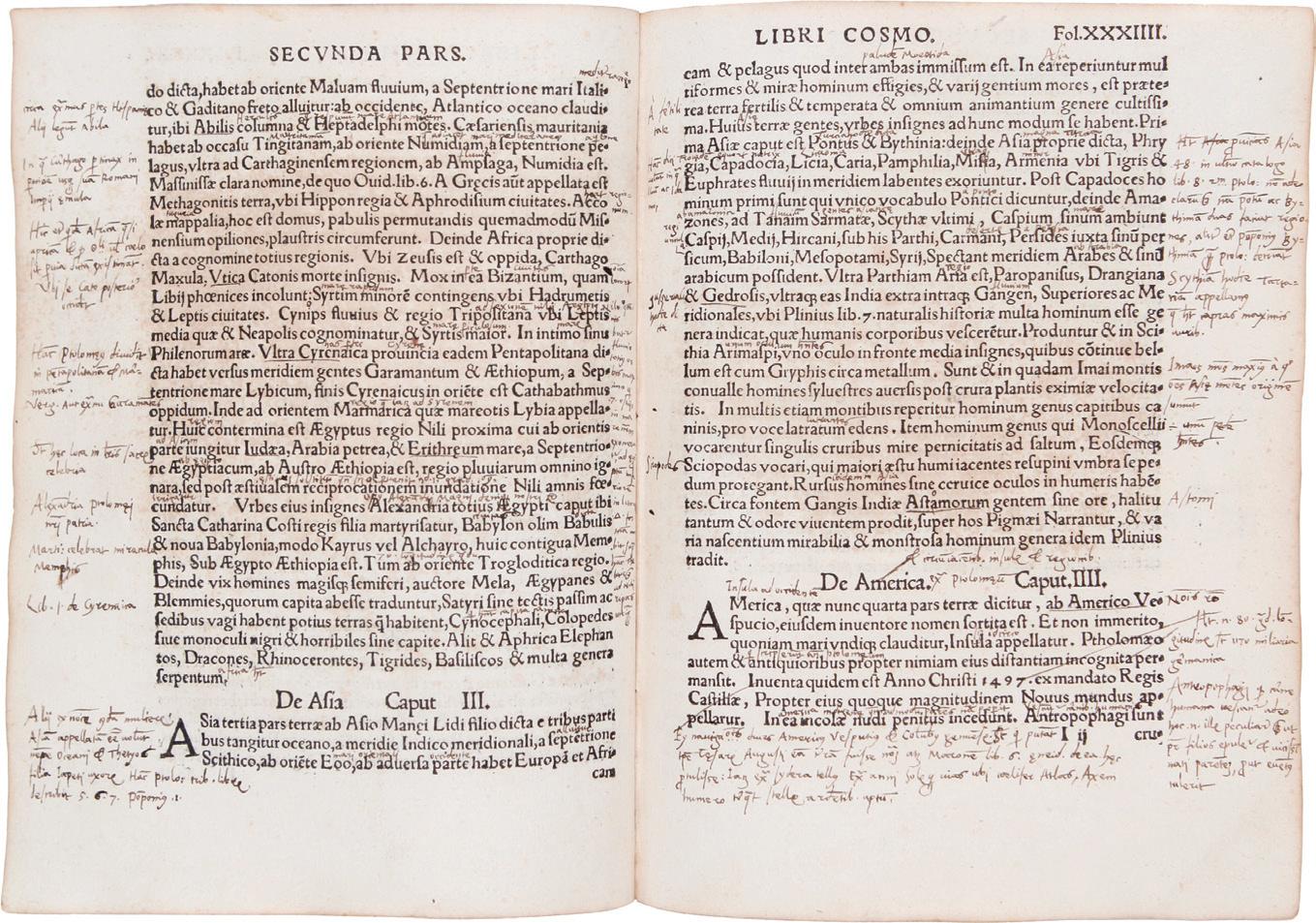
THE DISCOVERY OF AMERICA 75
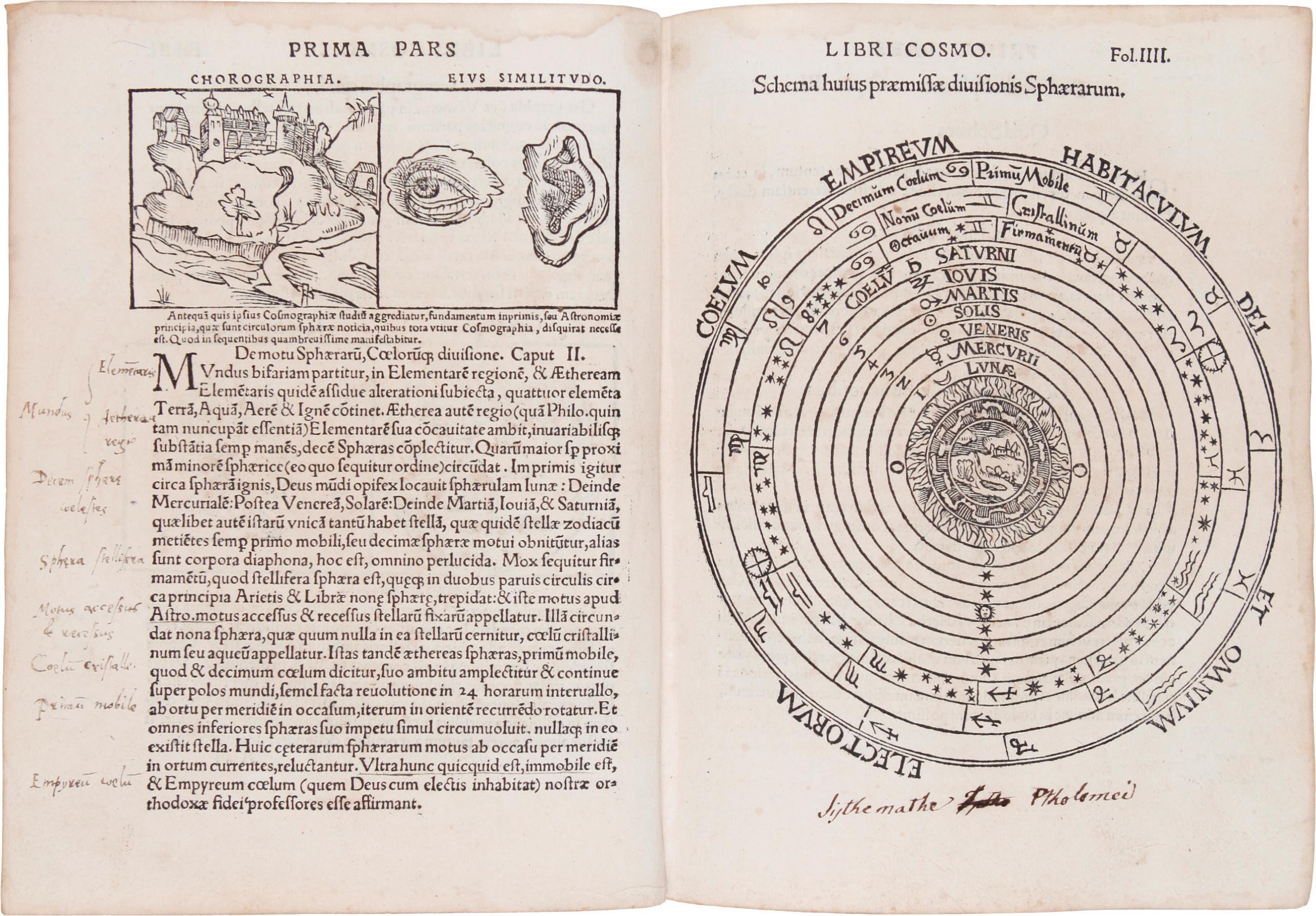
THE PARSONS COLLECTION 76

THE DISCOVERY OF AMERICA 77


Regarding the volvelles, the verso of leaf X contains two additional volvelles of an astrolabe, taken from an edition of Kobel’s Astrolabii declaratio, first printed in 1535. Otherwise, the integral volvelles include a particularly fine example of a portable sundial with moving parts, noteworthy in that one of the two small weights remains. Alongside the lunar instrument with moving parts, the annotations convey further details of the motion of the moon.
Borba de Moraes I:41–42; European Americana 533/5; Harrisse (BAV) 179; JCB (3) I:106; Ortroy 27; Sabin 1742 (variant issue); Warner, The Sky Explored, p. 8 (includes two maps from this work: ‘Ursa Minor and Plaustrum’ & ‘Ursa Minor and Ursa Major’).
THE PARSONS COLLECTION 78
SOLD
A PIONEERING COLLECTION OF VOYAGES: THE HUTH COPY
33. HUTTICH, Johann. Die new Welt, der landschaften und Insulen. Strassburg: Georgen Ulricher von Andla, 1534.
Folio (295 × 205 mm): * 6 a–z 6 A–T 6; [6], 252 leaves. Final leaf misnumbered 242. Nineteenth-century calf by Bedford, gilt-ruled, spine elaborately gilt with raised bands, gilt inner dentelles, all edges gilt. Slight wear at joints and spine extremities. Gilt morocco bookplate on front pastedown. Small wormhole to lower margin throughout, filled on title page and first few leaves. A near-fine copy. Provenance: Henry Huth (morocco gilt booklabel on the front pastedown).
The first German-language translation of this early and large collection of important voyages, many of which relate to America. Especially interesting among these are the first three voyages of Columbus, the voyages of Pinzon, and of Vespucci. It also includes a full translation of Peter Martyr’s Decades, and Martyr’s De Legatione Babylonica. There are also accounts of the voyages and travels of Marco Polo, Cabral, Cada Mosto, and others.
Translated from the Latin and expanded by Michael Herr from the 1532 Basel printing called Novus Orbis, this edition is often attributed to Simon Grynaeus, who wrote the preface to the 1532 edition of Huttich. The preface to this 1534 edition, however, is by Michael Herr. Sabin writes that this 1534 edition “is less well known and much rarer than the original. The version is somewhat broad, and is distinguished by a certain originality in expression. Although it has no map, it has, on the other hand, the merit of being augmented in the text. It contains a full translation of Peter Martyr’s Decades, folios 174–229, and also his three books De Legatione Babylonica, folios 235–248, both wanting in all the different Latin editions. Besides, it contains all the pieces of the first Latin edition of 1532, except Munster’s Introductio in tabulam geograph, to which the map belongs, and would, therefore, have been superfluous in this edition.”
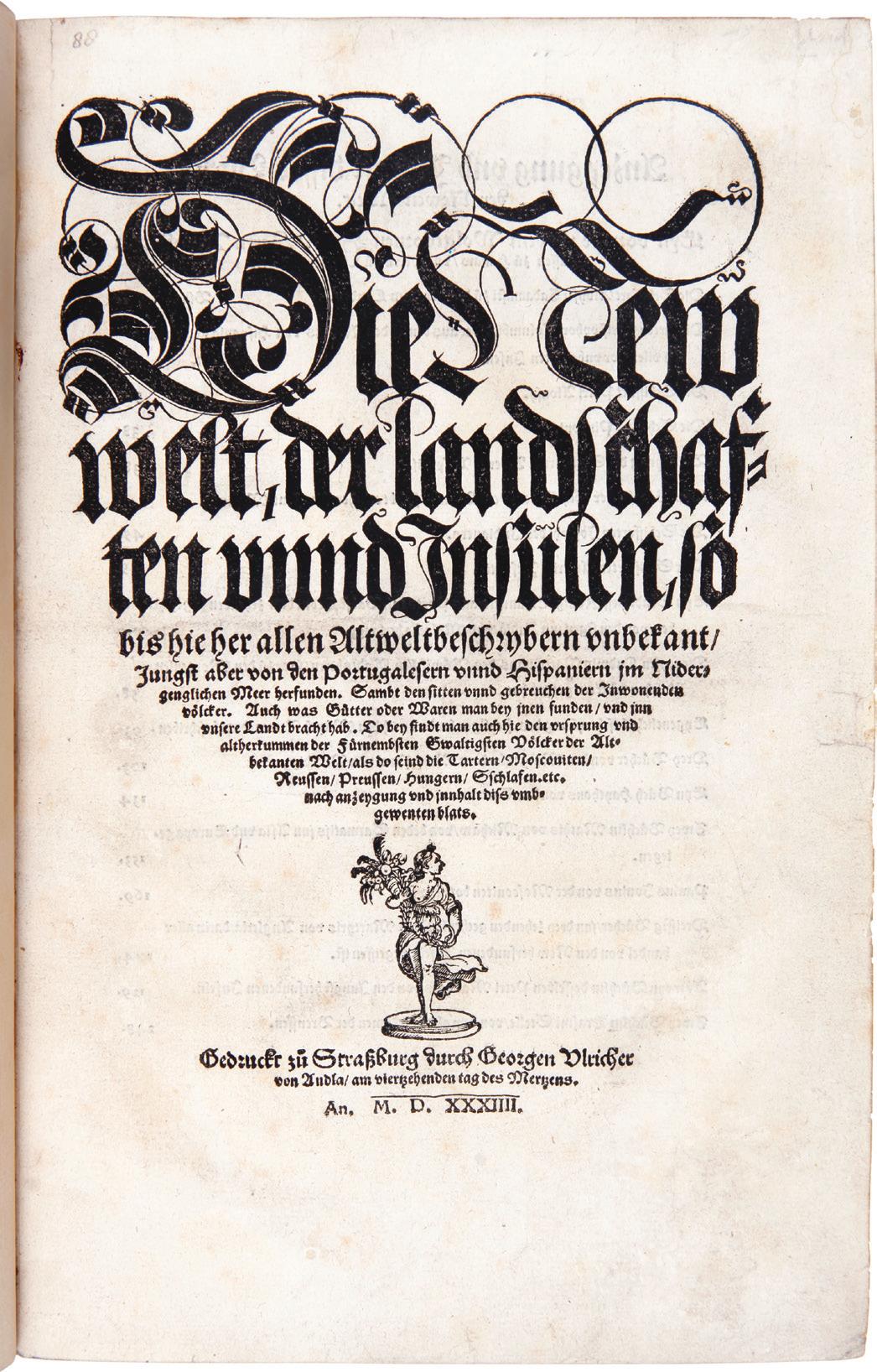
“An invaluable collection, which reflects credit upon John Huttich, who alone compiled it” (Harrisse).
Arents (Supplement) 2; European Americana 534/20; Harrisse (BAV) 188; Huth Catalogue 5374 (this copy); JCB (3) I:113; Rich 9; Sabin 34106; Streit I:33. Stevens, Historical Nuggets 2018; Ternaux 45.
$27,500

THE DISCOVERY OF AMERICA 79

IMPORTANT ILLUSTRATED SOURCE FOR PRIMARY MATERIAL ON THE NEW WORLD
34. ANGHIERA, Pietro Martire d’ [Peter Martyr]; Gonzalo Oviedo; and Giovanni Ramusio. Summario de la generale Historia de l’Indie Occidentali. Venice: 1534.
Three parts in one volume. Quarto (196 × 145 mm): A–V 4; A–Q 4 π 2; A–D 4; [1]–79; [1]–64, [2]; [15] leaves. Lacks two blanks (first V4 and third D4). Double-page woodcut map “Isola Hispagnuola” bound between first and second parts, two woodcut illustrations. Contemporary Italian marginalia and underlining. Contemporary vellum, manuscript spine title, edges red. Binding and pastedowns wormed. In a cloth chemise and half morocco and cloth slipcase, spine gilt. Remnants of title leaf mounted, with all text present. Title page with monogrammed ink stamp, faint dampstain to fore-edge of first thirteen leaves, first six and final eleven leaves wormed, grazing text in places. Extensively annotated in contemporary manuscript. Provenance: Blue ink stamp with crowned monogram “DC” on title page.
This important collection of voyages and narratives is the work of several authors, although most bibliographers attribute it to Peter Martyr, a translation of whose work makes up the first section. The present volume is one of the earliest attempts to assemble a group of accounts of travel and exploration. It was most likely assembled for publication by the Venetian, Giovanni Ramusio, later famous for his much larger collection Navigationi, which began publication in 1554.
The Historia is divided into three books. The first part is made up of material from the Decades of Peter Martyr, drawn from the edition of 1530, the first complete publication to present all eight Decades.
The second and most important part of the Summario is drawn from the first published work of the great historian and chronicler of the early West Indies, Gonzalo Fernandez de Oviedo’s De la Natural Hystoria de las Indias (Toledo, 1526), which presented the first accurate reports of New World plants and animals. Since that pioneering work of American natural history—a completely different book from Oviedo’s later Historia General—is virtually unobtainable today, the present 1534
THE PARSONS COLLECTION 80

publication is the only form in which the first work of Oviedo can be obtained. Oviedo also provides one of the first accounts of Bermuda, where he tried to land while en route to Spain in 1515, only to be driven off by adverse winds.
The distinction of being the first obtainable edition is also true of the third part. It is a translation of an anonymously written tract entitled La Conquista de Peru, first published in Seville in 1534, of which only three copies survive. Among the earliest works on the conquest of Peru, the Summario gives the text of the tract in full.
The woodcuts in the text are both drawn from the work of Oviedo and made up by the Venetian printers. They are some of the earliest published images of the New World based on actual experience, as opposed to the fantasies of European woodcut artists. There is also a handsome double-page woodcut map of Hispaniola, the earliest printed map of Santo Domingo. This map, often lacking, is an extremely early piece of detailed New World cartography and would be used again by Ramusio in his Navigationi. Burden records another map to the present work, presumed to be by Ramusio, titled “La carta universale della terra firma & Isole delle Indie occidentali”; however Burden notes its presence in only the John Carter Brown library copy of the book (with but two other separate examples of the map extant; see Burden 10).
An important early collection of voyages featuring the first obtainable editions of two landmark works, and a piece of tremendous importance in the dissemination of knowledge of the New World to Europe.
Arents 3; Church 69; European Americana 534/28; Harrisse (BAV) 190; JCB (3) I:114; Sabin 1565; Streeter Sale 13. $50,000

THE DISCOVERY OF AMERICA 81

THE FIRST GREAT CHRONICLE OF THE NEW WORLD, WITH SOME OF THE EARLIEST IMAGES OF NEW WORLD NATIVES AND PLANTS, SIGNED BY THE AUTHOR
35. OVIEDO Y VALDES, Gonzalo Hernandez de. La Historia General de las Indias. Seville: Juan Cromberger, 1535.
Quarto (287 × 215 mm): ✠4 a–z8 &10; [4], cxciii leaves; lacking terminal blank [&10]. Numerous in-text woodcuts. Marginal notes in at least three hands. Title page printed in red and black. Eighteenth-century mottled calf, spine gilt extra, leather label. Remnants of title-leaf mounted, with upper and right compartments of title border supplied from clippings of other contemporary borders, text on verso supplied in manuscript. Following leaf supplied and remargined to fit, paper repairs to lower corner through leaf xxxiii. The final leaf inscribed by Oviedo, as proper.
This famous work is the most extensive book on the New World written up to the time of publication, and is one of the chief sources to this day for many of the facts relating to the early history of the Spanish conquest of the New World. The colophon leaf is signed by Oviedo, as is found in some copies. Oviedo was a witness to that history from the beginning, having been a young page at the Spanish court on the occasion of the return of Columbus in 1493. In 1505 he went out to the Indies
THE PARSONS COLLECTION 82

himself as an official, and subsequently served in a number of important administrative posts. Over the next three decades he kept extensive notes on the history of the Spanish in the New World and all he observed there, especially natural history and the indigenous peoples he encountered. He also interviewed all of the Spanish explorers to whom he had access. In 1526 he published a short work on the natural history of the Indies, followed nine years later by the present work. His industry provides an extraordinary description of the period, one that his high offices and education gave him a unique ability to record.
Oviedo was the first writer to gather detailed and accurate information on the natural history of the New World. Over half of the Historia General is devoted to natural history, especially focusing on plants and trees. The text is illustrated with numerous woodcuts, which are the earliest extant reliable pictures of things in the New World. These include a number of botanical subjects including prickly pear, as well as artifacts including the hammock, and indigenous peoples, the most famous of which depicts natives panning for gold. Quite notably, according to Arents, this work also contains the “first occurrence in print of the now almost universal word ‘tobacco,’” as well as the first printed account of smoking tobacco for pleasure. Books 8 and 9 are entirely devoted to trees and plants, while books 10

THE DISCOVERY OF AMERICA 83

and 11 cover plants with medicinal qualities. The illustrations which accompany these chapters are the earliest illustrations of American plants drawn from nature. Book 7 is entirely devoted to agriculture in the New World, describing cultivated fruits and plants raised for food by indigenous Americans. Books 12, 13, 14, and 15 describe water animals (including his famous manatee description), birds, insects, and mammals.
The first edition of Oviedo’s book publishes the first nineteen parts of his history. The twentieth part appeared as a part of Ramusio’s Viaggi in 1551, and the remaining thirty were not published until 1851. This first edition is one of the outstanding early books on the New World, and a foundational work of the initial Spanish conquest.


Arents 4; Church 71; European Americana 535/12; Harrisse (BAV) 207; JCB (3) I:118; Medina (BHA) 4; Nissen Zoology 3032; Reese & Miles, Creating America 10; Servies, p. 1. $175,000
THE PARSONS COLLECTION
MEN OF CAJAMARCA: TWO EYEWITNESS ACCOUNTS OF EVENTS
36. XEREZ, Francisco de. Libro primo de la conquista del Peru & prouincia del Cuzco de le Indie occidentali. Venice: Stephano da Sabio, 1535.
Octavo (215 × 160 mm): π 4 a–f 8 g10; [62] leaves. Large title page woodcut coat of arms of Charles V surmounted by double-headed eagle. Woodcut printer’s device on final leaf. Modern half calf and patterned boards, spine gilt. A bit of edge wear, spine a bit rubbed. Title page a bit soiled and worn around the edges, with two minor repairs to the verso of the foredge. A bit of light foxing, a few leaves with moderate tanning. Colophon leaf repaired at upper edge, Lilly Library deaccession stamp to lower gutter corner. Provenance: Bernardo Mendel (bookplate).
The first Italian-language edition, following the first of the previous year, of Xerez’s important firsthand account of the conquest of Peru. As one of the “Men of Cajamarca,” Francisco de Xerez holds a special place among writers on the earliest period of Spanish contact with the Inca of Peru. He was an original member of the tiny band of men who left Panama with Pizarro and Almagro to seek fame and fortune in South America. At Cajamarca, he took part in the taking of the Inca leader, Atahualpa, the slaughter of his army, and the sharing of the ransom demanded of the Inca nation for the return of their leader. By training a notary public and practiced writer, he was by choice Pizarro’s secretary/confidant, the two having been close since at least 1524, when they met in Panama. In 1534, he returned to Spain, taking with him his share of the wealth of Atahualpa, a broken leg, and a tale to tell.
Appended to Xerez’s account is a brief translation of Miguel de Estete’s account of the journey of Pizarro’s army from Cajamarca to Pachacamac and then to Jauja. Estete, too, was present at Cajamarca, and is said to have been the first Spaniard to lay hands on Atahualpa.
Xerez’s eyewitness account of the conquest of Peru was originally published in Spain in 1534 in Spanish as Verdadera Relación de la Conquista del Peru y Provincia del Cuzco Llamada la Nueva Castilla. Demand for news of the new, “exotic” kingdom of Peru, which had only been conquered in 1532, was keen not only in Spain but all across Europe, leading to this rapid translation into Italian. Both of these first translations into Italian are from the pen of Domingo de Gaztelu (secretary of Don Lope de Soria, Charles V’s ambassador to Venice) and are taken from the second issue of the Spanish-language original.
The Bernardo Mendel (1895–1967) copy. He formed a noteworthy collection of Latin American discovery and exploration, the Spanish conquest, and Latin American independence movements, which was donated to the Lilly Library at Indiana University. Duplicates from his collection were deaccessioned and sold at auction in 1962.
BM STC Italian, p. 738; Church 73; European Americana 535/21; Harrisse (BAV) 200; Huth 1628; JCB (3) I:119; Medina (BHA) 95; Sabin 105721.
$30,000
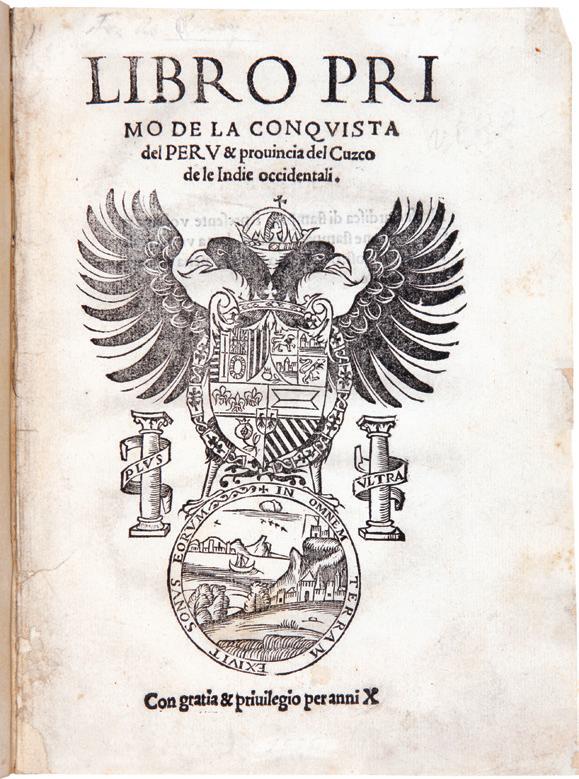

THE DISCOVERY OF AMERICA 85

THE EARLIEST OBTAINABLE EDITION OF PIGAFETTA’S ACCOUNT OF MAGELLAN’S FIRST CIRCUMNAVIGATION
37. PIGAFETTA, Francisco Antonio; and Maximilianus Transylvanus. Il Viaggio fatto da gli spagnivoli a torno a’l mondo. [Venice:] 1536.
Quarto (200 × 140 mm): A4 2A4 B–M4; [52] leaves. Modern full red morocco using eighteenth-century leather, giltruled, spine gilt with raised bands. In a black cloth chemise and black morocco box. Paper restorations to blank margin at lower corner of title page and most leaves.
Second edition, but the first practically obtainable edition, of Pigafetta’s famous narrative of Magellan’s circumnavigation, supplemented by an early edition of Maximilianus Transylvanus’s account of Magellan, the first combined appearance of the two, and the two most authoritative descriptions of that voyage. Of the utmost importance in the history of geography, navigation, the Pacific, and the New World, Magellan’s voyage proved the earth was round and resulted in the discovery of a route to the Pacific Ocean around South America. “To many the first circumnavigation of the globe, which unfolded to the world the vastness of the Pacific and a new conception of geography, is as great an event as the discovery of America” (Streeter, Americana-Beginnings).
Ferdinand Magellan (1480–1521) was born in Portugal and served his country in East Asia and Africa. In 1517 he offered his services to King Charles V of Spain, arguing that the Moluccas Islands were within the region of discovery assigned to Spain by Pope Alexander VI. Magellan and 265 sailors aboard five ships left Spain in August 1519, sailing through the straits off the southern coast of South America that now bear his name and into the Pacific Ocean, which Magellan himself named due to its tranquil nature. He sailed across the unexplored Pacific with no charts, and equipment consisting only of a compass, an hourglass, and an astrolabe, relying on the sun for his calculations of latitude, and with no knowledge of longitude. He arrived at the Philippines (which he had visited earlier while sailing from west to east), where he was killed by natives in April 1521. The command of the voyage devolved to Sebastiano del Cano, who led the remaining ships and crew across the Indian Ocean, around the Cape of Good Hope, and back to Spain. They arrived at Seville in September 1522 with only one ship, the Victoria, and with 18 sailors still alive.
The earliest account of Magellan’s voyage was written by Maximilianus Transylvanus, the son of the Archbishop of Salzburg, and a student of the great chronicler of discoveries, Peter Martyr. When the survivors of the voyage went to Valladolid to report to the emperor, Martyr instructed Maximilianus to interview the sailors and
THE PARSONS COLLECTION 86
to write an account of the voyage in Latin. The first edition was published in 1523, followed by three other editions between 1523 and 1524. This 1536 printing is the fifth edition of Maximilianus’s account, which occupies the first twelve leaves of text.
One of the sailors interviewed by Maximilianus was Francisco Pigafetta, an Italian nobleman who accompanied Magellan and who was one of the few survivors of the voyage. Pigafetta was not only highly literate, but also a meticulous observer, providing a remarkably accurate ethnographic and geographic narrative of the circumnavigation that is recognized as such by modern authorities on early encounters between Europeans and the East Indies. His account of Brunei, for example, is the first by a European and offers a comprehensive, authentic and detailed record noting the adherence to Islamic practices such as the shunning of pork, the observance of dabihah slaughter of halal animals for consumption, ritual cleanliness, and circumcision. Pigafetta’s carefully gleaned vocabularies included not only Cebuano, the language of the southern Philippines, but also words from Brazil, Patagonia, and importantly Malay, referred to by him as “Moorish,” the language of the Muslim peoples of the Moluccas. Pigafetta’s Malay word-list of over 400 entries is an important witness to the penetration of Arabic and Persian vocabularies, influencing the development of the classical Malay language, the primary instrument in spreading Islam and commercial activities throughout the region.

Pigafetta kept a journal while at sea, which he expanded into a fuller manuscript account upon his return to Italy. An abridgment of that account was published in French ca. 1525, which is known in only a handful of copies. At the Streeter sale in 1966, the French edition realized $56,000 and was the second most expensive book in the sale. The present work is the second edition overall and first Italian edition of Pigafetta’s account, translated from the earlier French version. It is also very rare, with only two copies in the auction records in the past half-century.
A fundamental source for one of the most monumental achievements in human history.
Borba de Moraes, pp. 547–8; Church 74; European Americana 536/14; Harrisse (BAV) 215; JCB (3) I:120; Palau 158777, 225741; Sabin 47042; Streeter, Americana-Beginnings 6 (ref); Streeter Sale 11 (ref).
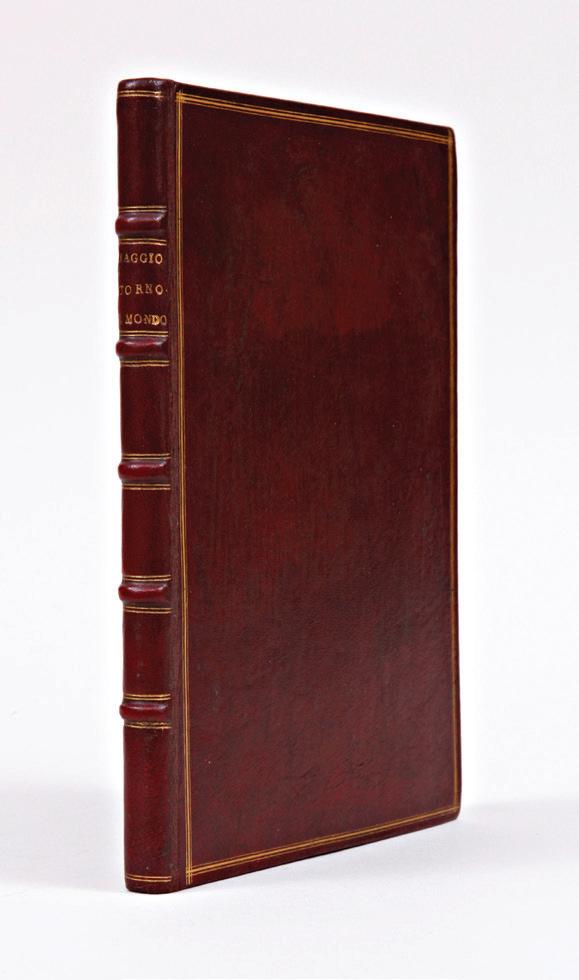
THE DISCOVERY OF AMERICA 87
SOLD

MAJOR COLLECTION OF NEW WORLD VOYAGES, WITH THE RARE WORLD MAP
38. HUTTICH, Johann; and Simon Grynaeus. Novus Orbis Regionum ac insularum veteribus incognitarum unà cum tabula cosmographica, & aliquot aliis consimilis argumenti libellis, quorum omnium catalogus, sequenti patebit pagina. His accessit copiosus rerum memoribilium index. Adjecta est huic postremae editioni Navigatio Caroli Cæsaris auspicio in comitijs Augustanis instituta. Basel: Johannes Hervagen, 1537 (colophon November 1536).
Folio (305 × 204 mm): [α–δ 6 a–z6 A–2C 6 2D8; [48], 599, [3] [i.e., 601pp., with numbers 583–4 repeated in the pagination]. Folding world map, three woodcut illustrations in the text, woodcut printer’s device on title page and last leaf. Late eighteenth-century three-quarter sheep and speckled paper covered boards, spine with raised bands and early paper label. Spine a bit abraded, minor wear at extremities. Very light tanning and foxing, repaired tear to map extending from the gutter margin into the image. Overall a bright and clean copy with wide margins.
Second Hervagius edition of only the second major collection of New World voyages, adding the letter of Maximilian of Transylvania to the Cardinal of Salzburg recounting Magellan’s voyages of 1519–22. Novus Orbis was compiled almost entirely by Johann Huttich, though Simon Grynaeus (who contributed the introduction) is often credited.
In addition to its importance as an early collection of voyages both to the East and West, this work is celebrated for the attractive folding world map titled “Typus cosmographicus universalis,” frequently lacking. The map is particularly remarkable for being one of the first to show the earth spinning on its axis, illustrated by an angel at each pole with a crank to turn the world. At the time of the first edition in 1532, this visual representation of Copernican theory predated by eleven years the publication of his De revolutionibus orbium coelestium. Shirley, noting the “richness of artistic decoration,” attributes this map’s cartography to Münster and its border decoration to Holbein. In the Western Hemisphere, South America is labeled “America Terra Nova” and is presented in generally recognizable shape. A landmass to the north, styled as a large island separated from South America by an isthmus, is labeled “Terra de Cuba.” The woodcut border features scenes of explorers and indigenous peoples of various corners of the globe, including what appear to be acts of cannibalism. This copy is of the state with “Asia” printed in large capitals, others are found with a different font.
Novus Orbis was first printed by Hervagen in 1532, and is considered the second great collection of voyages, preceded only by Montalboddo’s genre-defining Paesi novamente retrovati. Indeed, Novus Orbis begins by reprinting the Latin translation of Montalboddo’s landmark work. This text includes the accounts of Cadamosto and Sintra’s travels to Africa, Vasco da Gama’s voyage to eastern Africa and India,
THE PARSONS COLLECTION 88
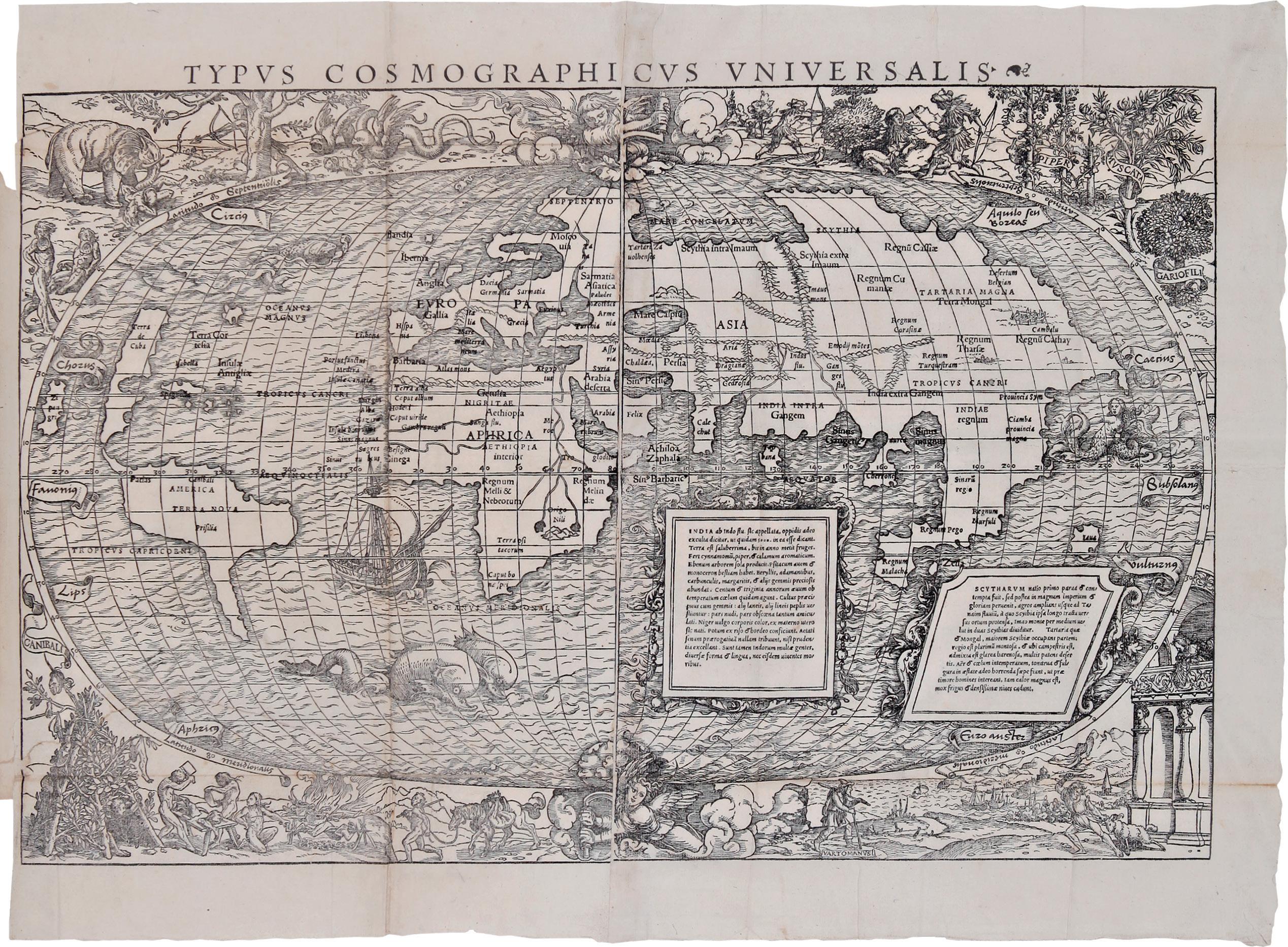
and Cabral’s discovery of South America in 1500, as well as details of Columbus’s first three voyages, Niño and Pinzon’s further explorations of the South American coast, and Vespucci’s third voyage.
Added to this eminent collection are ten more accounts, which include Vespucci’s letter to Soderini, a summary of Peter Martyr’s Fourth Decade, and several other accounts of travels in Russia, India, the Holy Land, and the East. This second edition of 1537 further appends Maximilian Transylvanus’s account of Magellan. Much as Montalboddo’s text proved integral to the work of Huttich and Grynaeus here, the Novus Orbis would become a primary source for future compilers such as Ramusio and particularly Rabelais.
An extensive, important, and early collection of voyages, complete with the exceedingly rare world map. “An invaluable collection, which reflects credit upon John Huttich, who alone compiled it” (Harrisse).
Adams G-1334; European Americana 537/14; Harrisse (BAV) 223; Sabin 34103; Shirley 67 (map).
$75,000

THE DISCOVERY OF AMERICA 89

THE PILLONE RAMUSIO, WITH PAINTED FORE-EDGES BY A PUPIL OF TITIAN
39. RAMUSIO, Giovanni Battista. Delle Navigationi et Viaggi . . . in Tre Volume divise. Venice: Giunti, 1550; 1573/4; 1565.
Three volumes. Small folio (311 × 221 mm). Volume I: * 4 a–z 8 A–2D 8 2E 6; [4], 405, [1 blank] leaves. Volume II: 1–2 6 3 4 4–5 6 A–2H 8; 30 [i.e., 28], 248 leaves. Volume III: A6 B–D 8 E 10 a–2y 8 2z 10 3a–3e 8 3f 4 3g–3h8 3i–3k 6; [6], 34, 456 leaves. Single-page maps and plans in first volume. Seven double-page maps in third volume (one supplied). In-text woodcut plans and diagrams, woodcut initials (some handcolored), and printer’s devices lightly gilt, some text passages highlighted in gilt, extensive manuscript shoulder annotations throughout. Uniform contemporary stiff vellum. Fore-edges of volumes II & III decorated with paintings of a scholar reading at a lectern and a struggle between sailors and native peoples, respectively. Endpapers lacking, scattered light staining or minor worming to blank margins, otherwise bright and clean. Volumes in uniform linen clamshells with gilt morocco labels. Provenance: Odorico Pillone (1503–1594); Sir Thomas Brooke (1830–1908; bookplate); sold by his heirs in 1957 as part of the Pillone collection to Pierre Berès (bookplate).
A unique and beautiful set of the first scholarly voyage collection assembled in the sixteenth century, one of the first in a modern language, with more maps and illustrations than any prior anthology, containing accounts not previously published, and here in a highly personalized copy, with bespoke fore-edge decoration created for one of the most noteworthy private collections of Northern Italy during the sixteenth century. “In terms of wealth of material, no previous compilation of travels could match Ramusio’s achievement” (Lach). Ramusio’s compilation is of particular interest for Americanists for presenting the first printed accounts of Verrazzano in New York and Ulloa in California, in addition to those of earlier chroniclers such as Oviedo, Martyr, and others. This copy is also highly unusual among travel books of the period for showing extremely regular marginal annotations by a sixteenth-century Italian reader.
Ramusio’s effort is the first general compilation of narratives of the European exploration of the rest of the world. From John Locke to Henry Harrisse, scholars and
THE PARSONS COLLECTION 90

bibliographers have praised Ramusio for his choice of material, his care and accuracy in presenting it, and his assiduous sorting of the evidence of the new discoveries. The present set is, as often, a mixed edition, comprising the 1550 first edition of volume I, the 1574 second edition of volume II (first published in 1559), and the 1565 second edition of volume III (first published in 1556). The later seventeenth-century editions of Ramusio are more frequently encountered.
A public servant of the Venetian republic, Ramusio was the first genuine scholar to produce a travel collection, translating the documents directly from the original sources whenever possible. His purpose in compiling it was in line with sixteenth-century Italian humanism, the dissemination of increasingly rare historical texts in accurate editions in the vernacular; the end in view is historical knowledge rather than commercial reconnaissance. Ramusio was involved with a distinguished circle of Venetian humanists, including such luminaries as Bembo, Navagero, Paulo Manuzio (of the
THE DISCOVERY OF AMERICA 91
Aldine publishing house) and Girolamo Fracastoro, although the work’s place in sixteenth-century Italian historical writing appears largely unconsidered.
Volume I contains the accounts of the great Portuguese voyages around Africa and onto Asia, including those of Vasco da Gama and Alvise da Cadamosto, the relations of Leo Africanus, Amerigo Vespucci, and Alvarez, as well as Maximilian of Transylvania’s and Antonio Pigafetta’s accounts of the voyage of Magellan. Also included here is a substantial section on Japan drawn from various Jesuit accounts available to the author including the famous letter from Francis Xavier in which he describes Japan for the first time to a western audience.
Volume II contains various accounts to the Near and Far East as well as to the extreme north including those of Marco Polo, Herberstein, and Zeni. There is considerable information on Poland also appearing in this edition for the first time.
Volume III, devoted to early exploration of North America and illustrated with seven large woodcut maps by Gastaldi, includes descriptions by Peter Martyr, Oviedo, Cortez, Pizzaro, Cabeza de Vaca, Verrazzano, and Cartier, among others. The account by Verrazzano is of particular importance, being the very first account in print of his “discovery” of New York harbor. Similarly, the volume includes the first printed relations of the expeditions of Francisco de Ulloa (1539) through California to the mouth of the Colorado.
The maps in this volume include, in addition to the map of Brazil, “La Nouva Francia,” which is the second separate map of the northeast of the present day United States, “La Terra de Hochelaga,” the first plan of Montreal and the earliest printed plan of a settlement in North America. Gastaldi’s map of the western hemisphere is, according to Wheat, “the earliest cartographic reflection” of the advance of European knowledge of the American west.
Books from the Pillone library have long excited the interest of collectors and scholars, not only for their celebrated bindings and binding decorations by the Titian pupil Cesare Vecellio and his workshop, but for the light they shed on the formation of a highly sophisticated, Northern Italian library near Venice. The outstanding bindings, which include examples of workshops otherwise unknown, have received a study from A. A. Hobson, who also gives a sketch of the library’s history.
The painter Cesare Vecellio (1521–1601) was a nephew (or cousin) as well as a pupil of Titian; he is represented in the Brera in Milan, and his Trinity in that collection is his best known painting. An intimate of the Pillone family, he was commissioned by Odorico Pillone and his three sons to provide decorations of two types: pen-and-wash drawings to adorn the covers of their books or elaborate fore-edge paintings. In the case at hand, the artist has chosen a scholar standing at a reading lectern for volume II; a battle between sailors and a group of natives for vol. III; volume I has unfortunately faded, but one can possibly make out the shape of a trireme.
Of the 170 known titles from the Pillone library, 150 have painted fore-edges and 20 pen-and-wash drawings on the covers. In either case, Vecellio was required to epitomize the contents of the particular work in a suitable or revealing way and fit it into the comprehensive decorative scheme of the library. The rows of painted fore-edges and decorated covers arrayed on shelves were evidently a magnificent sight, and raise
THE PARSONS COLLECTION 92

to new heights the Renaissance bibliophile’s desire to make his own or “personalize” his book far beyond the formulaic choice of binding or the imprinting of a coat of arms.
All three volumes of the present set feature steady marginal annotations in a contemporary Italian hand. Generally these mirror printed shoulder notes, assigning section headings and clarifying or summarizing key points. They are accordingly integral to the printed text, much as similar notes were in the era of manuscripts and incunables. Although none of the volumes is signed, the hand is very close to that of some members of the Pillone family reproduced in the Beres catalogue; even if we cannot identify the particular family member, the provenance and longevity of their location in the Veneto provide a control on the milieu and profile of the annotator. The copy thus provides highly unusual testimony for the personal reactions and topical interests of a rich and worldly but not particularly scholarly sixteenth-century Italian reader when encountering the expanded geographical and cultural horizons described. The usual paucity of annotation in travel books makes the Pillone Ramusio a highly unusual document internally as well.
A highly important compilation of world voyages and a cornerstone of any collection of travel literature.
Adams R-138, R-140; Borba de Moraes, pp. 698–9; Church 99; Cox I, p. 28; European Americana 550/31, 565/58; Hill 1418; Sabin 67730. Wagner, Spanish Southwest 3, 4, 5, 6; TPL 1; Pierre Beres, Bibliotheque Pillone; Catalogue of the manuscripts and printed books collected by Thomas Brooke (London, 1891); A. A. Hobson, “The Pillone Library,” in The Book Collector VII (1958) 28–37; Samuel J. Hough, The Italians and the Creation of America #32; Ernst Kyriss, “Bibliotheque Pillone” in Borsenblatt fur den Deutschen Buchhandel 14, no. 32, 22 April 1958. SOLD
THE DISCOVERY OF AMERICA 93
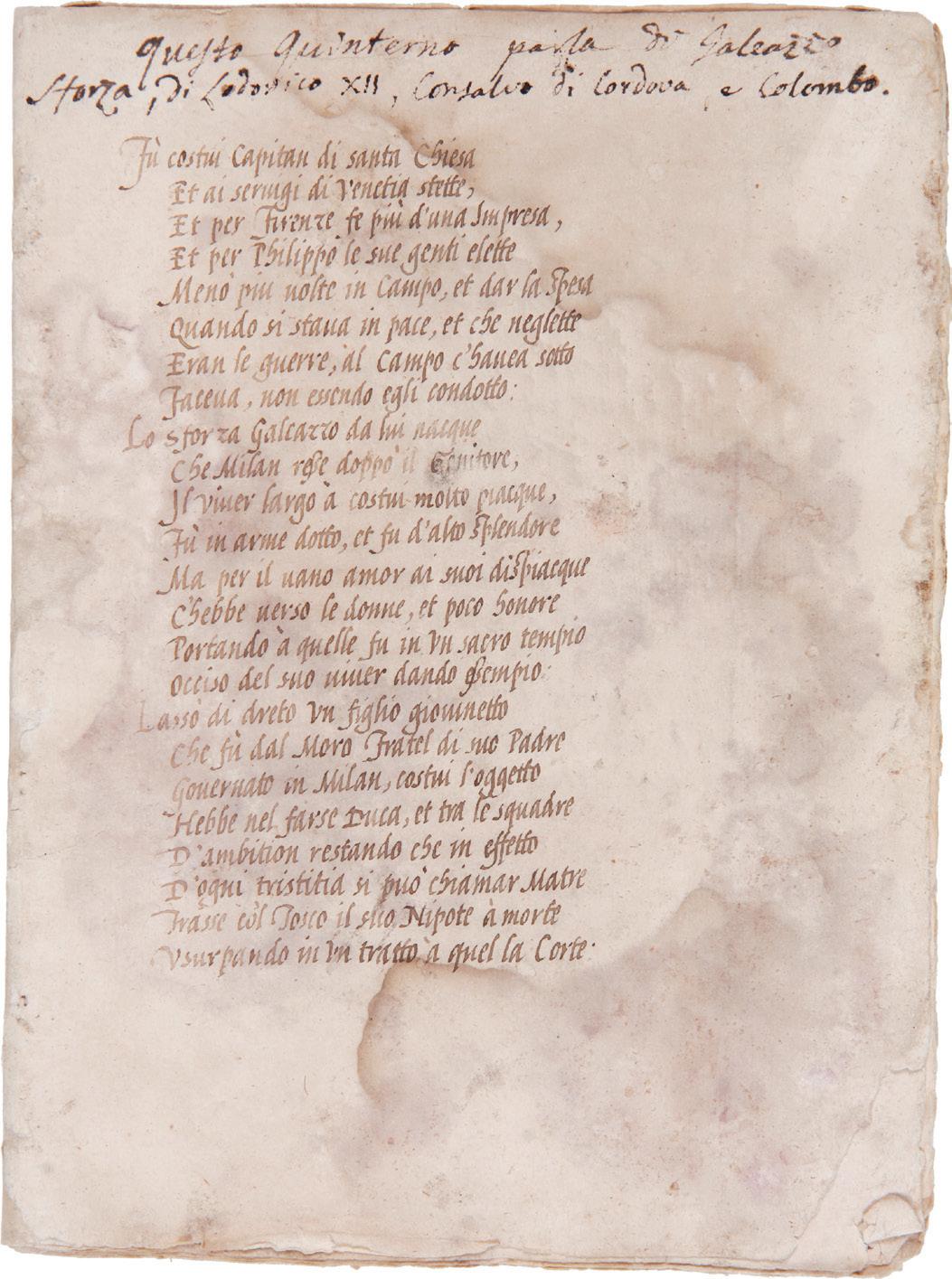
THE EARLIEST ENTIRELY ORIGINAL EPIC POEM ON COLUMBUS
40. (COLUMBUS, Christopher.) [Manuscript poem in Italian, being a long biographical account of Columbus, ca. 1550.]
Manuscript on paper. Quarto (164 × 220 mm), structured with a ternion and a bifolium nested inside of a ternion, 14 leaves. Text written in brown ink in an Italian humanistic italic hand. Circa 1800 inscription at head of first leaf, by a dealer or collector: “Questo Quinterno parla di Galeazzo Sforza, di Lodovico XII, Consalvo di Cordova e Colombo.” Disbound, evidence of contemporary stitching. Housed in a custom blue quarter morocco solander box with blue cloth sides, and matching chemise. Contents dampstained, the text remaining clear and legible throughout, outer margins chipped, small loss to a couple of corners, paper repairs at folds and edges of outer ternion, paper repair to small hole on last leaf affecting a few letters on verso (“Pig[liar].. En[trar] [u]na pregione”). A well-preserved example.
The only known copy of this long biographical account of Columbus, it is the earliest poetical work in vernacular inspired by the contemporary sources on his life and discoveries. An extraordinary survival, the anonymous epic poem is composed in ottava rima by a skilled versifier and follows the Renaissance model of Boccaccio, Boiardo, Pulci, and Ariosto.
The text comprises 712 hendecasyllabic verses arranged in 89 octave stanzas. The first 18 pages (60 stanzas, 480 lines) treat the military conflicts in Italy during the French and Spanish conquests and subsequent rivalry of the early sixteenth century. Most of
THE PARSONS COLLECTION 94
the events described fall in the period 1500–10. The remaining ten pages (29 stanzas, 232 lines) are dedicated to Columbus, his birth, youth, and education, his suit to King Ferdinand and patronage by Queen Isabella, his first voyage of discovery to America, his triumphant return, and part of his second voyage. The events are related by an internal narrator, who identifies himself as Emperor Maximilian I.
The primary sources on Columbus are Paolo Giovio’s Elogia virorum illustrium (1546, containing a literary portrait of the explorer) and his Vita di Consalvo di Cordova (1547). The text contains details which are only recorded by Giovio among all early commentators: for example, the town of Arbizolo (modern-day Abissola) identified as Colombus’s birth place and the mention of five instead of three caravels. Other contemporary works echoed in the poem are Oviedo’s Historia general y natural de las Indias (1535) and Pietro Martire d’Anghiera’s De orbe novo (1504–30).
A critical edition of this manuscript was published in 2010 by Stelio Cro, who suggested that the abrupt ending of the text might indicate that it was left unfinished; however, a faint inscription in the same hand at the bottom of the last page (“Isola grande”) might be a catchword, thus suggesting that this manuscript was part of a longer text, the remainder of which is lost.
Cro suggested an approximate date of composition between 1546 and 1556 based on internal evidence. The terminus post quem is the publication of Giovio’s Elogia The terminus ante quem is the abdication of Emperor Charles V, who is mentioned in stanza 61; other details in the text strongly suggest that the poem was composed during his reign. Further dating evidence is provided by the paper. The manuscript is written on two paper-stocks. One has a watermark depicting a circled anchor surmounted by a six-pointed star and with “M” below, which corresponds to Briquet 531 and was used at Mantua in 1542 and at Reggio Emilia between 1539 and 1547. Other leaves bear a more conventional and less distinctive bull’s head watermark.
The only vernacular antecedent to this poem is Giuliano Dati’s adaptation into Italian stanzas of Columbus’s famous letter on the first voyage, published in 1493 and based on the Latin translation of Leandro da Cosco. Dati’s poem, however, is the work of a translator, with little selective or critical input of his own.
Leicester Bradner, in his census of sixteenth-century poetry on Columbus, identified the first important passage of poetry devoted to Columbus as that in Fracastoro’s neo-Latin poem Syphilis (1530), noting however that the passage is merely incidental. In the poem, the segment on Columbus serves as historical context to the origin of the new disease; the discovery of the new world is presented in a negative light.
Though one of the fifty cantos of Luis Zapata’s epic Carlo famoso (1566) is devoted to Columbus, the first full-scale “Columbus poem” is recognised by Bradner as the four-book neo-Latin De navigatione Christophori Columbi of Lorenzo Gambara (1581). Before 1600, the only other recorded poems are the neo-Latin Columbeidos libri priores duo (1585) by J. C. Stella, the Spanish Elegias de varones illustres de Indias (1589) by Juan de Castellanos, and the Italian Il mondo nuovo (1596) by Giovanni Giorgini.
THE DISCOVERY OF AMERICA 95
continues overleaf
The present poem, predating Gambara, Stella, Giorgini, and Castellano, is therefore the earliest known entirely original epic poem about Columbus in vernacular. A celebration of Colombus’s voyages, it is also the first positive reaction to the Discovery in poetry.
The anonymous poet was certainly a native Italian writing for readers in Italy, as suggested by lines such as: “come in Italia il bel Maggio si vede / Che’ mese temperato, & vago, & bello” (“it looks like Italy in May, a warm, lovely, and beautiful month”), a metaphor describing the mild climate of the island upon which the men disembark. The watermarks and evidence of seemingly authoritative corrections to the manuscript (notably in stanza 22, “intrando” for “pugnando”, but elsewhere in the earlier text) support the Italian origin of this text.
Lorenzo Gambara of Brescia (1506–1596), in the introduction to his De navigatione, wrote that in 1536 a courtier of Charles V, Antoine Perrenot, suggested him to write an epic on the discoveries of Columbus. No such poem was known to Bradner, writing in 1951, but the present manuscript perhaps indicates that the project raised by Perrenot was eventually taken on, if not by Gambara himself, by someone in the same circle. Gambara’s note in De navigatione, remembering Perrenot’s proposal 45 years later, shows that he seriously entertained the idea—a mention of his home town, Brescia, appears here in the fifth stanza.
Stelio Cro, “Un poema inédito sobre Cristóbal Colón y el gran capitán”, Cuadernos para investigación de la literatura hispánica, vol. 35, 2010. See: Leicester Bradner, “Columbus in Sixteenth-Century Poetry”, in Frederick R. Goff, ed., Essays Honoring Lawrence C. Wroth, 1951; Theodore J. Cachey, “The Literary Response of Renaissance Italy to the New World Encounter”, Claudel Studies, vol. 15, 1988; Wolfgang Haase & Meyer Reinhold, The Classical Tradition and the Americas, vol. I, 1993; Jozef Ijsewijn, “America”, in Jozef Ijsewijn and Dirk Sacré, eds., Companion to Neo-Latin Studies, 1990; Moses M. Nagy, Christopher Columbus in World Literature: An Annotated Bibliography, 1994.
$85,000

THE PARSONS COLLECTION 96

THE CROWN JEWEL OF PORTUGUESE TRAVEL WRITING: FIRST EDITIONS OF THE FIRST TWO DÉCADAS
41. BARROS, João de. Asia de Joam de Baros, dos feicos que os Portugueses fizeram no descobrimento & conquista dos mares & terras do Oriente . . . [bound with:] Secunda decada da Asia. Lisbon: Germao Galharde, 1552–53.
Two volumes bound in one. Folio (390 × 260 mm). Volume I: π 4 a–q 8; [4], 128 leaves. Volume II: π 2 A–S 8; [2], 143, [1] leaves, with errors in foliation as issued. With two errata leaves, evidently unrecorded. Early vellum, spine with raised bands and gilt label. Front joint repaired. Minor waterstaining to upper corner of title, with light foxing in same area on the following leaves, minor reinforcement to lower gutter verso; repaired light worming to upper margin of second work, occasional minor toning or foxing throughout. A fresh copy with broad margins. Provenance: San Pietro in Vincoli (small library inkstamp on title page).
Very rare first editions of the crown jewel of Portuguese travel writing, systematically describing the discovery and colonization of Portuguese possessions world-wide up to 1515. Barros’s Asia was the only sixteenth-century work written in Portuguese to receive a significant European reception, and is of outstanding importance for both the Far East and Brazil.
The first Decade covers the discoveries and explorations through 1505 and includes descriptions of the circumnavigation voyages of Vasco da Gama (1497–98 and 1502–04) and Pedro Alvares Cabral (1500–01). The second Decade, covering 1505 to 1515, has significant material on the defeat of the Egyptian-Gujarati fleet off Diu in 1509,
THE DISCOVERY OF AMERICA 97

Alfonso de Albuquerque’s efforts to capture Hormuz and Goa, the early history of Malacca and Singapore, and the defeat of the Sultan of Japara’s fleet by Fernão Peres de Andrade in 1513, which established Portuguese supremacy in the eastern end of the Indian Ocean. Barros himself was deeply invested both politically and economically in Brazil, and personally sponsored two expeditions to his lands there. The first of these is detailed in the present work along with a treatment of its discovery, making it a book of note to the Western Hemisphere as well as the East. The collection was continued in two more volumes after a considerable lapse (published in 1563 and 1615 respectively), both in smaller format and the second posthumous.
Of all the colonies in Portugal’s vast empire, the author’s personal interest in Brazil was greatest. Indeed, in a remarkable passage in the preface to Hakluyt (1582, pp. 5–6), Barros is credited as nothing less than the architect of Portugal’s colonial policy in the country, a view strongly endorsed by Charles Boxer. Barros was among the original lord-proprietors (donátarios) of one of the country’s twelve captaincies, which came with phenomenal rights and privileges. He sponsored two grand and ambitious expeditions to develop the region. The first, undertaken in 1535, is described in the present work as containing the largest number of mounted men ever sent such a distance from the Iberian peninsula. His second attempt was launched in 1555, and thus could be said to have been funded in part by the success of these initial volumes of his masterwork. Ultimately, neither venture was successful (and the second nearly ruined him), but the connection aptly suggests why Barros was an extremely reliable chronicler: vital economic and political interests, whether personal or those of the Crown, were at stake.
THE PARSONS COLLECTION 98
Among sixteenth-century readers and travellers, the reception of Asia was enormous: in his influential exhibit “Europe Informed,” Francis Rogers studied multiple booklists to identify in a historically controlled way the earliest travel accounts to disseminate information about Asia to Europeans: Barros is not only on every list but holds first place on all of them. From a more recent vantage point, in Laures’s chronologically arranged bibliography listing of the earliest printed European works devoted to Japan, Barros’s Asia is the second entry, and dates from the same year as the first.
Although he received an excellent humanistic education, Barros was very much a man of the world, holding the powerful posts of treasurer for the Casa da India and subsequently Factor, which made him the senior government official in connection with African and Asian colonies and the spice trade. Donald F. Lach writes in Asia in the Making of Europe: “Because of his official position, Barros had at his disposal the full facilities, documents, and . . . reports of the Casa da India. All the Portuguese manuscript sources now extant—such as the account of Tome Pires, Domingo Paes and Fernao Nuniz—were used in the preparation of the Decadas. For geographical locations he depended implicitly on the written and oral accounts of the pilots and navigators who had sailed in Eastern waters and, on their testimony, did not hesitate to point out the mistakes of the Ptolemaic geographers. Nor was he satisfied to use the evidence of European observers exclusively. He was constantly trying to procure native accounts of the Eastern regions. For his remarks on India, he assembled Persian, Arabic, and Indian manuscripts and bought educated slaves to translate them for him. He also had Chinese books and a Chinese slave as a translator. He likewise sought to assemble information from the oral tradition of places which had no written histories. But, whether his sources were of European or Asian provenance, he tried, according to his own statement, to use them judiciously in order to produce a balanced narrative without ‘too much of any one thing’. The result of his labors was a history that stands as one of the classics of Portuguese literature and of European historiography” (Lach).
The work numbers among the rarest collected travel accounts, in part because of the relatively backward state of publishing in Portugal at the time, and in part because it was a thoroughly well-read and used source which was nonetheless supplanted by later accounts in more accessible languages. Already in 1597, Diogo Couto declared in the introduction to his continuation of this work that “the first edition is so consumed by time, that I do not know whether there are ten volumes in Portugal, and in India even one” (quoted in translation in Borba de Moraes). A worldwide census reported by Leite de Faria in 1990 located a mere five copies in the US, five in Brazil and 13 in Portugal. The first edition is a noted rarity with only this example appearing in the auction records for the last half century.
Borba de Moraes, p. 86; Brunet I, 669; Cordier, Japonica 31; European Americana 552/4 and 553/9; Laures 117; King Manuel 74; Portugal-Brazil, 147; Rogers, Europe Informed, pp. 51–2; Sabin 3646. C. R. Boxer, Joao de Barros; Portuguese Humanist and Historian of Asia, pp. 95–105; Lach, Asia in the Making of Europe 1.190–2; D. Schaffer, Portuguese Exploration to the West and the Formation of Brazil 1450–1800, 13.
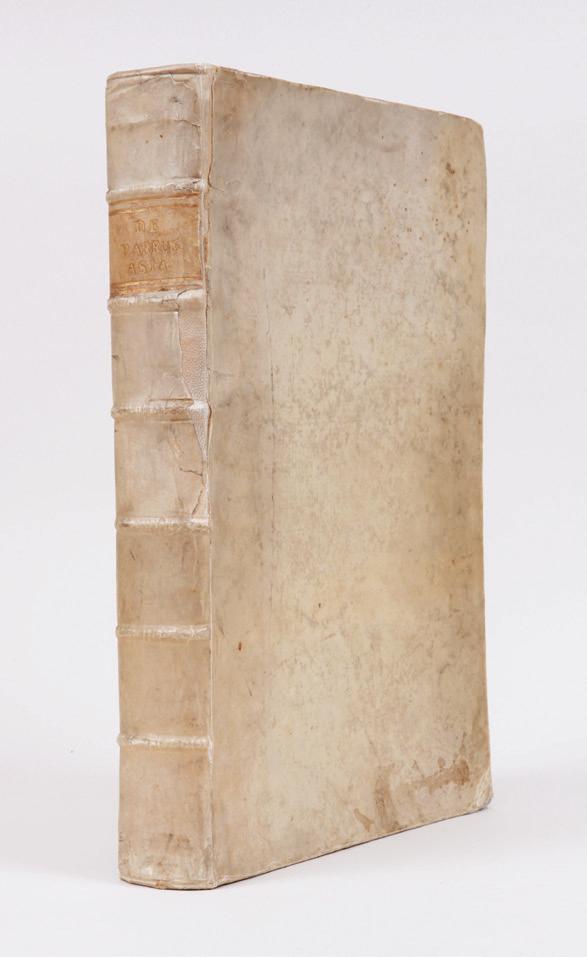
THE DISCOVERY OF AMERICA 99
SOLD

LAS CASAS’S FIRST AND MOST INFLUENTIAL TRACT
42. LAS CASAS, Bartolomé de. Brevissima relacíon de la destrvycion de las Indias. Seville: Sebastian Trugillo, 1552.
Small quarto (204 × 148 mm): a–e 8 f 10; [50] leaves. Lacking the 4-leaf appendix with drop-title Lo que se signe es un pedaco de una carta y relation (considered the second Las Casas tract and often listed separately by bibliographers). Title page printed in red and black. Elaborate woodcut border enclosing title and coat of arms of Charles I, woodcut initials throughout. Modern dark brown paneled calf, spine gilt with raised bands. Lightly tanned, minor soiling.
The first edition of Las Casas’s first and most important tract, establishing his role as the leading European champion of human rights for the indigenous people
THE PARSONS COLLECTION 100
of the New World. Las Casas first went to America in 1502, spending the next forty-five years positioned in Mexico and the Caribbean. He witnessed firsthand the appalling destruction of the native population at the hands of the Spanish, and dedicated his life to ending the encomienda system (which enslaved indigenous Americans to their conquerors) and its concomitant abuses. Despite his efforts making him unpopular with the leading Spaniards of the New World, he was made Bishop of Chiapas for a brief time before retiring to Spain in 1547, at which point he set forth the dark story of the wrongs wrought by the Spanish in this, his first and most famous tract, the Brevissima Relacion. Written primarily in 1539, it was finally completed and published following the famous Valladolid Debate in 1552, and was swiftly followed by eight other tracts.
The tracts of Las Casas set forth his views on the essential humanity of indigenous Americans, and were among the earliest petitions for the better treatment of native peoples. The text of the Brevissima Relacion focuses on abuses committed throughout the Spanish dominion, including Hispaniola, Cuba, Puerto Rico, Jamaica, and other Caribbean islands, Mexico and Central America, and notably sets forth Las Casas’s core ideology that the indigenous Americans, whether converted to Christianity or not, were rational human beings having full and equal rights with Christians and Europeans. He closes with a postscript that declares that, despite the New Laws of 1542 technically abolishing the encomienda system, the order had been largely ignored, and the horrors committed against the people of the New World remained as outrageous as before. This copy lacks the four-leaf appendix, which is considered the second Las Casas tract and often listed separately by bibliographers, but was issued integral to the first.
Despite the uphill battle Las Casas faced, his tracts were immediately influential: translations of the Brevissima Relacion appeared in French, English, Dutch, and German by the end of the century, and by the early 1600s even Spain’s fellow Catholics in Italy felt compelled to print their own editions. This profusion of later translations and editions, often adorned with graphic illustrations, transformed Las Casas’s works from a humanitarian plea into an important political and diplomatic tool, promulgating the “Black Legend” of Spanish atrocities in the New World throughout Europe. Regardless of the motives behind publication, Las Casas’s works rank among the most important source materials for the early history of European colonization in the Americas, and the Brevissima Relacion endures as one of the outstanding pieces of sixteenth-century Americana.
“The Brevissima relacion remains today almost unparalleled in the vigor of its composition and the nobility of its design . . . The work is divided into nineteen Articles, each portraying in detail the condition of the Indians, in one of the provinces of Spanish America” (Field).
Church 87 (listing the appendix as entry 88); European Americana 552/8; Field 860; JCB (3) I:167 (listing the appendix as entry 168); Medina (BHA) 151; Sabin 11227 (listing the appendix as entry 11228).
$25,000
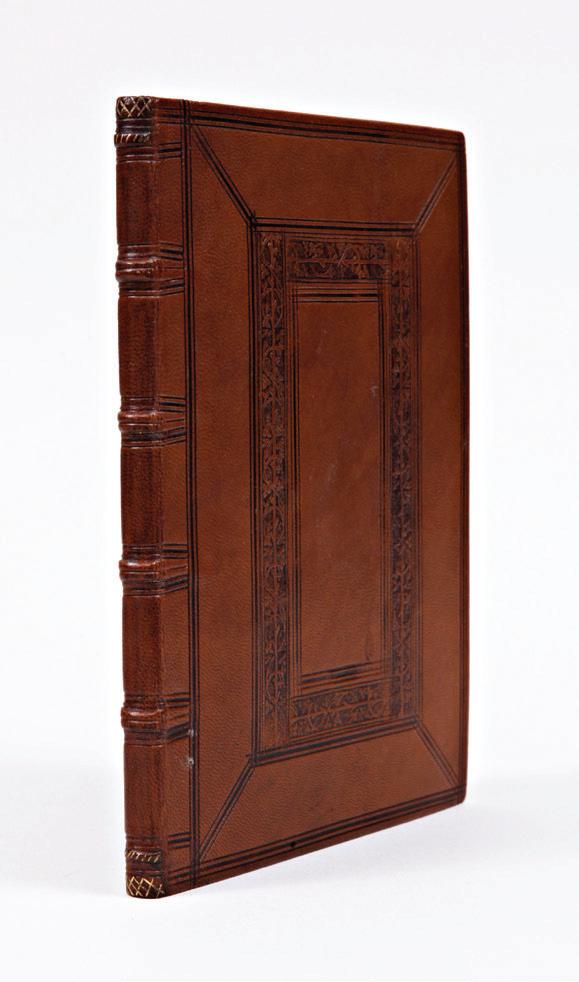
THE DISCOVERY OF AMERICA 101
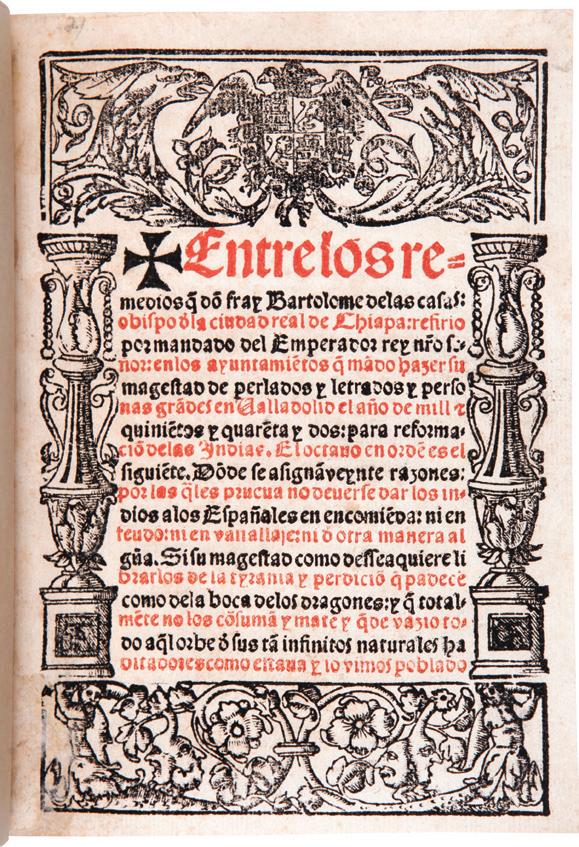
THE THIRD LAS CASAS TRACT
43. LAS CASAS, Bartolomé de. Entre los Remedios que don Fray Bartolome de Las Casas . . . refirio por mandado del Emperador rey . . . para reformacion delas Indias. Seville: Jacome Croberger, 1552.
Quarto (185 × 133 mm): a–f 8 g6; [54] leaves. Title page printed in red and black, with elaborate woodcut border. Woodcut initials. Modern dark brown paneled calf, spine gilt with raised bands. Lightly tanned, faint dampstain to lower corner of last three leaves, a few trimmed marginal annotations. Very good.
The first edition of Bartolomé de Las Casas’s third tract advocating the better treatment of indigenous Americans by the Spanish, considered by some the first book dedicated to the abolition of slavery in the Americas. “This tract gives the eighth of the proposed remedies, and assigns twenty reasons to prove that the Indians should not be given to the Spaniards in any form of slavery” (Church).
This is generally considered the third tract, though Medina argues that it may have been the first printed, and Las Casas continues his arguments from the preceding two with his eighth suggested remedy for the ills of the Indies, one which he calls in this work “among all of them the most substantial and important, for without it the rest amount to nothing” [our translation]. This is directed to the king himself, namely: “That your majesty mandate, order, and constitute in his full said majesty and solemnity . . . that all of the Indians who are now or will from now be in all the Indies are subjects . . . of the royal crown of Castille and Leon.” While Las Casas achieved a victory of sorts with the abolishment of the encomienda system in 1542, it was tempered by the introduction of the repartimiento, a system of forced labor which relied on the legal distinction between Spanish subjects (the república de españoles) and indigenous Americans (the república de indios), a division which Las Casas responds to directly in the present work.
A rare and valuable work by one of the earliest proponents of equal rights and abolition in the Americas.
Church 89; European Americana 552/9; JCB (3) I:169; Medina (BHA) 146; Palau 46942; Sabin 11229.
$20,000

THE FOURTH LAS CASAS TRACT
44. LAS CASAS, Bartolomé de. Tratado comprobatorio del Imperio soberano y principado uniuersal que los Reyes de Castilla y Leon tienen sobre las Indias. Seville: Sebastian Trugillo, 1552 [i.e. 1553].
Small quarto (195 × 140 mm): a–k 8; [80] leaves. Title page printed in red and black, with elaborate woodcut border. Without the rare printed cancel slips on e5 and f6, but with the missing lines supplied in nineteenth-century manuscript by “L.E.C.” Modern dark brown paneled calf, spine gilt with raised bands. Light wear to joints, occasional small manuscript annotations, minor scattered foxing. Provenance: L.E.C. (inscription, dated 1873).
“The purpose of this tract is to prove the sovereign empire and universal dominion by which the kings of Castile and Leon hold the West Indies” (Church). This is the longest of Las Casas’s essays, and was considered by the great collector Salva “to be the rarest of all those by Las Casas” (Palau).
THE PARSONS COLLECTION 102
This is the longest of his tracts, and is generally considered the fourth in the series (though the sequence is not definite). Las Casas begins with two foundational conclusions, first, that “The rulers of Castile and Leon hold just title to universal sovereignty to the entire world which we call the Indian Oceans . . . and over the native kings and leaders thereof.” Second and most importantly, “With this universal sovereignty . . . over the Indians, it follows that the native kings and lords of the Indians maintain their own administration, jurisdiction, rights, and dominion over their own subjects or whatever polity they govern in reality” [our translations]. Essentially, Las Casas argues that while the Spanish king holds ultimate power over the West Indies, indigenous leaders remain legitimate rulers in their own dominions as his subordinates, invested with all the rights and responsibilities that implies.
A rare and important early work championing the legal and human rights of indigenous Americans, as well as of European imperial political theory. Church 96; European Americana 553/19; Field 869; JCB (3) I:174; Medina (BHA) 156; Palau 46947; Sabin 11231. $20,000
THE FIFTH LAS CASAS TRACT
45. LAS CASAS, Bartolomé de. Aqui se contiene una disputa o controversia; entre el Obispo dõ Fray Bartholome de Las Casas . . . y el Doctor Gines de Sepulveda. Seville Sebastian Trugillo, 1552.
Small quarto (194 × 145 mm): a–g 8 h6; [61] leaves, lacking terminal blank h6 (not called for by Medina). Title page printed in red and black with elaborate woodcut border, woodcut initials throughout. Occasional contemporary manuscript annotations and corrections. Modern burgundy morocco, ruled and tooled in gilt, spine gilt with raised bands. Light foxing and staining. Repaired tears to A8 (without loss), C4 (touching a few letters, supplied in manuscript facsimile), and H5 (similar to C4).
The first edition of Las Casas’s fifth tract advocating for the rights of indigenous Americans in the Spanish colonies. This tract presents his side of the famous Valladolid debates held in 1550 and 1551, which were sponsored by the crown to determine whether or not the violent conquest of America’s native population was justified.
Las Casas was an eyewitness to the appalling destruction of the Native American population at the hands of the Spanish, and dedicated his life to ending the encomienda system (which enslaved indigenous Americans to their conquerors) and its concomitant abuses. His work was impactful, and in large part thanks to his efforts, King Charles V assembled a junta to look into the mistreatment of Native Americans by the Spanish colonizers in 1550. Part of this inquiry included an official debate, held in Valladolid between Las Casas and Juan Ginés de Sepúlveda. Sepúlveda argued that the “barbaric” cultural practices of the natives, such as cannibalism and human sacrifice, justified war and militant conversion.
Las Casas, who had experienced firsthand the destruction of the indigenous population through Spanish diseases, mistreatment, and war, based his arguments on

THE DISCOVERY OF AMERICA 103

the papal bull of Sublimis Deus, which he had helped influence and which defined indigenous Americans as fully rational beings with all of the human rights thereof.
Shortly after the debates, Las Casas published nine tracts arguing for the end of slavery in the Americas and in favor of the human rights of indigenous Americans. This is the fifth tract in that series, and essentially prints a summary of the debates, including of the opening statements and of Sepúlveda’s arguments, though of course his own points are treated most fully. While Sepúlveda published works prior to the debates which laid out his thoughts on the subject, his side of the actual debates was never published, and thus is inferred from Las Casas’s account in this work.
All of Las Casas’s tracts are of the greatest historical significance, both for their immediate effect in influencing Spanish policy, and as some of the earliest examples of European moral debates over human rights and colonialism.
Church 91; European Americana 552/13; JCB(3) I:168; Medina (BHA) 147; Sabin 11234.
$20,000
THE SIXTH LAS CASAS TRACT
46. LAS CASAS, Bartolomé de. Este es un tratado que . . . Bartholome de las Casas . . . compuso por comission del Consejo Real delas Indias . . . Sobre la Materia de los Yndios que se han Heco en Ellas Esclavos. Seville: Sebastian Trugillo, September 1552.
The first edition of Bartolomé de las Casas’s sixth tract advocating the better treatment of indigenous Americans by the Spanish. The present work “contains judicial authorities and reasons why the natives should be restored to freedom” (Church).
Supplementing his previous tracts which provided religious, moral, and political arguments against slavery in the Spanish colonies, this sixth tract focuses on auctoridades juridicas in favor of abolition. In particular, he argues that even under a system where slaves are considered a legal prize for victory in a just war, the argument is flawed as the Crown never gave authority for such a war, and there could be no “just” cause for the invading Spaniards to wage war on the native inhabitants of America. As he concludes, Las Casas boldly declares that “His Majesty is obligated by divine precept to liberate all of the Indians who are held as slaves by the Spanish” [our translation].
All of Las Casas’s tracts are of great significance, both for their immediate effect in reforming the Spanish colonial system to some degree, and as one of the earliest examples of European concern with the human rights of native people.
Small quarto (193 × 139 mm): a–c8 d12; [36] leaves. Title page printed in red and black with elaborate woodcut border, woodcut initials on first two leaves. Occasional contemporary ink annotations and textual corrections, sometimes trimmed when in outer margin. Modern red morocco tooled in gilt, spine gilt with raised bands. Light tanning and soiling, blank area of title page repaired, lower edge of leaf c1 remargined.
Church 93; European Americana 552/10; JCB (3) I:169–170; Medina (BHA) 149; Sabin 11230.
$20,000
THE PARSONS COLLECTION 104
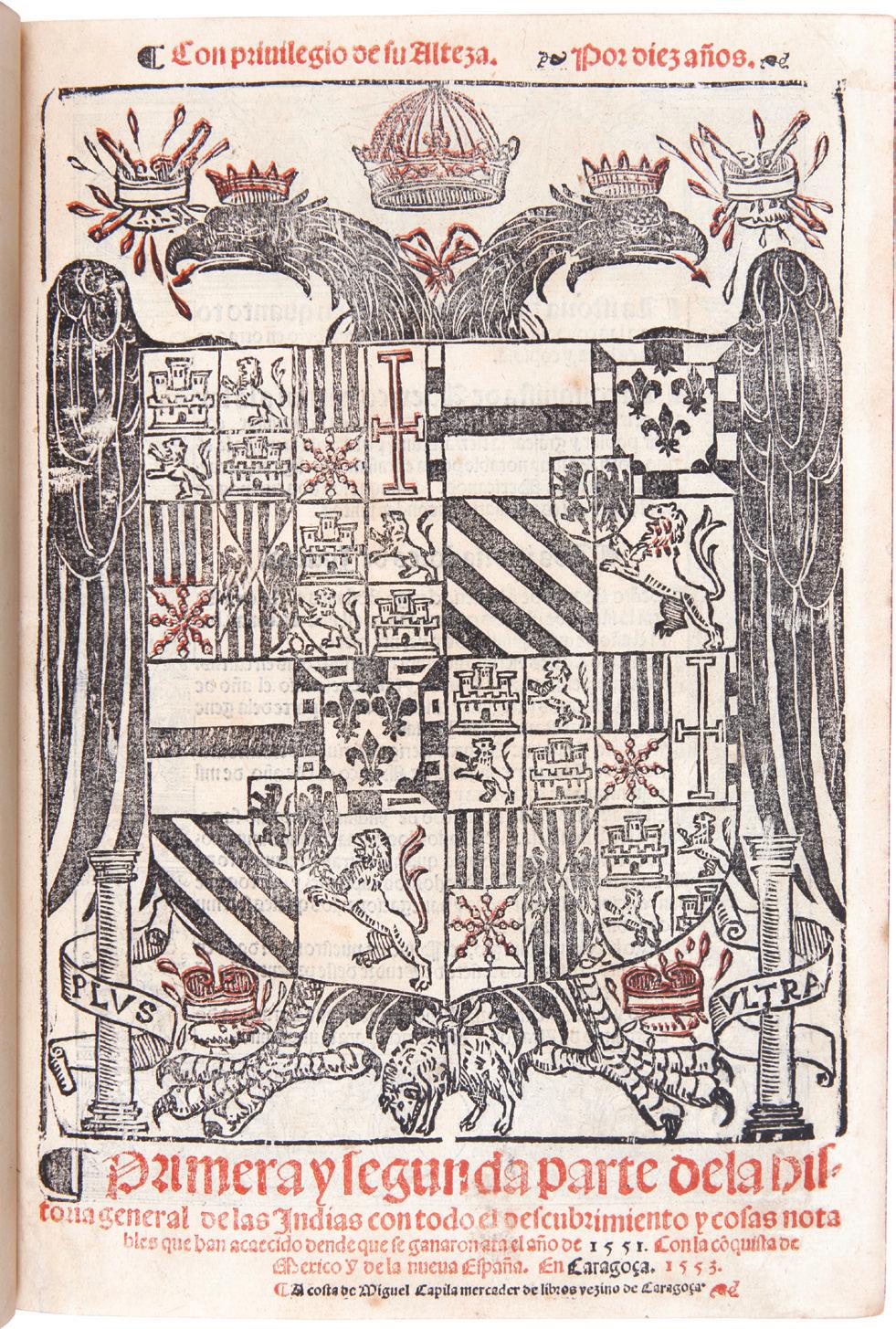
THE FIRST HISTORY OF MEXICO AND THE FIRST MENTION OF CALIFORNIA IN PRINT: EXCEEDINGLY RARE COMPLETE WITH THE MAPS
47. LÓPEZ DE GOMÁRA, Francisco. Primera y segunda parte dela historia general de las Indias con todo el descubrimiento y coas nota bles que han acaccido dende que se ganaron ata el ano de 1551. Con la co[n]quista de Mexico y de la Nueva Espana. Zaragoza: Agustin Millan, 1553.
Two parts in one volume. Folio (295 × 195 mm): π 4 a–z 4 A–G 4; a–z 4 A–M 4; [i–ii], iii–cxxii; [i]–cxxxix, [cxl] leaves. Two woodcut maps with folding extensions, woodcut illustration of a buffalo in first part. Title page printed in red and black with nearly full-page woodcut of the arms of Spain, woodcut border on verso of title page, near full-page woodcut arms of Cortés on Part II title page, decorative woodcut initials. Full red morocco by Lortic, gilt-ruled, spine gilt extra with raised bands, gilt inner dentelles, all edges gilt. Washed and pressed, extreme right margin of first title renewed, with some worming in gutter margin repaired. Blank margins of maps expertly extended, lower edge of both maps trimmed with minor loss to printed surface, some expert facsimile to the border; leaf lxxiii folded over and creased in right blank margin, with minor loss renewed; scattered minor worming or minor tears with a few reinstatement of letters. Overall very good.
An exceedingly rare work, critical to the history of the conquest, being the first printed history of Mexico and the first work to name California, and including the first Spanish map of the American continent, the first Spanish map of the west coast of America, and the first illustration of a buffalo.
THE DISCOVERY OF AMERICA 105
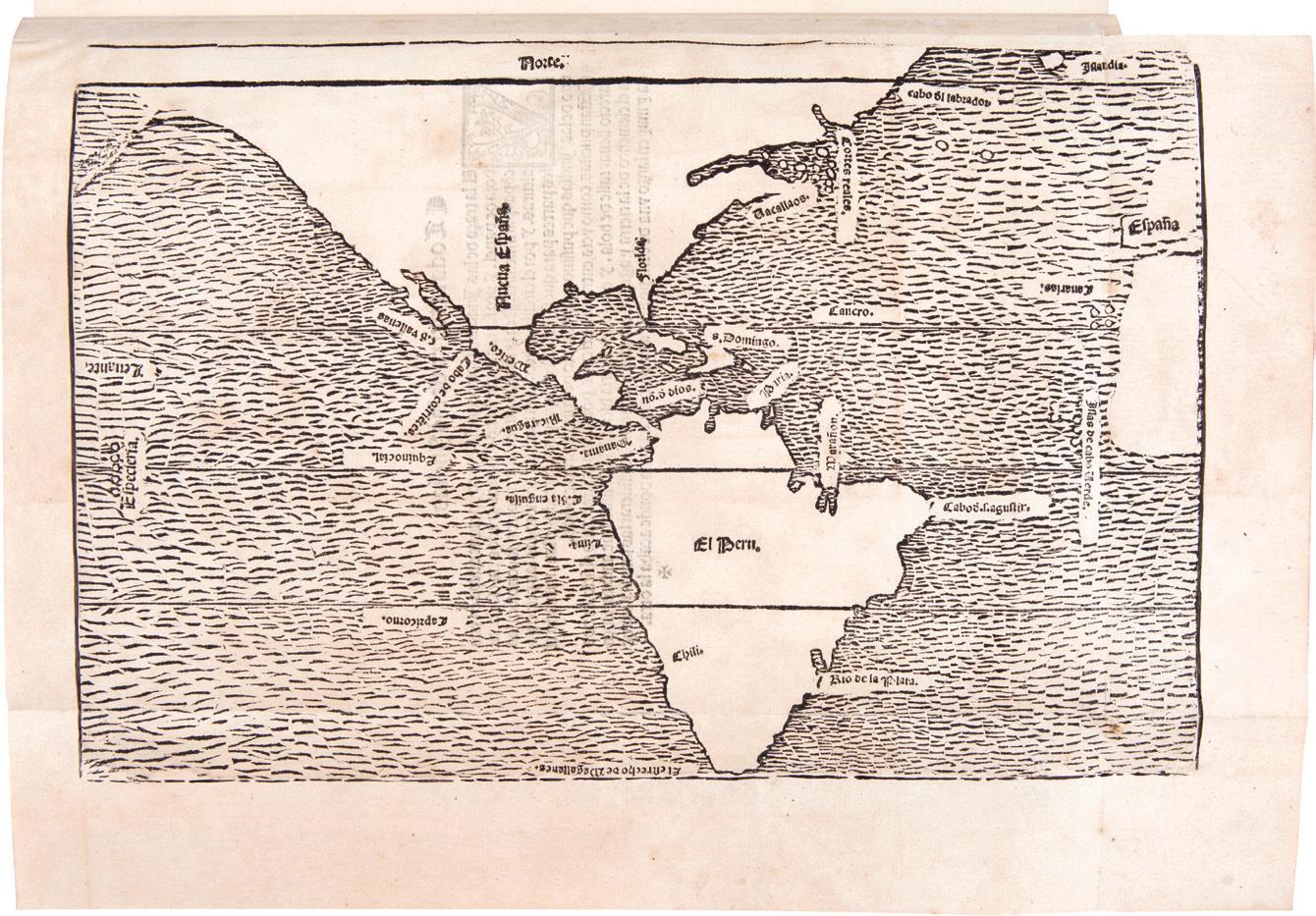

One of the most important early chronicles of the Spanish conquest of the New World, López de Gomára’s work is one of the two chief accounts of Cortés’s conquest of Mexico. He served as Cortés’s secretary and chaplain and made use of his position to gather information relating to the extraordinary exploits surrounding the overthrow of the Aztec empire. The dedication to Charles V begins with these remarkable words: “The greatest event which has happened since the creation of the world (leaving aside the incarnation and death of Him who created it) is the discovery of the Indies.”
“‘The two pillars, on which the story of the Conquest mainly rests, ’ wrote Prescott, ‘are the Chronicles of Gomara and Bernal Diaz’ . . . Gomara (1510–55) never visited the scene of his master’s glory, but when Cortés returned to Spain in 1540, the young cleric became his private chaplain and secretary . . . Gomara’s resulting Historia . . . is a eulogistic panegyric of his hero, which in consequence sorely galled the other participants of the conquest . . . Yet one cannot deny that, in spite of all its partiality, Gomara’s history is a good history; he derived his information from the highest sources and he wrote with an elegant brevity and sense of arrangement that contrasted favorably with the rambling incoherencies of many of his contemporaries” (Penrose).
The work is divided into two distinct parts, each with separate title. “The first part relates to the subjugation of Peru. The second part gives an account of the conquest of Mexico, and it is that portion of the work by which the author is best known. It was translated into most of the European languages, and was constantly reprinted during the sixteenth century” (Church). Besides the history of Peru, the first part comprises an account of the discovery of the Indies by Columbus and details on their geographic location.
The second part includes a biography of Cortés and accounts of his travels, as well as those of Francisco de Ulloa in 1539 to the Pacific coast of Mexico and Juan Rodri-
THE PARSONS COLLECTION 106
guez Cabrillo in 1542 along the coast of California. This part is particularly noted by Wagner and others for including the earliest mention of California (leaf cxvii verso), as well as information about the early history of the present southwest.
“Contains the first printed accounts of the Cortés expeditions to California, the expeditions of Francisco Ulloa, Marcos de Niza, Coronado, the subsidiary expeditions resulting from the last, and the voyage of Cabrillo” (Wagner). Sabin states that “the work is indispensable to the student of Spanish affairs in America after the conquest.”
Of particular importance in this copy is the presence of the woodcut maps on two sheets, portraying the old world (i.e. Asia, Europe, and Africa) and the new world (North and South America) respectively. The latter is the first Spanish map to depict the entire American continent and the first printed Spanish map to depict the west coast of America. “Despite the fact that the cartography is very simple with just a few place names, it does show a remarkably accurate west coast of North America . . . The map, particularly was suppressed to protect what is remarkably advanced knowledge of the outline of the New World” (Burden). The maps are lacking from nearly all extant copies.
All copies of the first edition are very rare in part due to an order of the Council of the Indies in 1554 to prohibit the book and to seize as many known copies as possible, though later editions nevertheless flourished. See Wagner for a lengthy discussion on the suppression of the work. This copy is from the second issue of the first edition, with the cancel title pages altering the date of publication from 1552 to 1553; the sheets are otherwise those of the first issue, with the same errors in foliation. Only a single complete copy of the first issue has been recorded, located at the John Carter Brown Library.
A work of the utmost rarity and importance, no copies have appeared at auction since 1967. Of the ten copies of this second issue recorded by the USTC, only four are in North America, at the New York Public Library, the Newberry Library, the University of Virginia, and Princeton. H. P. Kraus, in his Americana Vetustissima catalogue listed the last complete copy to appear in the marketplace (the Harmsworth copy), which he described as the only copy of this issue to appear in the market in the twentieth century.

Burden 18; Church 97; European Americana 553/30; JCB (3) I:175–176; Medina (BHA) 153; Palau 141135; Sabin 27724; Shirley, Mapping of the World 94; Wagner, Spanish Southwest 2a. Penrose, Travel and Discovery p. 295.
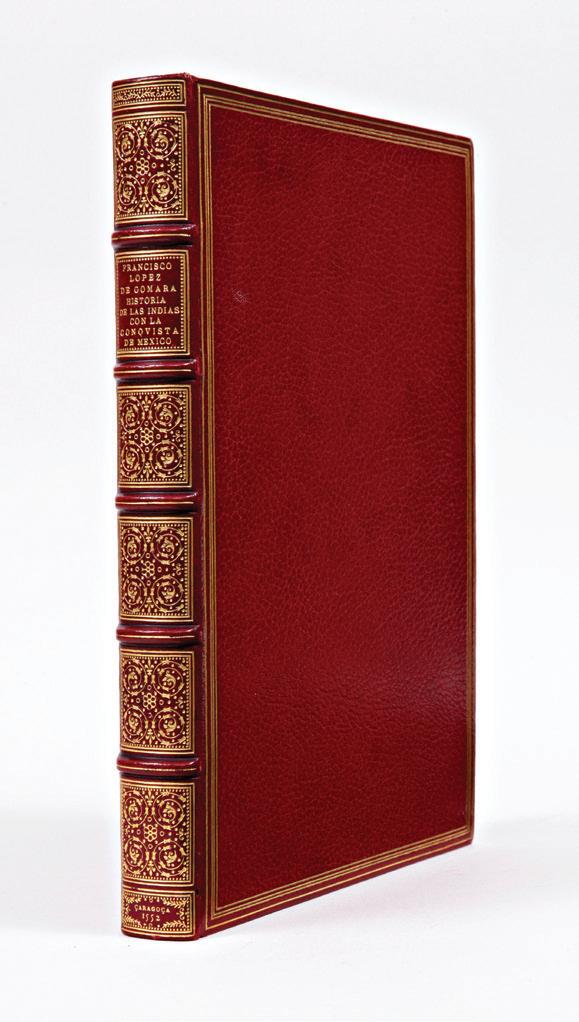
THE DISCOVERY OF AMERICA 107
SOLD
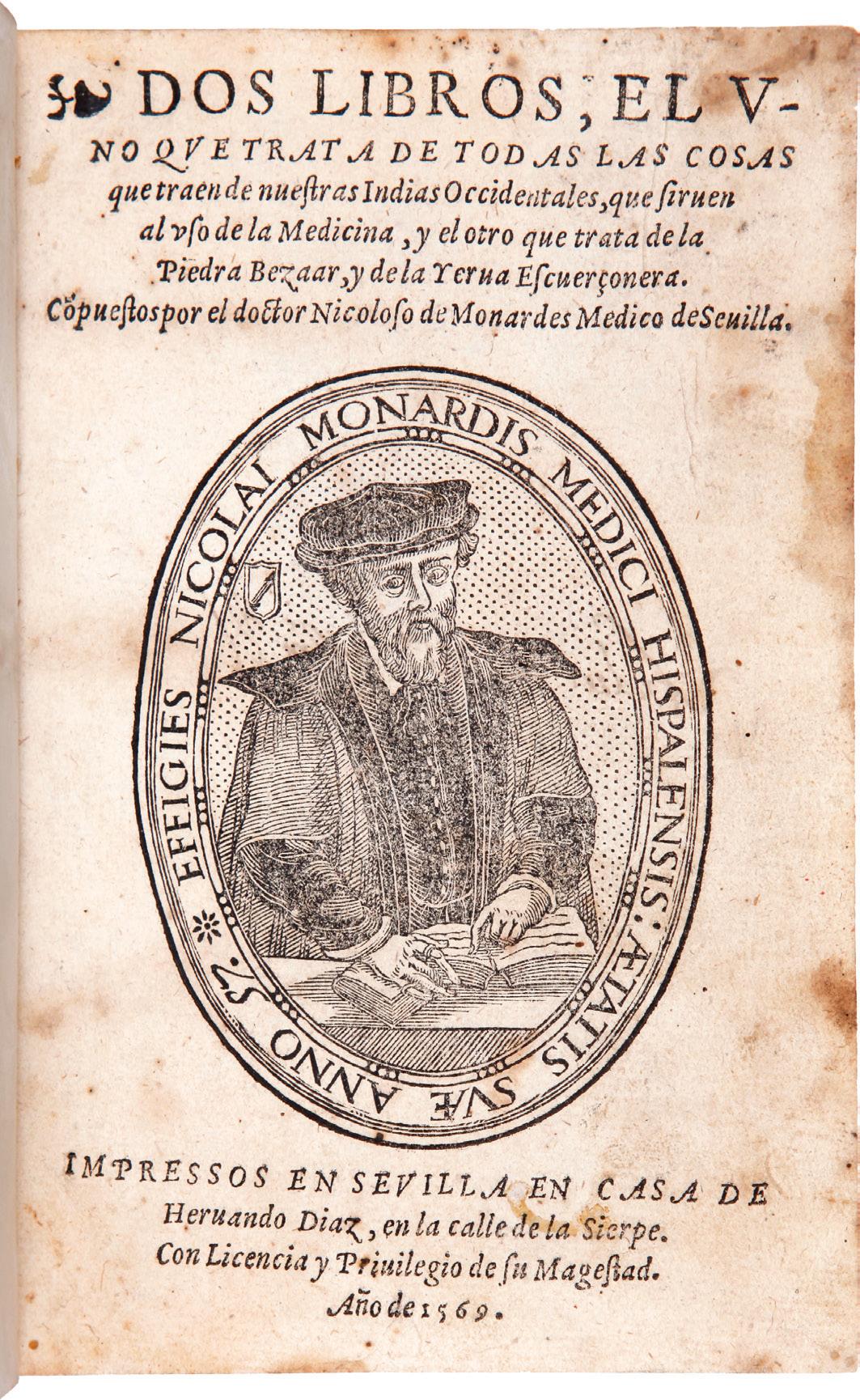

EARLY AND IMPORTANT NEW WORLD HERBAL
48. MONARDES, Nicolás. Dos libros, el uno que trata de todas las cosas que se traen de nuestras Indias Occidentales. Seville: Hernando Diaz, 1569.
Octavo (165 × 112 mm): A–R8 S4; [140] leaves, without additional “Tassa” leaf inserted between A2 and A3 as in some copies. Woodcut portrait of the author on title page. Eighteenth-century vellum over stiff boards, inked spine title. Tanned, light scattered staining and soiling. Early ownership inscription on title page verso. Provenance: Andres de V[asco?] C[astín?] (inscription).
The second edition of “the first treatise on Central American drugs, and for many years the most important work on the medicinal plants of the New World” (Garrison and Morton). As a leading physician in Seville, through which all of Spanish trade with the Americas had to pass, Monardes was in an ideal position to collect and study the plants and seeds of the New World, growing many in his own garden. This first volume, originally published in 1565 and reprinted here in 1569, was expanded by two editions printed in 1571 and 1574, which included additional plants and research, and are perhaps most notable for featuring “the first accurate drawing of a tobacco plant, presumably growing in his own garden” (Sauer, p. 819). Though he never visited America, Monardes was optimistic about the healing properties of her flora. Mechoacan, for example, is supposed to cure jaundice, gout, epilepsy, and syphilis, among others. Other plants discussed include coca, guaiac, sarsaparilla, and copal resin. The second of the Dos Libros is dedicated to the miraculous qualities of bezoar stones.
The first English edition of Monardes, translated by John Frampton and published in 1577 as Joyful Newes out of the Newe Found World (though erroneously credited to the Portuguese physician García d’Orta), proved immediately successful and was printed in three editions before the turn of the century, greatly contributing to the enduring influence of this book.
“The Historia, which instantly became a classic in the history of medicine, amounts to a true encyclopedia of the practical natural history of the area” (Delgado-Gomez, p. 57). A scarce and foundational New World botanical work.
European Americana 569/36; Garrison and Morton 1817; Guerra (Monardes) 8; Hunt 106; JCB (3) I:240; Medina (BHA) 207; Pritzel 6366; Sabin 49936. Angel Delgado-Gomez, Spanish Historical Writing About the New World 1493–1700, (Providence: John Carter Brown Library, 1992). Jonathan D. Sauer, “Changing Perception and Exploitation of New World Plants in Europe,” in Chiappelli, First Images of America Volume II (Berkeley, 1976).
$9,500
THE PARSONS COLLECTION 108
THE LIFE OF COLUMBUS
WRITTEN BY HIS SON: A MAJOR DOCUMENT OF COLUMBIAN DISCOVERY
49. COLUMBUS, Fernando. Historie del S. D. Fernando Colombo; nelle quali s’ha particolare, & vera relatione della vita, & de’ faiti dell’ Ammiraglio
D. Christoforo Colombo, suo padre. Venice: Francesco de’Franceschi Sanese, 1571.
Duodecimo (145 × 95 mm): a–b8 c4 A–2H8; [20], 247, [1] leaves. Contemporary vellum. Joints splitting at head, small hole in spine. Scattered foxing, tear to upper right corner of title page affecting 8 letters, supplied in pen facsimile. Otherwise a very nice copy. In a half morocco and cloth box with cloth chemise, spine gilt.
The first edition of the life of Christopher Columbus, written by his illegitimate son, Fernando, and translated into Italian by Alfonso Ulloa from the original Spanish manuscript. Fernando accompanied his father on his fourth voyage to the New World in 1502, and was witness to many of the events described in the text.
While the authenticity of this work was challenged by early commentators, modern researchers have increasingly found it an accurate source of information on many of the events of Christopher Columbus’s life. It is now generally considered “the most important of our sources of information on the life of the discoverer of America” (Vignaud).

“His work is an invaluable document, entitled to great faith, and is the cornerstone of the history of the American continent” (The English Catalogue, quoted in Sabin).
“Still remains the only source of information upon many events in the life of Columbus” (Church).
BM STC Italian, p. 190; Church 114; European Americana 571/8; JCB (3) I:244; LeClerc 138; Rich 47; Sabin 14674; Streeter Sale 22.

THE DISCOVERY OF AMERICA 109
SOLD

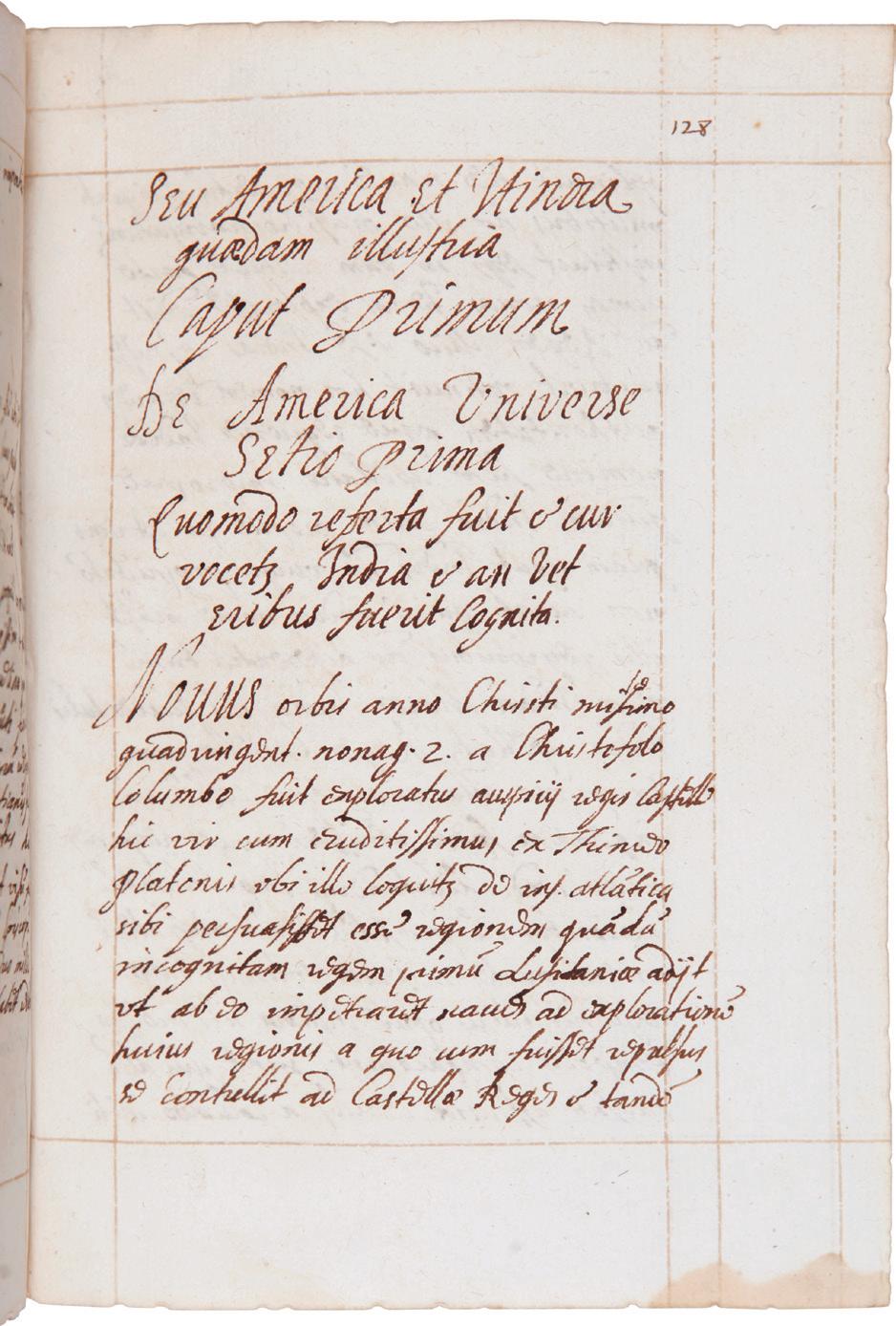
SIXTEENTH-CENTURY MANUSCRIPT ON THE GEOGRAPHY OF THE KNOWN WORLD, INCLUDING THE AMERICAS
50. PTOLEMAEUS, Claudius, after. Geographia intelligendis poetis et historicis acomodata [manuscript title]. [Italy or Spain:] 1580.
Manuscript on paper. Two parts in one. Small octavo (165 × 115 mm). Part I: 173 pp.; Part II: [63] pp. Written in brown ink in two different late sixteenth-century cursive hands, text within red rules throughout. Recased in contemporary limp vellum, smooth spine lettered in early manuscript and divided by gilt fillets, small gilt tolls with bird within oval border in compartments, covers ruled in blind, large oval foliated centerpieces, gilt flowers at corners, evidence of red silk ties, edges gilt and gauffered. Some natural creasing and discoloration to vellum, extremities rubbed with occasional spots of wear, large portion of lower corner of rear cover sometime restored with later vellum, traces of circa eighteenth-century marbled paper visible behind pastedowns, small damp stain to lower margin of contents, else generally clean. A very good example. Provenance: Jean-Charles Ledesma de Saint-Élie, with his Latin and French manuscript ownership inscription “Johannes Carolus Ledesma, bibliothèque de St Elia” on the front pastedown (Ledesma was a French soldier, knight of Saint-Louis in 1761, and general aide-major in the Seven Years War).
An unpublished sixteenth-century Latin manuscript on the geography of the known world, collecting reflections on the discovery of the Americas, the voyages of Columbus, Vasco da Gama, and Magellan. The last pages contain a series of exercises in philosophy.
THE PARSONS COLLECTION 110
The first section of the book is written in a charming late sixteenth-century humanistic cursive hand, which can be dated between 1580 and the very early 1600s. The characteristics of the hand and ornaments of the binding suggest an Italian or Spanish production of the manuscript. The second section is in a different hand but datable to the same time period and was written at a later time on the blank pages at the rear of the volume.
The geographical text is divided into five books, each containing several chapters and subchapters. The first book is an introduction on the structure of the universe, describing the planets, presenting the concepts of longitude and latitude, and then focusing on Earth (its shapes, dimensions, geography). The remaining four books are dedicated to Earth’s main geographical areas: Europe (book II); Africa (III); Asia (IV), including India, the islands of the Indian Ocean, and Japan; and America (V).
The text is mostly based on Ptolemy’s Geographia, the foundation of many Renaissance works of this genre. The ethnographical sections, describing the customs and rituals of the peoples living in the different regions, contain references to Johannes Boemus, whose popular Omnium Gentium Mores, was first published in 1520.
The particular interest towards America is anticipated in the introduction, in which the author attacks the notion reported by ancient sources that the world is divided in only three parts (Europe, Africa, and Asia) and adds America as the fourth. The description of America in book IV begins with an account of its discovery by Columbus, then includes paragraphs on “Terra Laboratoris” (Newfoundland), “Bacalearum regio” (coast of Labrador), Florida, Mexico, Peru, Chile, and Brazil.
The work terminates with notes on famous classical journeys, including the travels of Solomon, Saint Paul, Aeneas, Jason and the Argonauts, and Alexander the Great. These are followed by accounts of more contemporary voyagers: Columbus is discussed in a lengthy three and a half pages, Vasco da Gama has a similarly lengthy passage, while Magellan earns two pages.
The philosophical text contains a series of responsiones (responses) and obiectiones (objections) concerning philosophical problems, chiefly in logic and physics. The text of the responses and objections appears on opposite pages, so that the respective arguments can be easily compared. One of the problems concerns the nature of logic, whether it must be considered a purely speculative or purely practical discipline. Also included is a short chronology of the events from 1 to 44 ce. $9,500

THE DISCOVERY OF AMERICA 111
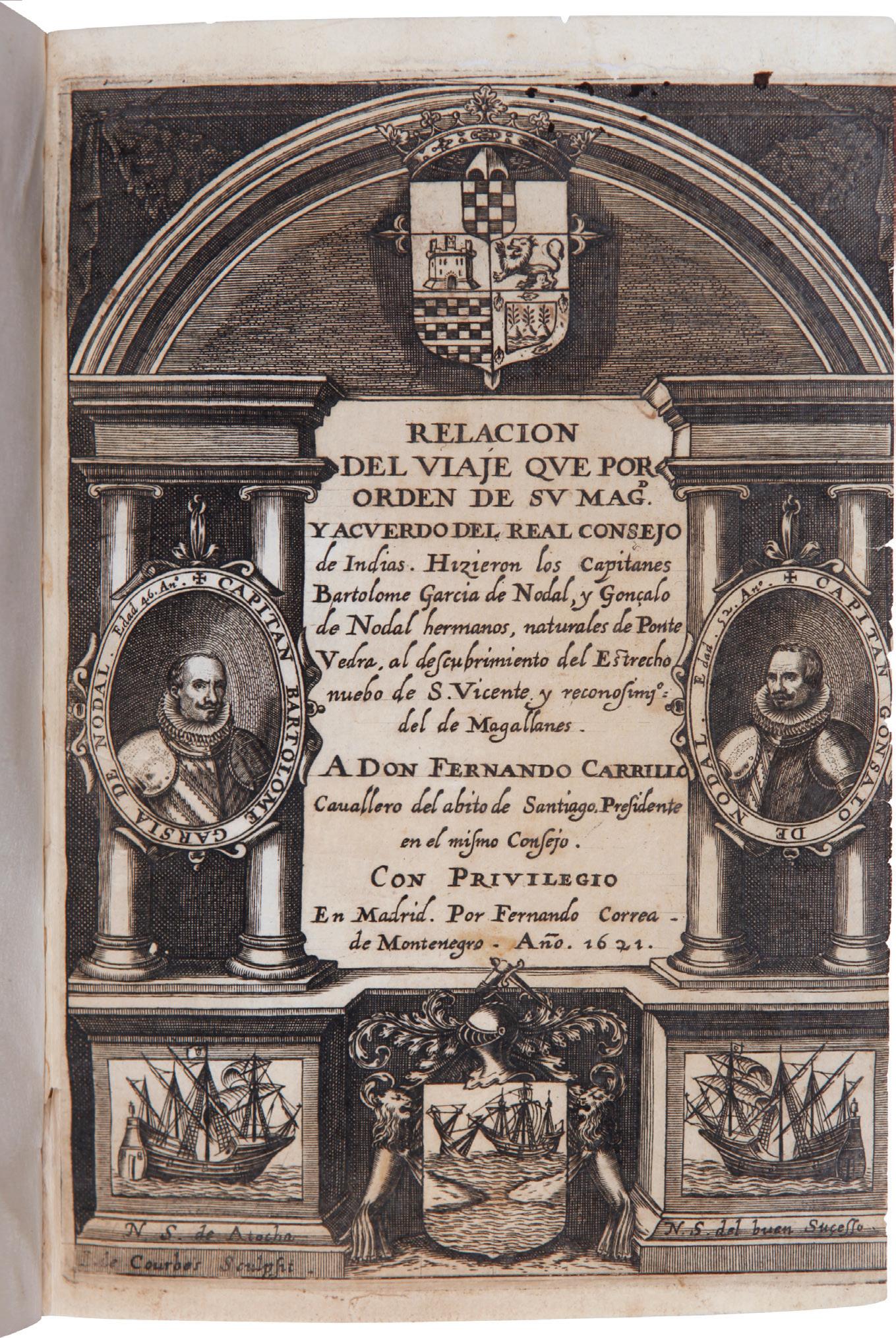
EARLY PACIFIC VOYAGE AND EXPLORATION OF THE TIP OF SOUTH AMERICA
51. NODAL, Bartolomé García de and Gonçalo de. Relacion del viaje que por orden de Su. Mag[esta]d. y Acuerdo del Real Consejo de Indias, al descubrimiento del Estrecho nuevo de S. Vicente y reconosimiento del de Magallanes. Madrid: Fernando Correa de Montenegro, 1621.
Small quarto (200 × 145 mm): ¶–3¶4 A–H8 a–b8; [12], 65, 15 leaves. Lacking terminal blank b8 and folding map, as usual. Engraved title page, woodcut coastal profiles in text. Contemporary manuscript notes, including calculations, on endpapers and rear pastedown. Contemporary limp vellum, vellum ties still present, early manuscript lettering and decoration on spine. Vellum lightly soiled. Spanish sealed paper with “sello quarto” stamp dated
THE PARSONS COLLECTION 112
1747 used as endpapers. Small split to upper platemark and lower blank margin of title, outer edge of image slightly shaved. Light tanning. Provenance: Contemporary Spanish ownership inscription on verso of title page: “del Convento del carmen de Bujalanze” (“from the convent del Carmen of Bujalance”, in the province of Cordoba, Spain); related ownership inscription of one Friar Juan on leaf E2 and last page. Later inscription of one Francisco Madueno on last page.
First edition of this account of the expedition sent out by Philip III for the exploration of the extreme south of America: “one of the rarest books of its class” (Sabin).

Alarmed to learn that the Schouten-Le Maire expedition of 1616 had rounded Cape Horn and entered the Pacific from the Atlantic, the Spanish king sent the Nodal brothers in 1618 to examine the Le Maire strait and study the possibility of maintaining control over this new passage. With the cosmographer Diego Ramírez de Arellano Chamás serving as pilot, the Nodals passed around the Horn through Le Maire’s strait, turned northward, and sailed back to Spain via the Strait of Magellan, thus circumnavigating Tierra del Fuego for the first time. En route, they discovered the Diego Ramírez Islands, for 150 years the southernmost land reached by European explorers. They returned to Spain with accurate observations of the tides in the Strait of Magellan and precise sailing instructions for the area. The expedition was orchestrated by the government of the United Kingdom of Spain and Portugal, and the crew was composed entirely of Portuguese prisoners or men taken by force, as it would have been impossible to recruit volunteers for such a perilous journey. The text contains an excellent description of the natives of Tierra del Fuego in 1616, and the earliest printed account of the Onas of Good Success Bay. The three woodcuts are elementary profiles of islands and capes.
Borba de Moraes states that “copies containing the map are so rare that it is believed to have been withdrawn,” in keeping with the official Spanish policy of secrecy regarding the Padrón Real. “This first edition, particularly with the map, is very rare and in fact is considered one of the rarest travel books of the seventeenth century . . . [The book] is of great value as a work of navigation” (Borba de Moraes).
Borba de Moraes, p. 616; Church 386; European Americana 621/90; Hill 1231; JCB (3) II:156; Medina (Hispano-Chile) 50; Palau 99485; Sabin 55394; Streeter Sale 35.
$32,000

THE DISCOVERY OF AMERICA 113


FIRST EDITION OF ONE OF THE FIRST WORKS ON THE DISCOVERY OF THE WEST INDIES, ORIGINALLY WRITTEN IN 1523–24
52. GERALDINI, Alexander. Itinerarium ad regiones sub aequinoctiali plaga constitutas. Opus antiquitates, ritus, mores, & religiones populoru[m], Aethiopie[a], Africae, Atlantici Oceani, Indicarumque regionum complectens. Rome: Guilelmi Facciotti, 1631.
Octavo (167 × 112 mm): ✠8 a8 b4 A–V 8; [40], 284, [36] pp. Engraved additional title page, engraved printer’s device on the title. Early limp vellum, manuscript spine title. Chipping to spine extremities, endbands loose. Signature K somewhat tanned, else internally clean. Provenance: HW (booklabel).
A primary account of the earliest period of American discovery by the first bishop of St. Domingue, first published here more than a hundred years after it was written. Taken from a manuscript originally written in 1523–24 by this friend and companion of Columbus, this is one of the earliest written descriptions of the discovery and condition of the West Indies and provides a detailed description of native people, their habits, language and history.
It was Geraldini’s support of Columbus’s argument for a spherical globe that enabled Columbus to be heard by the official council charged with evaluating his proposed
THE PARSONS COLLECTION 114
voyage. Later, Geraldini, the tutor of Catherine of Aragon, went to Santo Domingo as the new see’s first bishop, and the present text includes an account of his voyage and a description of the island. He writes that the native race has nearly been extinguished and that he is sending back to Europe two turkeys. His original manuscript was composed in 1523, thus his work precedes that of Oviedo and supplants the great explorer as the first European writer to mention the turkey.
“A very scarce and curious volume on the discoveries of the West Indies, written in 1524. Its writer was the intimate friend of Columbus, the one whose interest prevailed over Ferdinand to fit out the first expedition in search of unknown lands, and proved the feasibility of the discovery by mathematical demonstration” (Sabin). This example is one of a few copies complete with the often-lacking additional preliminary leaves, not noted by Sabin or JCB, of verses in commendation of the author and his travels by various writers, in Greek, Latin, Italian, French, German, Spanish, Hungarian, and English (the latter written by John Walker). Very rare thus.
BMC I 386; Brunet II, 1545; European Americana 631/43; JCB (3) II:236–37; Medina (BHA) 890; Sabin 27116; Streit II:1600.
$15,000
ONE OF FIVE COPIES MADE FOR HENRY STEVENS OF VERMONT
53. COLUMBUS, Christopher. Eyn schön hübsch Lesen von etlichen Insslen die do in kurtzen Zyten funden synd durch den Künig von Hispania, und sagt von grossen wunderlichen Dingen die in den selben Insslen synd. Strassburg: Bartholomaeus Kistler, 30 September 1497 [i.e. London: mid-nineteenth century facsimile by John Harris].
Quarto (206 × 144 mm), [7] leaves, lacking the final blank. Illustrations. Nineteenth-century brown morocco, panelled in blind and gilt, spine gilt with raised bands, marbled endpapers, all edges gilt. Chip at head of spine, spine a bit darkened, minor wear at extremities. Light foxing and browning, minor chipping at lower edge of the front endpaper. Provenance: The Century Association, presented by James Lorimer Graham (bookplate on front pastedown); Wolfgang A. Herz (booklabel, his sale, Christie’s December 9, 2009, lot 206).
The noted John Harris (1791–1873) facsimile of the first German translation of the first Columbus letter. According to Henry Stevens, this facsimile was made on his behalf by Harris from the original in the Grenville Library. Only five copies (elsewhere Stevens cites “half dozen”) were made lithographically before the work was erased from the stones. “Five copies of this extremely rare tract were made by the elder Mr. Harris with such exactness, that it requires an expert to detect it from the original” (Sabin). “Mr Harris is not so much distinguished as an artist as he is famous for his wonderful facsimile reproductions of early wood-engraving and block-printing to supply deficiencies in imperfect books” (Cowtan, Memories of the British Museum, London, 1872).
The German translation, from notary Leander de Cosco’s Latin rendering printed in Rome by Stephan Plannck in 1493, is among the rarest of the early editions of the first Columbus letter announcing the discovery of the New World.
$5,000

THE DISCOVERY OF AMERICA 115
references cited
Adams, H.M. Catalogue of books printed on the continent of Europe, 1501-1600, in Cambridge libraries
Arents = Tobacco: a catalogue of the books, manuscripts, and engravings acquired since 1942 in the Arents Tobacco Collection at the New York Public Library, from 1507 to the present
Beinecke Lesser Antilles Collection at Hamilton College: A Catalogue of Books, Manuscripts, Prints, Maps, and Drawings, 1521-1860, eds.
Hough, S.J. and R.R.O.
Bell = James Ford Bell Library, An Annotated Catalog of Original Source Materials Relating to the History of European Expansion, 1400-1800
Benzing, Josef. Ulrich von Hutten und seine Drucker
BM STC Italian = Short-title catalogue of books printed in Italy and of Italian books printed in other countries from 1465 to 1600 now in the British Museum
BMC = Catalogue of books printed in the XVth century now in the British Museum (1963-1971 ed.)
Bod-Inc = Catalogue of books printed in the fifteenth century now in the Bodleian Library, Oxford
Borba de Moraes, Rubens. Bibliographia brasiliana
Brunet, J.-C. Manuel du libraire et de l’amateur de livres (5e éd.)
BSB-Ink = Bayerische Staatsbibliothek Inkunabelkatalog
Burden, P.D. Mapping of North America
Campbell, M.F.A.G. Annales de la typographie néerlandaise au XVe siècle (1962 ed.)
Church, E.D. Catalogue of books relating to the discovery and early history of North and South America
Cordier, Henri. Bibliotheca Japonica
Cox, E.G. Reference guide to the literature of travel
DSB = Dictionary of Scientific Biography
Essling, Victor Masséna, prince d’. Bibliographie des livres à figures vénitiens de la fin du XVe siècle et du commencement du XVIe, 14691525
European Americana: a chronological guide to works printed in Europe relating to the Americas, 1493-1750, ed. John Alden assisted by Dennis C. Landis
Field, T.W. Essay towards an Indian bibliography
First Images of America: The Impact of the New World on the Old, eds. Fredi Chiappelli, Michael J.B. Allen, and Robert L. Benson
Garrison and Morton = Garrison, F.H. Medical bibliography (3rd ed.)
Goff, F.R. Incunabula in American libraries
Guerra, F. American medical bibliography, 1639-1783
GW = Gesamtkatalog der Wiegendrucke
Hain = Hain, L. Repertorium bibliographicum
Harrisse (BAV) = Harrisse, H. Bibliotheca Americana Vetustissima: a description of works relating to America published between the years 1492 and 1551
Harvard French Sixteenth Century Books = Harvard College Library. Catalogue of books and manuscripts. French 16th century books
HC = Copinger, W.A. Supplement to Hain’s Repertorium bibliographicum
Hill collection of Pacific voyages: at the University of California, San Diego
Hunt = Catalogue of botanical books in the collection of Rachel McMasters Miller Hunt
Hutch Catalogue = Catalogue of the Hutch Collection of Printed Books & Illuminated Manuscripts, Sotheby, Wilkinson & Hodge, London, 1911-13
Huth Catalogue = Catalogue of the famous library of printed books, illuminated manuscripts, autograph letters and engravings collected by Henry Huth
IGI = Indice generale degli incunaboli delle biblioteche d’Italia
ISTC = British Library. Incunabula Short Title Catalogue
JCB = Bibliotheca Americana: catalogue of the John Carter Brown Library in Brown University, Providence, Rhode Island
King Manuel = Maggs Bros. Catalogue of a collection of early Portuguese books 1489-1600 in the library of His Majesty the King of Portugal
Klebs, A.C. Incunabula scientifica et medica
Laures, J. Kirishitan Bunko: a manual of books and documents on the early Christian Missions in Japan
Leclerc, C. Bibliotheca Americana: histoire, géographie, voyages, archéologie et linguistique des deux Amériques et des îles Philippines
Martín Abad, J. Imprenta en Alcalá de Henares, 1502-1600
Medina (BHA) = Medina, J.T. Biblioteca hispano-americana (14931810)
Medina (Filipinas) = Medina, J.T. Bibliografía española de las Islas
Filipinas (1523-1810)
Medina (Hispano-Chile) = Medina, J.T. Biblioteca hispano-chilena (1523-1817)
Nissen, C. Zoologische Buchillustration
Nordenskiöld = The A.E. Nordenskiöld Collection: annotated catalogue of maps made up to 1800
Oates, J.C.T. A catalogue of the fifteenth-century printed books in the University Library Cambridge
Ortroy, F. van. Bibliographie de l’oeuvre de Pierre Apian
Palau y Dulcet, A. Manual del librero hispano-americano
Palmer, P.M. German works on America, 1492-1800
Panzer, G.W. Annalen der älteren deutschen Literatur
Phillips Atlases = List of geographical atlases in the Library of Congress
Portugal-Brazil: The Age of Atlantic Discoveries, eds. Max Justo
Guedes and Gerald Lombardi
Proctor, Robert. An index to the early printed books in the British Museum from the invention of printing to the year MD, with notes of those in the Bodleian Library
Printing and the Mind of Man (2nd ed.)
Pritzel, G.A. Thesaurus literaturae botanicae omnium gentium (18721877 ed.)
Reese & Miles, Creating America = Creating America: An Exhibition at the Beinecke Rare Book & Manuscript Library, Yale University, curated by William S. Reese and George A. Miles
Renouard, A.A. Annales de l’imprimerie des Estienne
Rhodes, D.E. Catalogue of incunabula in all the libraries of Oxford University outside the Bodleian
Rich, Obadiah. A catalogue of books, relating principally to America, arranged under the years in which they were printed
116
Ritter, F. Catalogue des livres du XVIe siècle ne figurant pas à la Bibliothèque nationale et universitaire de Strasbourg
Rodrigues, J.C. Bibliotheca brasiliense
Rogers, Europe Informed = Europe Informed. An exhibition of early books which acquainted Europe with the East, curated by Francis M. Rogers
Rosenbach = The Collected Catalogues of Dr. A. S. W. Rosenbach
Sabin, J. Dictionary of books relating to America from its discovery to the present time
Sander, M. Livre à figures italien depuis 1467 jusqu’à 1530
Sanz, Carlos. Bibliotheca Americana Vetustissima; ultimas adiciones
Servies, J.A. and L.D. Bibliography of Florida, 1507-1845
Shirley, British Isles = Shirley, R.W. Early printed maps of the British Isles, 1477-1650 (1991 ed.)
Shirley, Mapping of the World = Shirley, R.W. Mapping of the world (4th ed.)
Stevens, H. Historical nuggets: Bibliotheca Americana, or A descriptive account of my collection of rare books relating to America
Stevenson, Edward Luther. Terrestrial and Celestial Globes: their history and construction
Streeter, Americana-Beginnings = Americana-Beginnings: a selection from the library of Thomas W. Streeter, shown in honor of a visit of the Hroswitha Club on May 3, 1951
Streeter Sale = The celebrated collection of Americana formed by the late Thomas Winthrop Streeter, Morristown, New Jersey
Streit, R. Bibliotheca missionum
Ternaux-Compans, Henri. Bibliothèque Americaine, ou catalogue des ouvrages relatifs à l’Amérique depuis sa découverte en 1493, jusqu’en l’an 1700
TPL = Staton, Frances M. and Marie Tremaine. A Bibliography of Canadiana, being items in the Public Library of Toronto, Canada, relating to the early history and development of Cananda
VD16 = Verzeichnis der im deutschen Sprachbereich erschienenen
Drucke des 16. Jahrhunderts
Wagner, H.R. Spanish Southwest, 1542-1794
Walsh = Catalogue of the fifteenth-century printed books in the Harvard University Library, ed. Walsh, J.E.
World Encompassed: an exhibition of the history of maps held at the Baltimore Museum of Art, 1952
Yarmolinsky, A. Early Polish Americana
Zinner, Ernst. Geschichte und Bibliographie der astronomischen Literatur in Deutschland zur Zeit der Renaissance
our upcoming catalogue
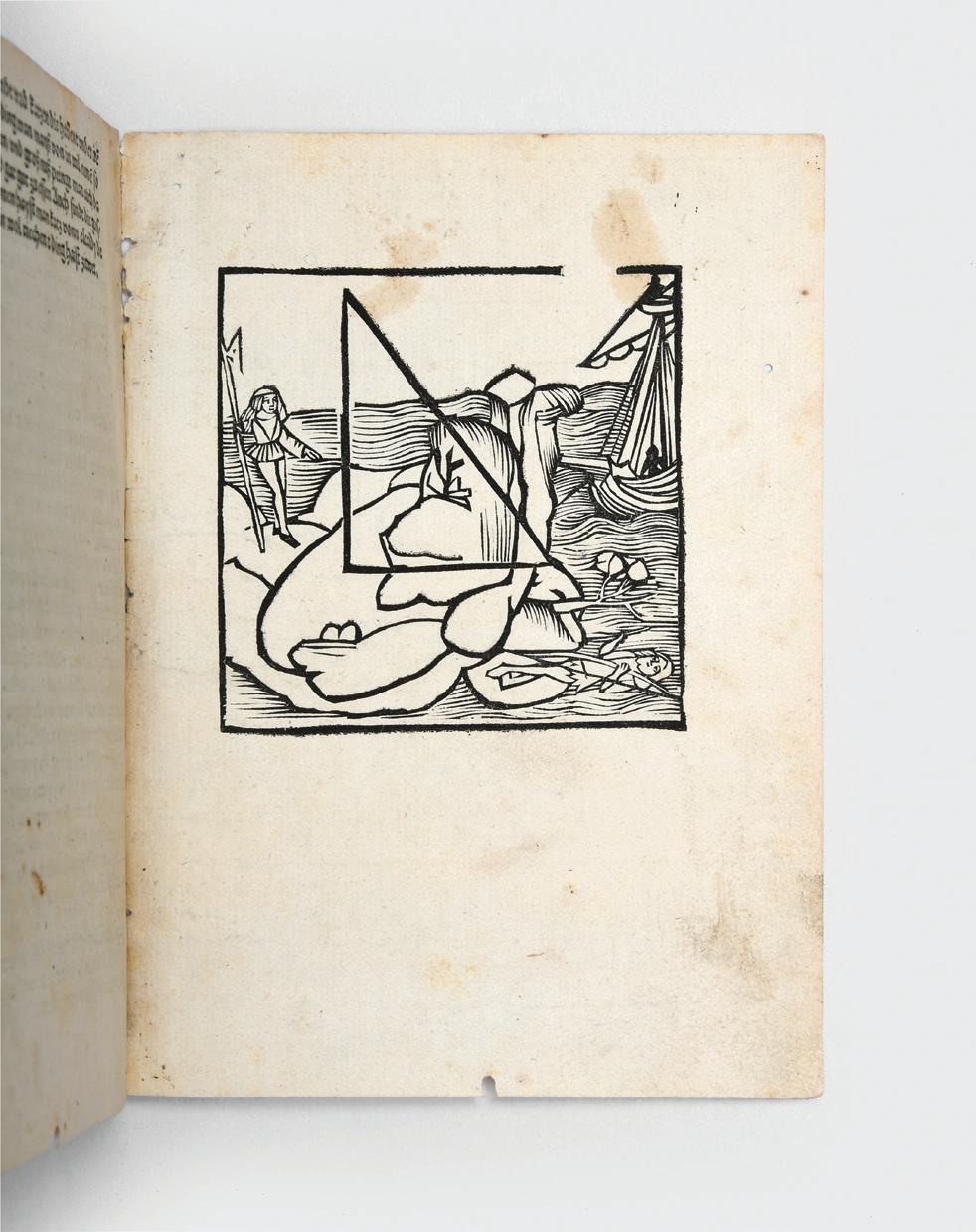
117 CBP024015
THE DISCOVERY OF AMERICA THE PARSONS COLLECTION


THE PARSONS COLLECTION 118
William Reese Company
ASSOCIATION WITH
Peter Harrington london
IN
















































































































































